

The Ultimate One Day in Volcanoes National Park Itinerary
Last Updated on July 25, 2023
by Audrey Webster
Disclaimer: This article contains affiliate links. That means if you click a link and make a purchase, we may make a small commission. As an Amazon Associate we earn from qualifying purchases. For more information, see our privacy policy.

Planning an itinerary for Hawaii Volcanoes National Park is one of the top things to do when mapping out a trip to the Big Island of Hawaii.
The park spans about 523 square miles and is home to two of the world’s most active volcanoes. Kilauea is one of the most active volcanoes in the world while Mauna Loa is the world’s largest shield volcano. During your visit to Volcanoes National Park, you’ll explore the lush and diverse ecosystems created by volcanoes.
Table of Contents
How Many Days in Volcanoes National Park?
You’re most likely visiting Hawaii Volcanoes National Park as part of a larger Big Island itinerary . However, you might still be wondering how much time do you need here? Most visitors would recommend one to two days.
In one day, you can drive the main roads inside the park and catch its major highlights. If you stay the night nearby, you can also opt for a tour after dark for stargazing and seeing bright orange lava flow.
With a little extra time, you can check out more of the park’s trails or head out toward the coastline to find unique rock formations from volcanic eruptions long ago.
The itinerary below is ideal if you have one day in Hawaii Volcanoes National Park. We’ve also included some suggestions for places to check out if you have a little more time to spare.

Getting To & Around Volcanoes National Park
It’s best to visit Volcanoes National Park as a day trip from Hilo or a smaller town just outside the park. The drive from Hilo to the park entrance takes about 45 minutes though you can also stop here on the way from Kona to Hilo.
If you’re staying in Kona, a day trip into the park is a long day, with nearly two hours of driving on either end. However, if you want to make a day of visiting the Southernmost Point in the United States or the black sand beaches on the southern tip of the Big Island, this route works well.
There is one entrance to Hawaii Volcanoes National Park and three main roads to get around, which makes navigating the park easy. A 7-day pass for one vehicle is $30, unless you already have an America the Beautiful Pass for $80 per year.
While there are tours such as this small group tour and this private tour from both Kona and Hilo , it’s ideal to have your own vehicle. Odds are you’ll rent a car for at least a portion of your Big Island visit, so try to time your tour of Volcanoes National Park accordingly. You can browse Rentalcars.com to compare car hire prices.
There is lodging available in the park, but it tends to be more expensive than staying outside it – Hilo makes an excellent base. However, if you’re doing a night tour , spending one night inside the park might be desirable.

1-Day Volcanoes National Park Itinerary
Make sure to take your time exploring the park — it’s truly loaded with natural wonders that you’ll see in few other places.
Stop at the Volcanoes National Park Visitors Center
Because of where you enter the park, you’ll most likely stop at the Kilauea Visitors Center. It’s right next to the entrance and it’s highly recommended you stop in upon arrival.
The Visitor Center has educational displays covering the geological history of the land. Between interactive exhibits, short movies, and artefacts, it’s a great way to welcome yourself to the national park.
Here, you can also check in with park rangers to see which parts of the park are open or closed. Due to its being an active volcano, you might encounter periodic closures or reroutes due to volcanic activity.

See the steam vents and sulphur banks
You’ll stop at the sulphur banks first. They are a short hike from the Visitor Center. It’s a loop trail — one mile out and back route from the Visitor Center parking lot.
Make sure you stay on the trail, especially as it changes to an elevated boardwalk, because volcanic gases and liquids rise from the surface. As you begin to smell rotten eggs, you’ll know you’re quickly approaching the sulphur banks.
The steam vents are located a few-minute car ride away from the Visitor Center. Head down the Crater Rim Road to stop near Steaming Bluff. You’ll quickly spot the large holes in the ground where steam spills out. There is a metal railing that surrounds the vents. Like the sulphur banks, it smells terrible here.
Check out Kilauea from the overlook
Once you’re back to the car, drive west along the Crater Rim Drive until you reach the Kilauea Overlook. The volcano started erupting again as recently as 2021. It’s easy to spot steam rolling up from the crater.
Here is one of the places where you can see the “night glow” of lava after dark. This is one of the most impressive sights you’ll see in the park. If you want a closer look, consider bringing a pair of binoculars.
Note that most of the Crater Rim Drive isn’t open to visitors at this time (July 2023), so you’ll have to turn back from the overlook to head toward your next destinations for your one day in Volcanoes National Park.
Visit the lava tree molds
Lava tree molds form when lava from an eruption gathers around the trunks of trees, destroying the tree and leaving behind a hardened mold of the plant.
Over time, these columns of solidified lava have become staples of the landscape, and offer visitors a glimpse into the landscape that existed before the volcano’s major eruptions.
The most impressive tree molds are near Highway 11 on the Mauna Loa Road.

Hike Devastation Trail
If you’re to do one or two shorter hikes in Volcanoes National Park, make sure one is the Devastation Trail. This short and paved trail crosses the lava field created from the 1959 Kilauea eruption. You’ll see first-hand how natural spaces start to recover after such cataclysmic events.
Keep an eye out for unique lava features like spatter effects and small glass-like lava called Pele’s hairs and tears.
You’ll park at the Devastation Trail trailhead located near the turn-off for the Chain of Craters Road. The trail itself is easy. It’s wheelchair and stroller accessible as it’s an entirely paved trail. It’s a short one-mile round-trip hike, but make sure you bring proper walking clothes and shoes.
A hat to protect yourself from the sun and sunscreen is also highly recommended. There is little-to-no shade along the route and it can be hot, dry, and windy depending on the time of day you visit. Doing the hike in the morning, when it’s cooler temperatures and fewer hikers, could be a good option.
Walk through the Thurston Lava Tube
The Thurston Lava Tube is hands-down one of the highlights of a Volcanoes National Park itinerary. This underground lava tube was formed when magma pushed its way from the volcano, carving a perfectly round and smooth tunnel. You can enter the tube from either side and walk all the way through.
Follow a short trail to arrive at the entrance. It’s wise to wear sturdy shoes during your visit as the ground within the tunnel can be uneven in places. You should also consider bringing a flashlight. The tunnel is lit by artificial lights from 8am to 8 pm, but there are still dark patches.
Keep in mind that visiting midday tends to be the busiest for the Thurston Lava Tube. We recommend you try to time your visit first thing in the morning or mid-afternoon, depending on the direction you plan to explore the park.

Stop at the Keanakakoi Overlook
If you’re on a mission to spot active lava during your visit, you won’t want to miss Keanakakoi Overlook. The crater was most likely formed during an eruption of Kilauea during the 1400s. Due to eruptions in 2018, part of the road to reach the overlook was destroyed.
An old portion of the Crater Rim Drive is open for foot traffic or bicyclists. Park at the trailhead parking lot for Devastation Trail and walk one mile along the road to reach the overlook.
Do an evening tour
If you’ve done any reading about visiting Volcanoes National Park, you’ve probably heard about “night glow”. This phenomenon can only be experienced once the sun has gone down.
Head to Kilauea Overlook, or you can reserve a tour , to catch a glimpse of the lava glowing within the Halema’uma’u Crater. It’s a stark contrast to how the crater appeared during the day time. Light from the lava of this active volcano illuminated with vog (volcanic smog) and clouds above the crater.
Stick around a little longer for stargazing. You’ll have to venture away from the glow of Kilauea. The Mauna Loa Lookout or Hilina Pali Overlook are two excellent options for where to see the stars.
Without light obstruction from nearby towns, you’ll witness a night sky filled with twinkling little stars. Make sure to wear good shoes and pack a few extra layers. A flashlight or headlamp could also be helpful to have on hand.
Have More Time?
Should you have some more time on your Hawaii Volcanoes National Park day trip, or you’re spending more than one day exploring the park, head out on the Chain of Craters Road.
The turn-off from the Crater Rim Road is just before the Thurston Lava Tube. This road takes you out to the coastline for spectacular views. It takes about 30 minutes to drive one way, so make sure you budget 1-2 hours for driving and stopping to see the sites.
Your first stop, or last stop on the way back, is the Pu’u Loa Petroglyphs. Here is where native Hawaiians carved figures and scenes into the hardened lava somewhere between 1200 and 1450 CE. Expect a 1.4-mile out-and-back hike to see the petroglyphs.
Hop back in your car and continue driving until you reach the coastline. Here you’ll arrive at the Holei Sea Arch. This stunning nature site is a 90-foot sea arch on the edge of the Pacific Ocean. It’s solidified lava eroded by years of ocean waves to create the arch seen today. From here, you also get spectacular views of the rugged coastline.
If you’re feeling adventurous, climb Mauna Loa. This strenuous climb is a challenging hike, but well worth it for the views you get from the top. During the climb, you traverse over rough and jagged lava rock. Sturdy and reliable shoes are a must as you’re often walking on loose lava.
The summit is at a high altitude, so make sure you’re adequately prepared for the gain. Backcountry backpacking is also an option for those looking to break away from the crowds. Make sure you pack plenty of water and know the signs of altitude sickness.
Please note that the Mauna Loa trail is currently closed above Red Hill Cabin due to ongoing volcanic activity. No matter what time of year you visit Volcanoes National Park, make sure to read up about the park’s current activity. Depending on the severity of any active eruptions, your entire park itinerary could change.
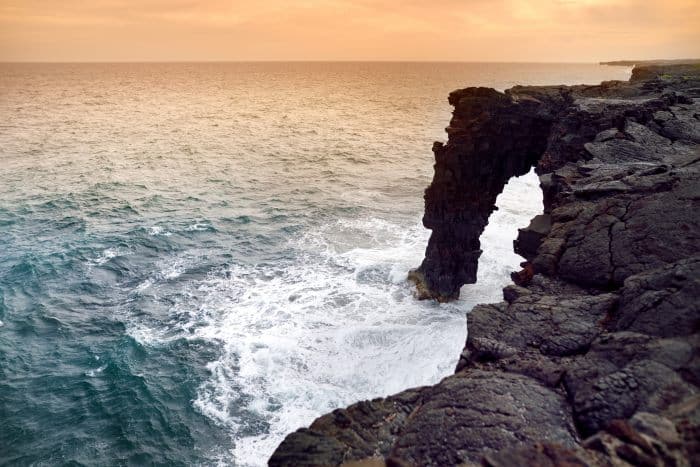
Where to Stay in Hilo
Hilo Bay Oceanfront Bed and Breakfast – Located in the center of Hilo, this cute bed and breakfast is an excellent choice for those looking for a base to explore the national park. They have a number of rooms on offer and there’s also breakfast available in the mornings. Click here to check availability
The Inn at Kulaniapia Falls – If you’re looking for a good jumping-off point for visiting Volcanoes National Park, then this tranquil inn is an excellent choice. They have both lovely cabins and beautiful rooms on offer and there is also breakfast each morning. Click here to check availability
Private Rental – If you’d like to find a self-catering option in Hilo or close to Volcanoes National Park, there are plenty to choose from — like this beach studio — in this area of the island. Click here to browse Hilo private rentals
Big Island Hostel – Those visiting Volcanoes National Park on a tight budget will love this backpacker’s hostel in Hilo. They offer a number of differently-sized dorms to choose from along with a great location and good common areas. Click here to check availability
Not quite what you’re looking for? Click here to browse more Hilo hotels!

Hawaii Volcanoes National Park is truly like no other. This diverse and rich landscape captures several hundreds of years of history. During your visit, you’ll get a first-hand look at two of the world’s most active volcanoes and the landscape they’ve created. Use this itinerary as inspiration to plan the perfect Volcanoes National Park visit.
Are you planning to visit Hawaii Volcanoes National Park? Have any questions about this itinerary? Let us know in the comments!

Related Posts:

Maui vs Big Island: Which Hawaiian Island to Visit?

One-Day Road to Hana Itinerary: A Perfect Maui Day Trip

Kona vs Hilo: Where to Stay on the Big Island?

About Audrey Webster
Audrey Webster is a writer for The World Was Here First. She is an Oregon native who has visited countries across the globe and currently spends her weekends exploring the Pacific Northwest and surrounding states. Her approach to traveling combines exploring famous tourist sites and wandering off the beaten path to discover new destinations.
Leave a Comment Cancel reply

- Best of Hawaii
- Big Island Hawaiʻi
- Activities & Tours
- Attractions
- Food & Drink
- Day & Weekend Trips
- Itineraries
- Practical Information
- What to Pack
- Where to Stay
Hawaii Volcanoes National Park , Itineraries
One day in hawaii volcanoes national park (+ suggested itinerary).
Hawaii Volcanoes National Park is one of the most spectacular sites on the Big Island (and in the whole state!).
This is a one day in Volcanoes National Park itinerary for those looking to embark on a day trip there!
If you’re traveling to Volcanoes National Park last minute, you want to ensure you have tours booked ahead of time! Below are our top picks!
Best Tours from Hilo to Hawaii Volcanoes NP:
- Evening Volcano Explorer from Hilo (6 hours long)
- Active Volcano, Lava Tube, Waterfall and More (also stops by Rainbow Falls)
- Hawaii Volcanoes National Park and Hilo Highlights (5.5 hours)
- Elite Volcano Hike From Hilo (9 hours)
Best Tours from Kona to Hawaii Volcanoes NP:
- Volcanoes National Park and Kona Coffee Farm (12 hours)
- Big Island Twilight Volcano and Stargazing Tour (10 am until 11 pm)
Additional options for renting a car:
- Private tour of Volcanoes National Park (starts inside of the park!)
- Shaka Guides audio and GPS guide (less than $15!)
Traveling to the Big Island independently? Be sure to book your rental car ahead of time to ensure availability!
Home to two of the most active volcanoes in the world, Kilauea and Mauna Loa, the park houses some of the most beautiful and cherished landscapes and natural wonders in the world.
In addition, the park is a sacred place for the Hawaiian people, so visitors will be able to learn more about the culture and importance of the sights within the Hawaiian National Park.
If you have a limited amount of time during your trip to Hawaii, one day might be all you can spare for a trip to Volcanoes National Park.
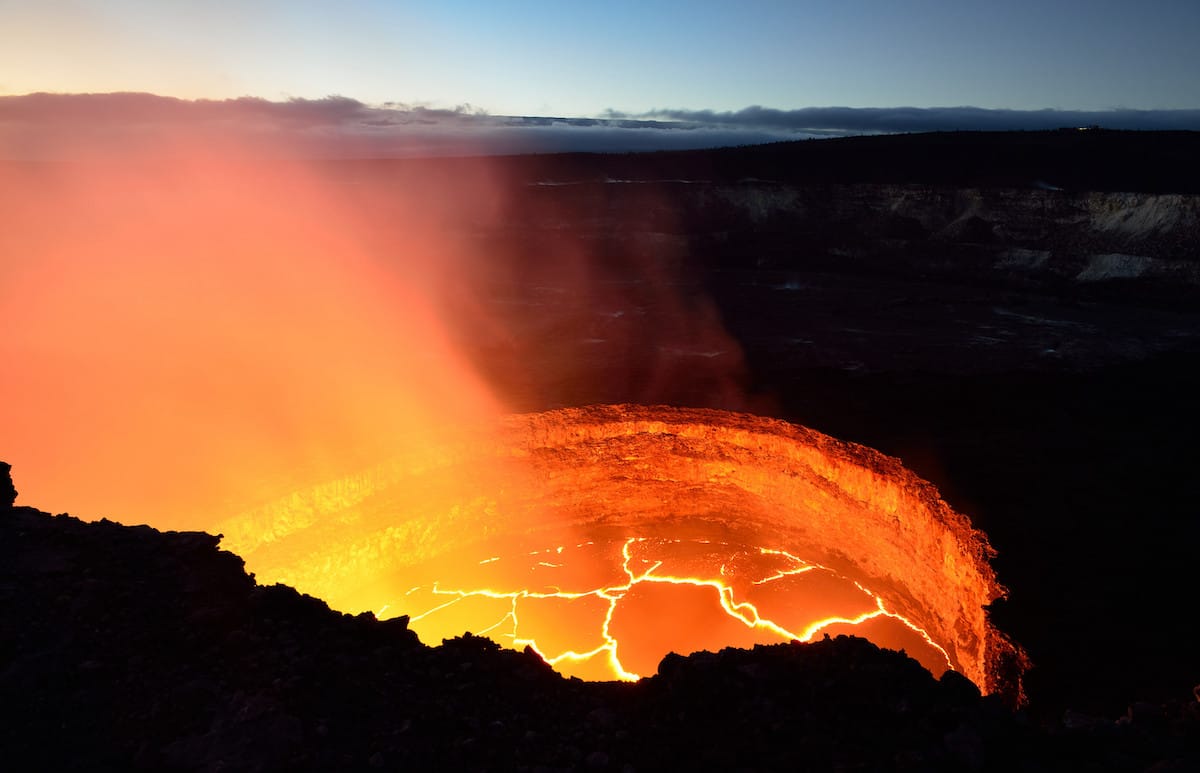
And while you can easily spend more than a day in Volcanoes National Park, it is certainly enough time to explore the park deeply if you’re coming from Hilo or nearby.
This guide will break down the main attractions in Hawaii Volcanoes National Park and give options for a half-day and a one-day itinerary for Hawaii Volcanoes National Park. We also include nearby sights if you have more than a day there.
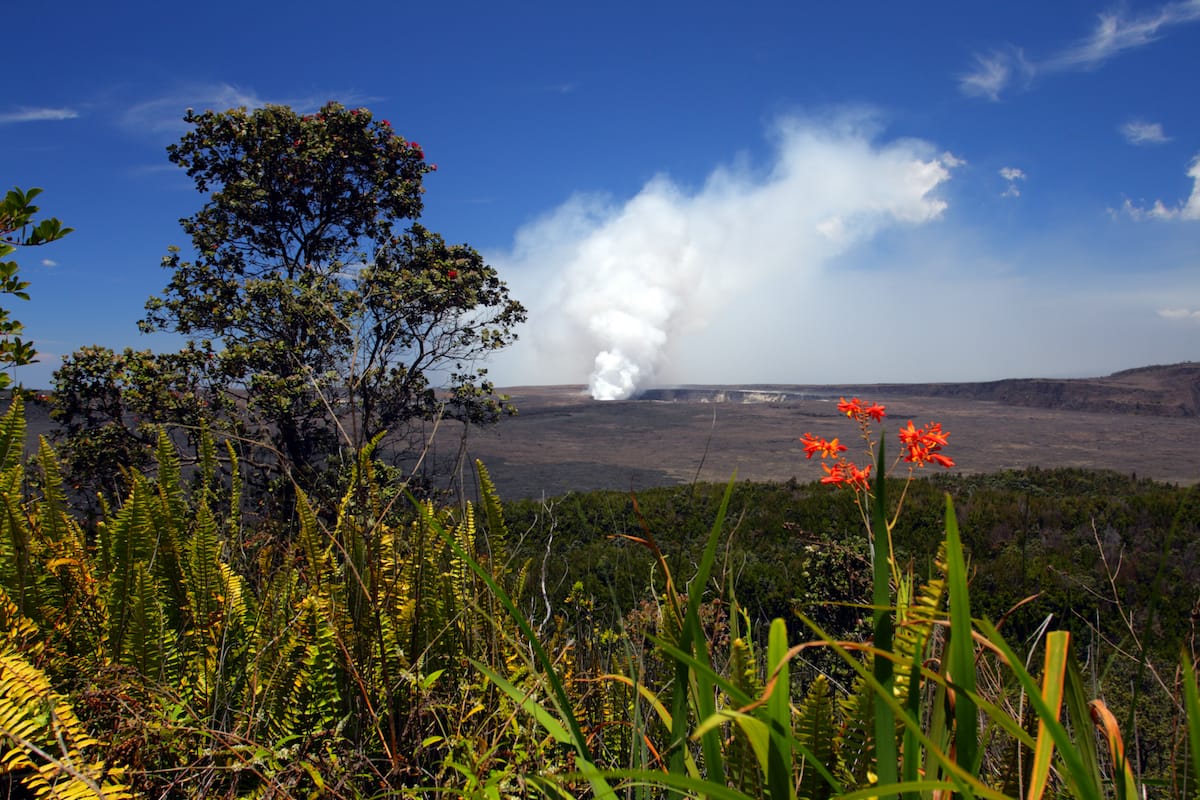
Also included are some tips to help you plan your day trip to Hawaii Volcanoes National Park as well as some of the best tours to take you there without a car!
Let us know if you have any questions in the comments! Thanks!
Planning Your Trip to Hawaii Volcanoes National Park
Hawaii volcanoes national park attractions + highlights, half-day at hawaii volcanoes national park itinerary, one day in hawaii volcanoes national park itinerary, more than 1 day in volcanoes national park, other hawaii itineraries, more big island travel guides, pin this day trip to hawaii volcanoes national park guide, best time to visit hawaii volcanoes national park.
Although Hawaii is rather warm all year round, it is important to note that Volcanoes National Park is a bit colder and wetter than the rest of the state.
Considering its altitude of 4,000 feet above sea level and luscious rainforests nearby, the 200 inches of rain the park gets annually can really make it cooler than you’d think.
In our opinion, the best time to visit Hawaii Volcanoes National Park is in the spring because the park is warm, but there aren’t many visitors.
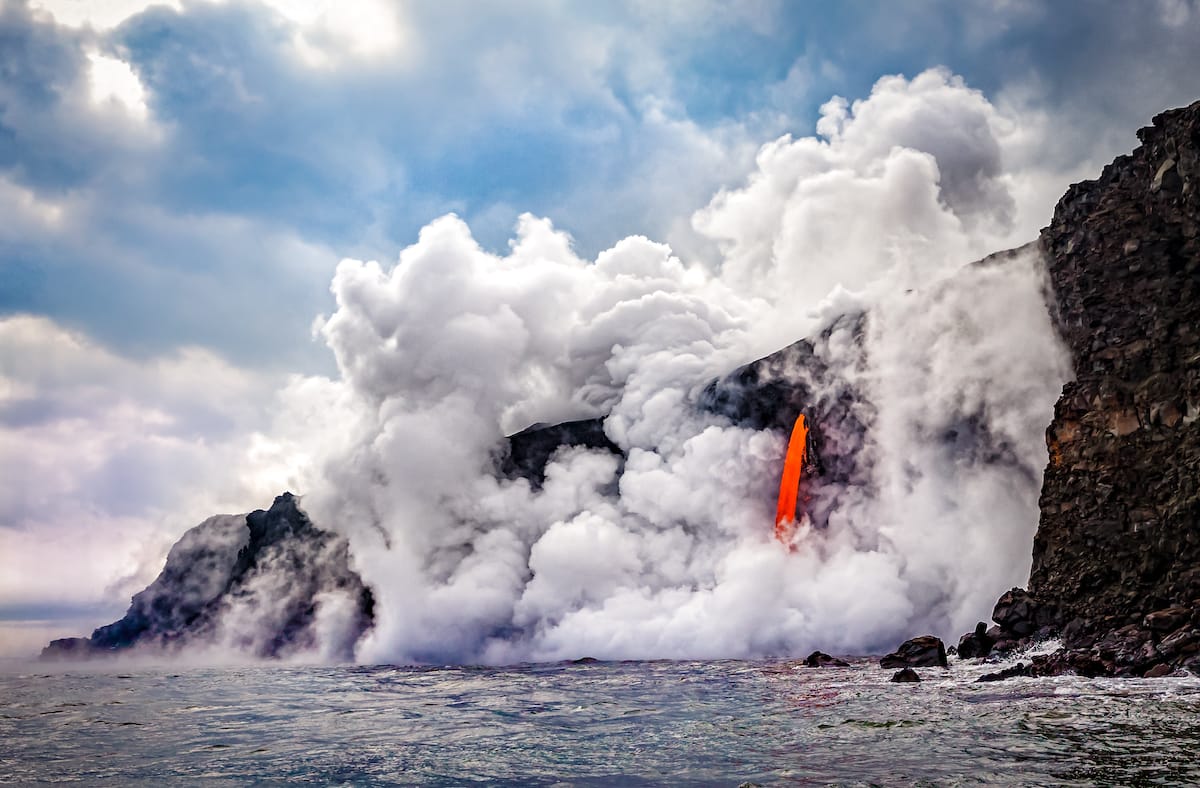
Summer is also a great time to visit, but you’re going to face far larger crowds in June and July .
In addition, November to March is the rainy season, so the area can be subject to torrential rain and strong winds. In short – visit in the spring!
Volcanoes National Park Kilauea Visitor Center
The first stop that we recommend before you embark and truly explore the park is to visit the Hawaii Volcanoes National Park Kilauea Visitor Center where it is possible to get information about what to do in the park, where to hike, and details about other activities.
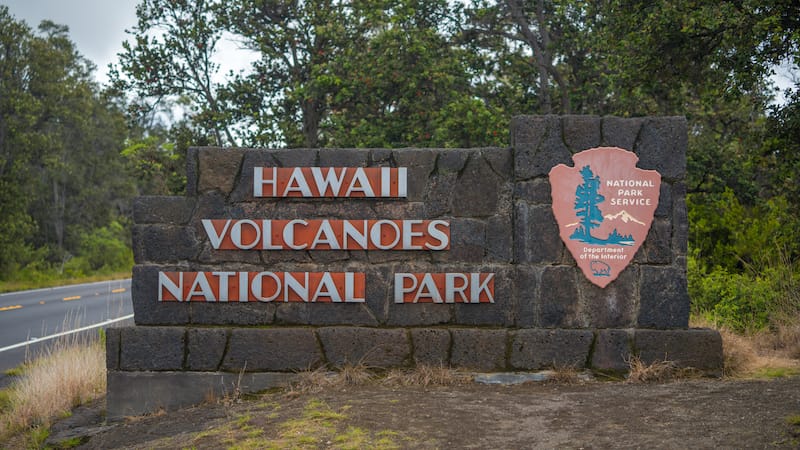
The visitor center is open all week from 9:00 AM to 5:00 PM and is closed on public holidays. Click here for additional information .
While the visitor center closes, the park itself is open 24 hours a day.
Entrance Fee
In order to visit Volcanoes National Park, the fee is $15 per person if traveling by foot or bicycle, $25 per motorcycle, and $30 per vehicle.
Is Kilauea Erupting?
The world’s most active volcano is often doing its thing, so the best way to keep up with its activity is to head over to the daily report on the National Park’s website .
How to Get to Volcanoes National Park
If you are coming from Hilo, drive 30 miles southwest on Highway 11, which should be a 45-minute drive. You can also get there within 2 to 3 hours on Highway 11 if you’re coming from Kailua-Kona or in 2 hours on Highway 200 from Waikoloa.
You can also try to use public transportation, such as Hele-On Bus , but it has limited routes. Many people prefer to use rental cars to make the journey… but you can also take a tour (we mention this below).
However, keep in mind that there is no public transportation in the park, and ride-sharing companies most often don’t take visitors.
The main roads in the park are Crater Rim Drive, Chain of Craters Road, Hilina Pali Road, and Mauna Loa Road.
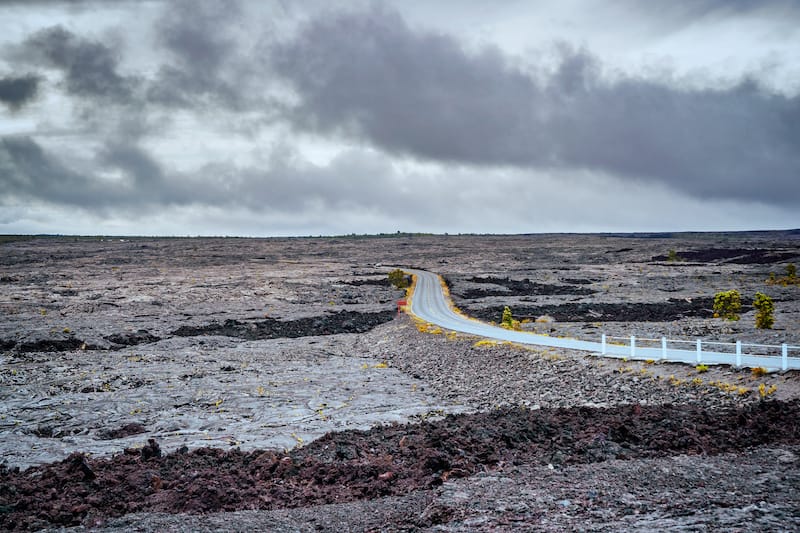
Best Day Tours to Hawaii Volcanoes National Park
This guide is written targeting those with a car but if you are taking a day tour to Hawaii Volcanoes National Park… it truly is a great option!
I have only visited one time and I actually bummed a ride with my friend’s friends but did my own thing for part of the day.
Here are some top-rated Hawaii Volcanoes National Park tours to consider if renting a car is not for you. Please note the location where the tours depart from to ensure it works for where your accommodation is (we have broken it into sections).
Tours to Volcanoes National Park from Hilo
You will find several tours taking you to Volcanoes National Park from Hilo. It is only 45 minutes away (about 30 miles), and it really is the best location to base yourself for the excursion.
However, do note that Hilo is rainy so perhaps don’t book a stay there for your entire Big Island trip . Below are the top-rated tours from Hilo to Hawaii Volcanoes National Park.
- Evening Volcano Explorer from Hilo (leaves at 1230, 6 hours long, also stops by Volcano Winery and Kalapana)
- Hilo Shore Excursion: Active Volcano, Lava Tube, Waterfall and Gardens (5.5 hours long, also stops by Rainbow Falls)
- Hawaii Volcanoes National Park and Hilo Highlights (small group tour, 5.5 hours)
- Elite Volcano Hike From Hilo (9 hours, will trek the 2018 Kilauea lava flow and more, leaves at 0930)
Tours to Volcanoes National Park from Kona
The best thing about staying in Kona is that the area is known for sunshine and pretty perfect weather conditions. Hilo is quite the opposite. However, you will be a lot further away from Volcanoes National Park!
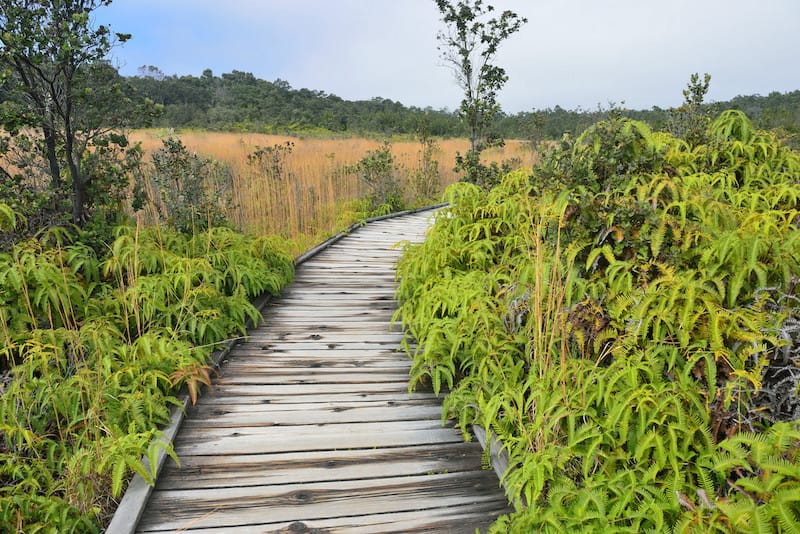
If you’re visiting Kona and want to book a day trip to Volcanoes National Park from Kona, the tours below will help you do so! Please note that most tours include other sights, so plot an entire day for the trip!
- Hawaii Volcanoes National Park and Kona Coffee Farm (12 hours, will also stop by Punalu’u Beach)
- Big Island Twilight Volcano and Stargazing Tour (small group, 10 am until 11 pm)
Private Tour (Meet at Hawaii Volcanoes National Park)
If you have a rental car for your trip but still are keen to hire a guide for the day in Hawaii Volcanoes National Park – this private tour is the perfect option for you and your travel companions!
You will meet your tour guide at the Volcano House Hotel in Pahoa at the park and will have 5-6 hours of skilled expertise as you explore the grounds of this national park!
>> Click here to check tour rates and availability
Audio Driving Tour of Volcanoes National Park
Another great option for those with a rental car is to book an audio tour with Shaka Guides . These are, hands down, the best and most recommended audio guides for your trip!
They have GPS-guided audio tours for you and are super affordable (less than $15)!
>> Click here to book a Shaka Guides audio guide to Volcanoes NP
As noted above, the way we have organized this guide is that we have included the park’s main highlights directly below this text and then we have created suggested itineraries at the bottom of the guide depending on the length of time you have to spend at the park.
Please also note that we discuss the two roads below (Chain of Craters Road and Crater Rim Road) as though they were their own drive entirely… just giving some highlights along the way.
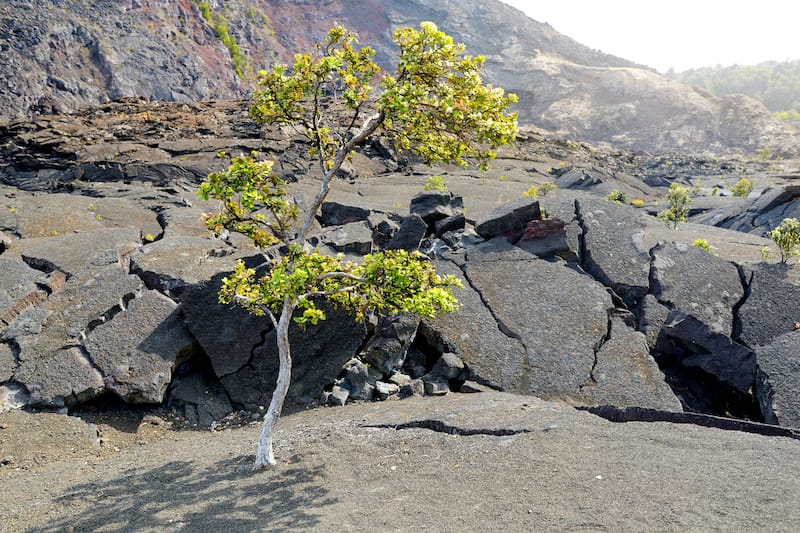
The actual itineraries of individual attractions and things to do in Hawaii Volcanoes National Park are toward the bottom of the guide.
We hope you find this useful and please reach out if you have any questions!
Chain of Craters Road
Chain of Craters Road is the most scenic drive of Hawaii Volcanoes National Park. It is filled with lava fields, flows, and pit craters. The road stretches for 19 miles from the summit of Kilauea Volcano to the sea.
If solely driving the road, your trip will start from several pit craters, including Lua Manu and Koʻokoʻolau. Then, take a trip down Hilina Pali Road, and see breathtaking views at the end of the road.
About four miles in, you’ll find several campgrounds like Kulanaokuaiki, the old Kipuka Nene Campground.
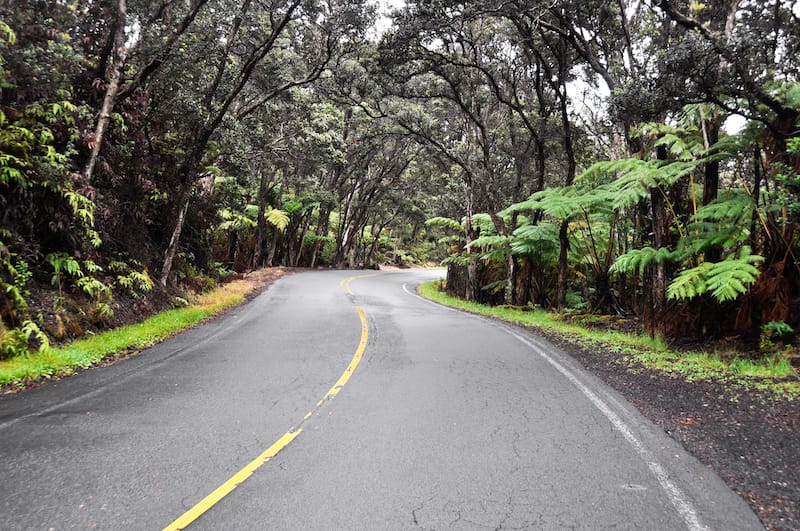
The next stop is at a 150-foot-wide and 165-foot-deep crater called Devil’s Throat. Further down the road, you’ll see the Hi’iaka and Pauahi Craters.
Other must-sees are the 7-mile-long Napau Crater Trailhead with fascinating landscapes, Mau Loa O Mauna Ulu, a black sea of pahoehoe lava, Halona Kahakai pullout with opportunities to view the coast, Pu’u Loa Petroglyph Field, and Holei Sea Arch.
Crater Rim Drive
Crater Rim Drive is an 11-mile road that travels across the Kilauea summit caldera from Uēkahuna to Keanakākoʻi Crater and boasts picturesque vistas and hiking opportunities. A good place to start your trip is at the Kilauea Visitor Center.
The rangers will provide you with all the necessary information and a map. Wander for several minutes in the museum to get acquainted with the life of the area.
Guided tours and public restrooms are also available. To the left, check out the Volcano Center Art Gallery, where you can enjoy local artwork. The Volcano House is a lodging place for visitors dating back to 1846.
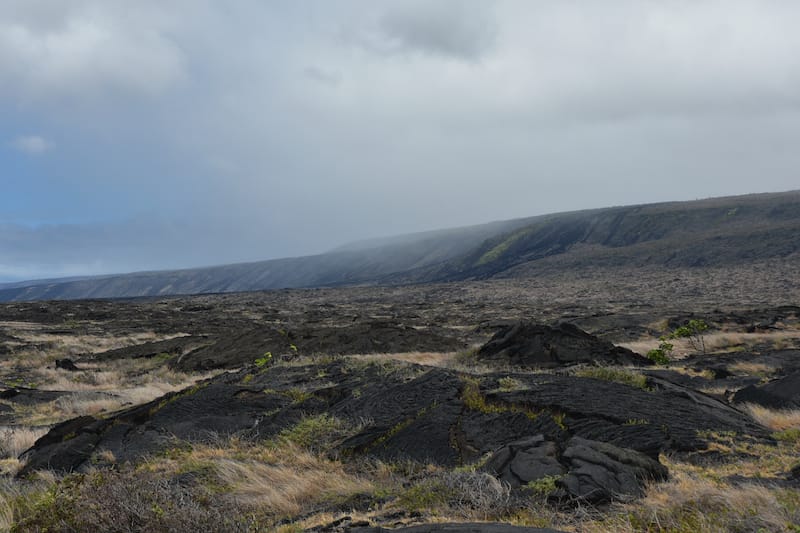
Some prominent guests of the house have included Mark Twain and President Franklin D. Roosevelt.
Furthermore, visit Sulfur Banks, an open area covered with sulfur, Steam Vents, the beating heart of the volcano, Jaggar Museum & Hawaiian Volcano Observatory, Southwest Rift Zone, Keanakako’ i Overlook, and Kilauea Iki Overlook.
Steam Vents
One mile past the Kilauea Visitor Center, you’ll find the Steam Vents area. Hawaiians call it Wahinekapu . Groundwater and rain seep into the warm rocks and evaporate, returning to the surface as steam.
You can explore this thermal wonder and feel the breath of Mount Kilauea. The landscape here changes from rain forests to grassy fields as only some shallow-rooted plants can survive in this region.
Enjoy a short walk on a trail starting from the Steam Vents parking lot and stretching to Steaming Bluff. The area bears unique cultural significance.
Hawaiians come here to get rid of bad toxins. This is also the place where they present offerings to Pele, the volcano deity.
Devastation Trail
Wheelchair and stroller accessible? Yes
The Devastation Trail is one of the main volcanic sites you can reach from Crater Rim Drive. This paved path stretches through the landscape buried under the cinder from lava fountains dating back to the 1959 Kilauea Iki eruption.
There’s a parking place at the beginning of the trail. The trail is easy to walk and spans merely a mile round trip.
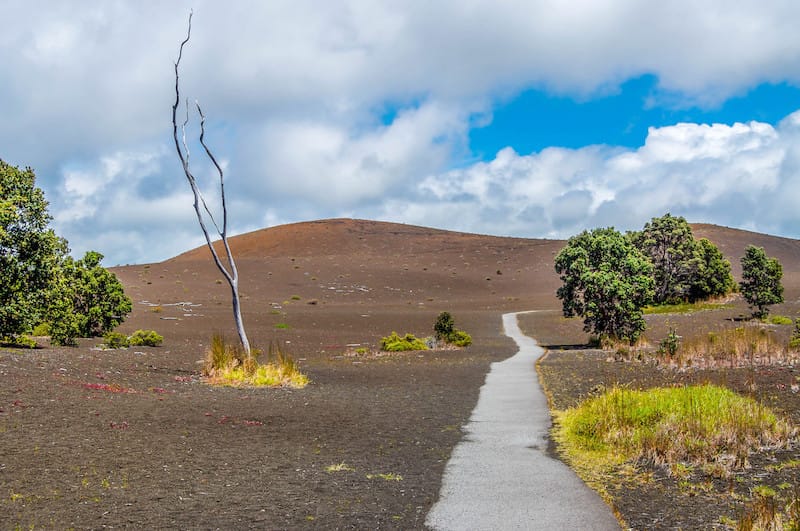
Along your way, stop at the Kilauea Iki Crater and walk to a former lava lake. After a short walk through a tree-lined path, you’ll reach the lands devastated by lava.
Take a closer look at the ground, and you’ll see volcanic debris in the form of strands, which are drops called Pele’s Tears and Hair.
If you’re lucky, you’ll see Hawaiian geese, known as nene, on your path.
Halema’uma’u Crater
Halemaʻumaʻu Crater is a pit crater located within the Kīlauea Caldera at the top of Kīlauea volcano. This is the most active vent of the volcano. The name means house of the amaʻu fern.
The crater is about 280 feet deep and 3,000 feet across. Its size has significantly changed over the last century because the magma flows under the surface and sometimes erupts, filling the crater’s floor.
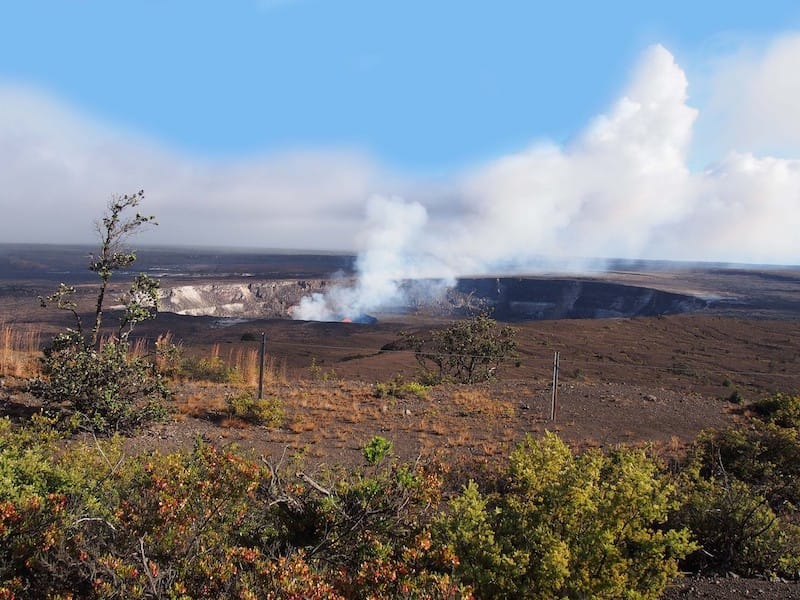
The Halemaumau Crater emits tons of sulfurous gas steaming up through the cracks in the black lava rock. A small water pond appeared in Halemaʻumaʻu in 2019 that was boiled away in 2021 and refilled with lava.
Halema‘uma‘u is regarded to be the home of the Hawaiian fire goddess Pele. Not far from Halema‘uma‘u, on the western rim of Kilauea, you can check out the Hawaiian Volcano Observatory.
To visit, you must hike the moderately-difficult trail. It is not wheelchair or stroller-friendly.
Holei Sea Arch
Hōlei Sea Arch is located at the end of Chain of Craters Road. Take a short walk along the road, and you’ll see a massive lava rock formation about 90 feet high stretching from the sea cliffs into the Pacific Ocean.
This basalt formation was born from marine erosion in which the waves of the ocean made a natural bridge.
Holei Arch is one of the youngest sites of Volcanoes National Park. It was created only in the last 100 years!

But the arch may also be the next to disappear because the recent earthquake activity that takes place on the volcano, as well as the waves, may finally cause the arch to collapse.
The Hōlei Sea Arch Trail is open for hiking, but it’s closed for horse riding and biking. Be sure to stay back from the cliff edge and follow all the instructions when you’re embarking on this Volcanoes National Park day hike .
Kīlauea Iki (Trail)
In 1959, the eruption of Kīlauea Iki Crater became the most spectacular lava sight of the 20th century. It lasted for 36 days and created unique opportunities for geologists to study the ongoing processes of the Kīlauea volcano.
The eruption began when a curtain of lava burst from a half-mile crack. Later, fountains of lava appeared from the vent and flooded the crater, creating a lava lake.
When the lava lake grew higher than the vent, the eruption stopped. Lava started pouring back into the vent faster and faster.
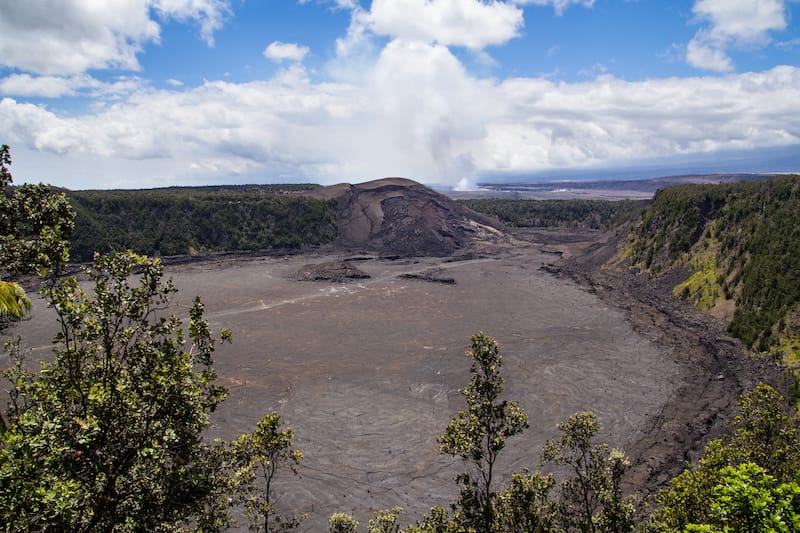
The large cinder cone on the left of the crater, Puʻupuaʻi, was formed. Today, one can see this bathtub ring on the walls of the crater and walk on its lava-formed floor.
Although Kīlauea Iki is peaceful(ish) now, you can still feel the pulsating magma through the volcano.
To reach the site, drive along Crater Rim Road for a few miles until you find the large parking place for the Kīlauea Iki Trail. It is not a wheelchair or stroller-friendly trail.
Pu‘uloa Petroglyphs
Pu‘uloa means “a long hill” and is a sacred place for Hawaiian people. Situated on the southern part of the Kīlauea volcano, Puʻuloa is a vast area containing numerous images carved into the hardened lava, called petroglyphs.
The site covers more than 23,000 unique petroglyphs. The Pu’uloa Petroglyphs were carved by the ancestors of the Pueblo people from about 1300 through the late 1680s.
Some of them even pre-date the Puebloan period, dating back to 2000 B.C.
Here, you’ll also find small holes in which the locals used to put their newborns’ umbilical cords to grant them a long life.
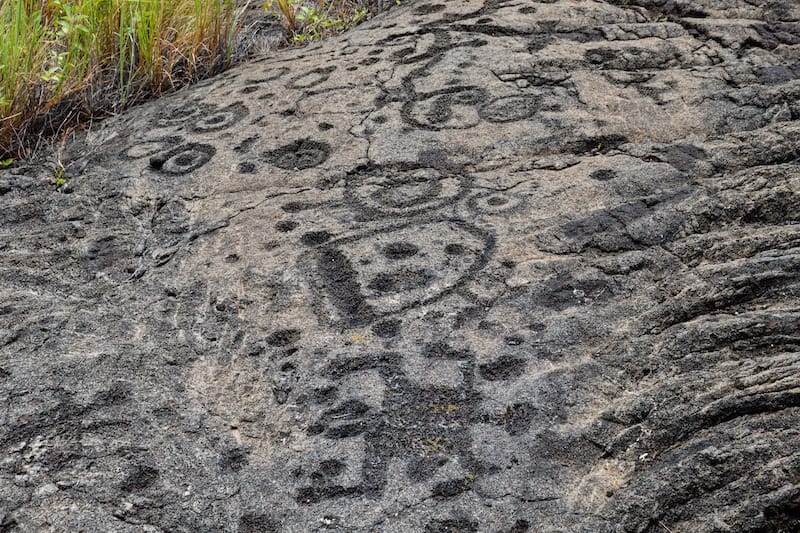
To avoid damaging the petroglyphs, the park administration constructed a boardwalk above the surface where visitors can walk along and view the site.
Drive along the Chain of Craters Road, proceed about 16 miles, and you’ll see a road sign marking the petroglyph field.
Nāhuku (Thurston Lava Tube)
Thurston Lava Tube , or Nāhuku, is a 500-year-old massive lava cave. The flows of molten lava caused the cave to form its shape. The active lava flows through the tunnels at about 2,000º F, and when it stops or gets diverted, it leaves empty caves behind.
There are several similar caves throughout the park, but Nahuku is the most accessible and definitely the most famous.
The Thurston Lava Tube was discovered in 1913. Lava drippings once covered its roof, which later disappeared because of souvenir collectors.

The entrance of the cave is equipped with electric lights and has a flat rock floor, but after a short stroll, you’ll reach the section that is completely dark with an uneven floor, so be sure to have strong flashlights.
You can have a short day hike into the tube from Crater Rim Drive passing through the Hawaiian rainforest while enjoying bird watching.
Volcano House Hotel
With its iconic location and dramatic views, the house always attracts visitors from all over the world. Mark Twain was known to stay here and wrote about it in the book Roughing It .
The oldest building regarded as the predecessor to Volcano House dates back to 1846. It was built by Benjamin Pitman, the husband of Princess Kinoʻole o Liliha Hoʻolulu and a famous businessman.
Today, the Volcano Art Center is also situated here. The restored Volcano House provides 33 guest rooms overlooking Kilauea caldera, a dining room, snack bar, lounge, and gift shop, as well as cultural events and exhibits.
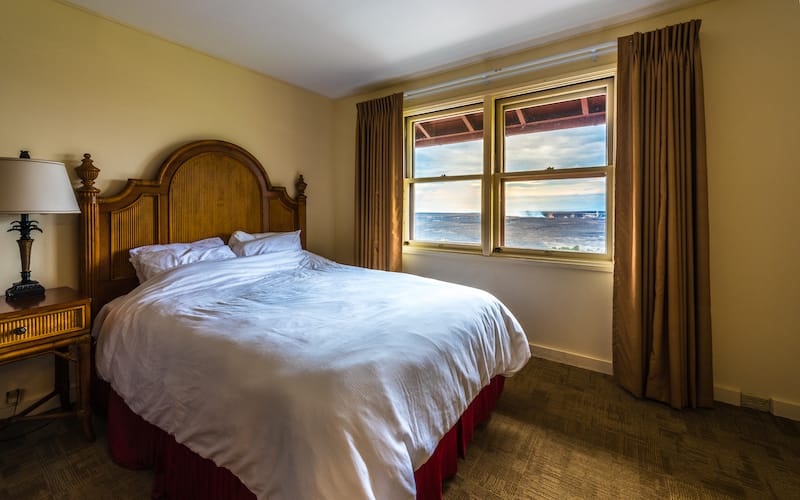
Guests can access a lending library, board and card games, free bicycle rentals, and guided tours around the park. It also boasts camper cabins and campsites in the nearby Nāmakanipaio Campground.
This is the only hotel inside Hawaii Volcanoes National Park.
If you’re taking a private tour of Volcanoes National Park , your meeting point may be here!
To be 100% honest with you, a half-day trip to Hawaii Volcanoes National Park will only work if you’re already in the vicinity of the park (or in Hilo).
When I went, I pretty much spent a half-day at Volcanoes National Park (6-8 hours in total) as I stopped by several places nearby beforehand. However, I did not do any super crazy hikes that day and only visited the main attractions within the park.
Here is a short itinerary of Hawaii Volcanoes National Park for those with only a short amount of time to visit the park!
- Kilauea Visitor Center (closes at 5pm so go on your way into the park)
- Steam Vents (these are worth a quick stop and if you want to see more, you can take the Sulphur Banks Trail which is mentioned in the second itinerary option)
- Kilauea Lookout / Halemaumau Crater (when I was last here, it offered a glimpse of lava but who knows now. Apparently, lava is back as of September 2021, however)
- Kilauea Iki Overlook (this offers a view of the entire crater!)
- Thurston Lava Tube (you only need 15-20 minutes here but it is an essential stop)
- Kilauea Iki Trail (this trail can be long or short – you can take the short one from the Thurston Lava Tubes parking lot if pressed for time). Be careful of rocks along the way and at the bottom!
- Devastation Trail (this trail only needs about 30 minutes but is a park highlight)
- Pu’u Loa Petroglyph Hike (I love this hike and it is only an hour-long max – about 20 minutes each way)
While many may recommend getting an early start in the park, I actually loved visiting in the afternoon as I got to see the sunset there and see the crater at night filled with lava.
I have no idea if the lava is there today as it disappeared in May and was back by September – either way… worth a stop!
If you have a full day at Volcanoes National Park, you will be able to take your time a bit more inside of the park and enjoy some of the hikes there without feeling pressed for time.
Here is our recommended itinerary for spending one day in Volcanoes National Park:
- Sulphur Banks Hike (1.2-mile hike round trip along a paved path – easy and great for kids as there are many steam vents!)
- Kilauea Iki Trail (this trail can be long or short – you can take the short one from the Thurston Lava Tubes parking lot if pressed for time). Be careful of rocks along the way and at the bottom! I actually enjoyed the longer version of this hike and it doesn’t take too long.
- Puhimau Crater (only need about 10 minutes here)
- Mauna Ulu Eruption Trail (easy, half-hour hike loop trail – this actually is a short part of a much longer hike !)
- Holei Sea Arch (you will see the ocean from here… there are also a ranger shed, picnic tables, and restrooms)
If you have more than 1 day in Volcanoes National Park, you can slow down the itineraries mentioned above and enjoy all of the hikes and landmarks and attractions in between the ones we noted.
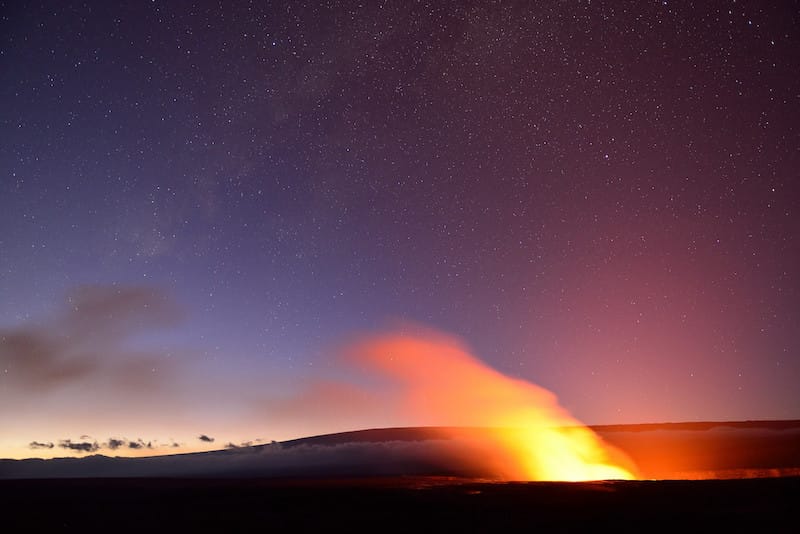
Alternatively, you can visit some places near Hawaii Volcanoes National Park (and inside!) that we think are worthwhile! Here are a few of our top favorites to add to your Hawaii Volcanoes National Park itinerary.
Mauna Loa Lookout
The Mauna Loa Lookout , located at the end of an 11-mile journey outside of the park, offers a stunning viewpoint. The region offers panoramas of the Kilauea Crater and serves as the starting point for hikes to the world’s largest subaerial volcano.
The Mauna Loa Strip Road leads travelers to the overlook, which is located at an elevation of 6,662 feet (2031 meters). It’s a one-way road with a length of 11.2 miles in total.
The trek to the summit is a major challenge, so amateurs are discouraged from doing the hike and it is best if you have more than 24 hours in Hawaii Volcanoes National Park dedicated to this trail nearby.
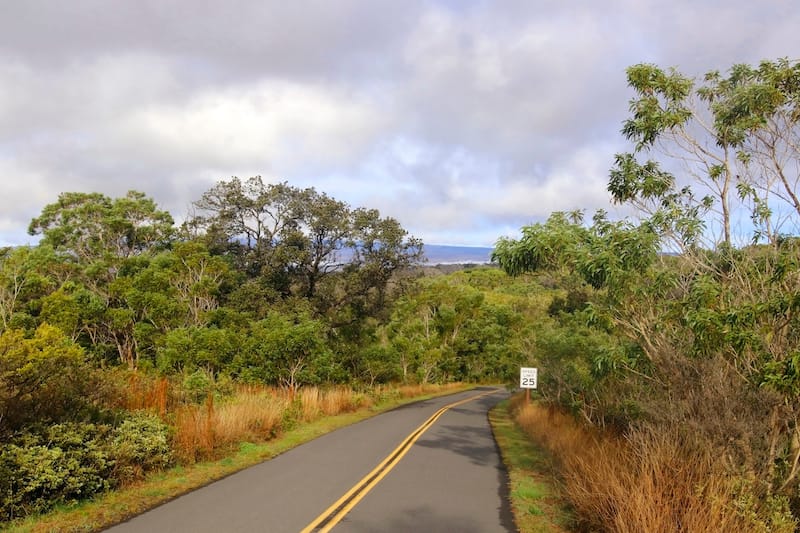
The trail traverses through steep, jagged, and frequently unstable lava on its way to the peak, which is at a high elevation. It’s mostly because of this that the area is difficult to climb.
Furthermore, the trail is marked by stacked rocks and could be difficult to locate in limited visibility situations.
It’s only possible to stay here for three nights in a row. If you’re considering a trip here, keep in mind that you’ll need to be well-prepared and have some experience with high-altitude trekking.
You’ll be surrounded by the sounds of wonderful tropical birds during your visit, and if you’re lucky, you might even see the rare ‘i’iwi bird.
Maunaulu / Pu‘uhuluhulu Hike
If you have two days in Hawaii Volcanoes National Park, definitely consider the Maunaulu / Pu‘uhuluhulu Hike .
This lunar-like landscape is from the 1969-1974 Maunaulu lava flow and eruption and you will find a variety of landscapes there (it is a geologist’s dream)!
It is a moderate trail that includes mostly easy terrain but there is a small 1/4 mile climb up the Pu‘uhuluhulu cone that can be slightly challenging.
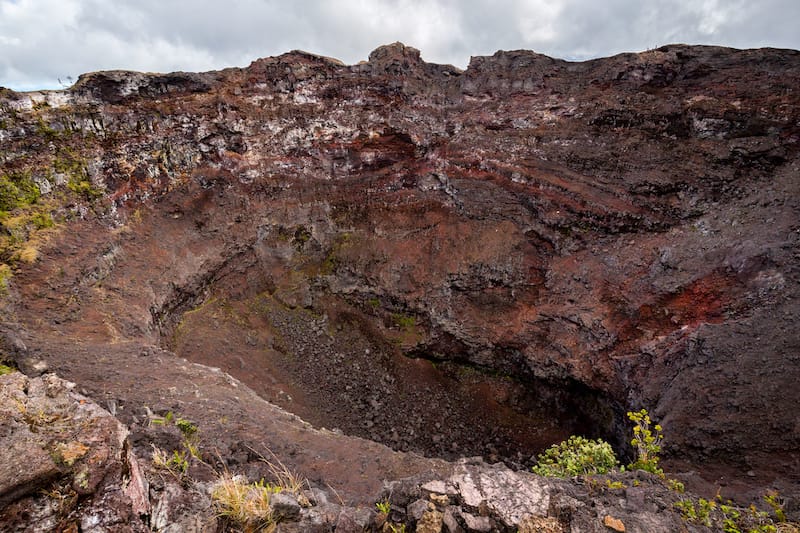
The trail is 2.5 miles long and takes around 2-3 hours. Please note that the beginning of the trail is an easy, beginner-level trail that will be crowded.
The trailhead is 100 yards from the parking area at Maunaulu. You will see stacked rocks that mark the trail along the way – do not move them and please stay on the trail!
Punalu’u Black Sand Beach
The Big Island black sand beach is a popular stop on the way to Volcanoes National Park.
Situated between Pahala and Naalehu on the southeastern Kaʻu coast, Punaluu Black Sand Beach is one of the distinguished areas on the Big Island.
The black sand formed as a result of the rapid cooling of basaltic lava that hit the ocean water and shattered into tiny pieces.
The waves pushed the sand black to shore, so the beach evolved. Punaluu is home to endangered Green Sea Turtles and Hawksbill Sea Turtles.
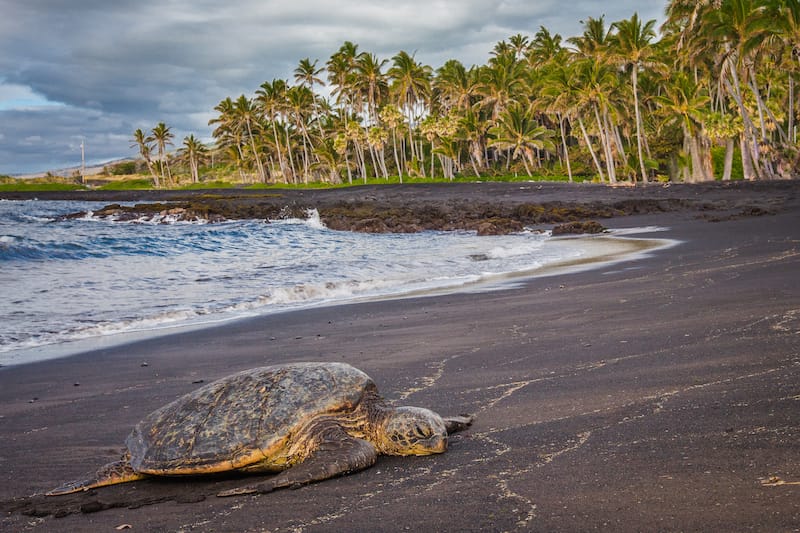
One can see them chilling along the sand, staying warm in the sun. Please do not touch them and never block their access to the sea or land.
If the weather is calm, you can swim or snorkel in the bay. Behind the beach, you’ll find a freshwater pond with alluring views of water lily plants.
Have you ever taken a day trip to Volcanoes National Park? Let us know your top tips for a one day in Hawaii Volcanoes National Park itinerary below.
- 4 days in Oahu
- 4 days in Kauai
- 2 days in Honolulu
- 7 days on the Big Island
- 7 days in Maui
- Things to do on the Big Island
- Big Island itinerary
- Day hikes in Volcanoes National Park
- Best beaches on the Big Island
- State parks on the Big Island
- Best things to do in Hilo
- Top things to do in Kona
- What to do in Waikoloa
- Waterfall hikes on the Big Island
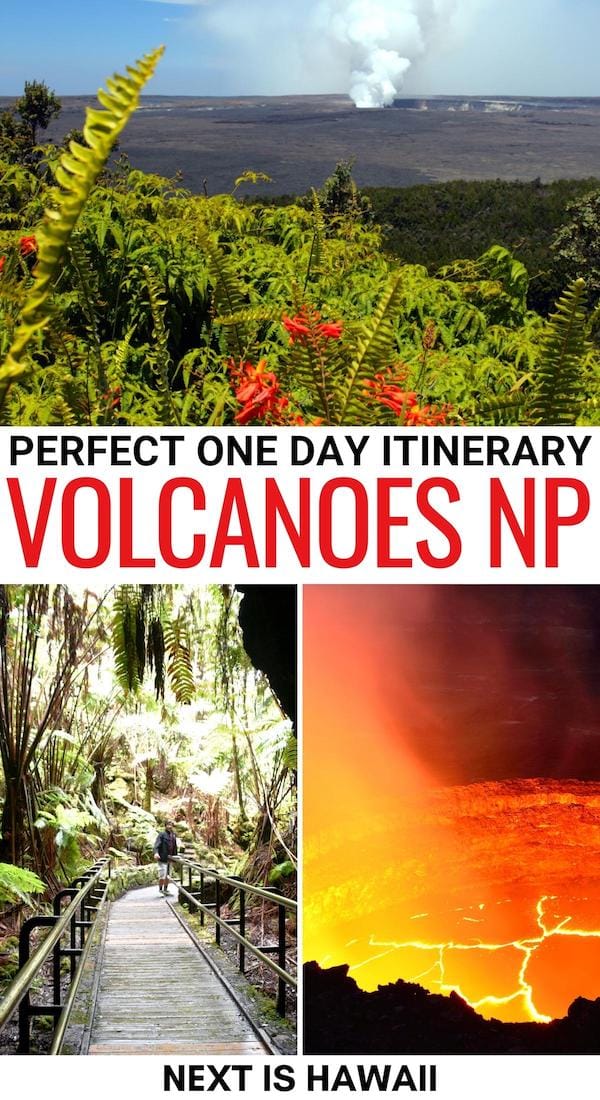
Leave a Reply Cancel reply
Your email address will not be published. Required fields are marked *
Save my name, email, and website in this browser for the next time I comment.
Tips for visiting Volcanoes National Park

My wife and I are old enough to easily remember the 1959 release of the movie "Journey to the Center of the Earth." Based on a Jules Verne novel, it was the fictional tale of four adventurers who went into the bowels of the earth to find its center. While such a fantasy belongs solely in the realm of our imagination, the idea of seeing and experiencing some of this volatile subterranean furnace is intriguing, to say the least.
That's why Hawaii Volcanoes National Park was on our must-see list as we navigated through the Hawaiian Islands on our first visit to the Rainbow State . We considered this national park to be like an interactive peek to another world below: our own journey to see what flows from the center of the earth.
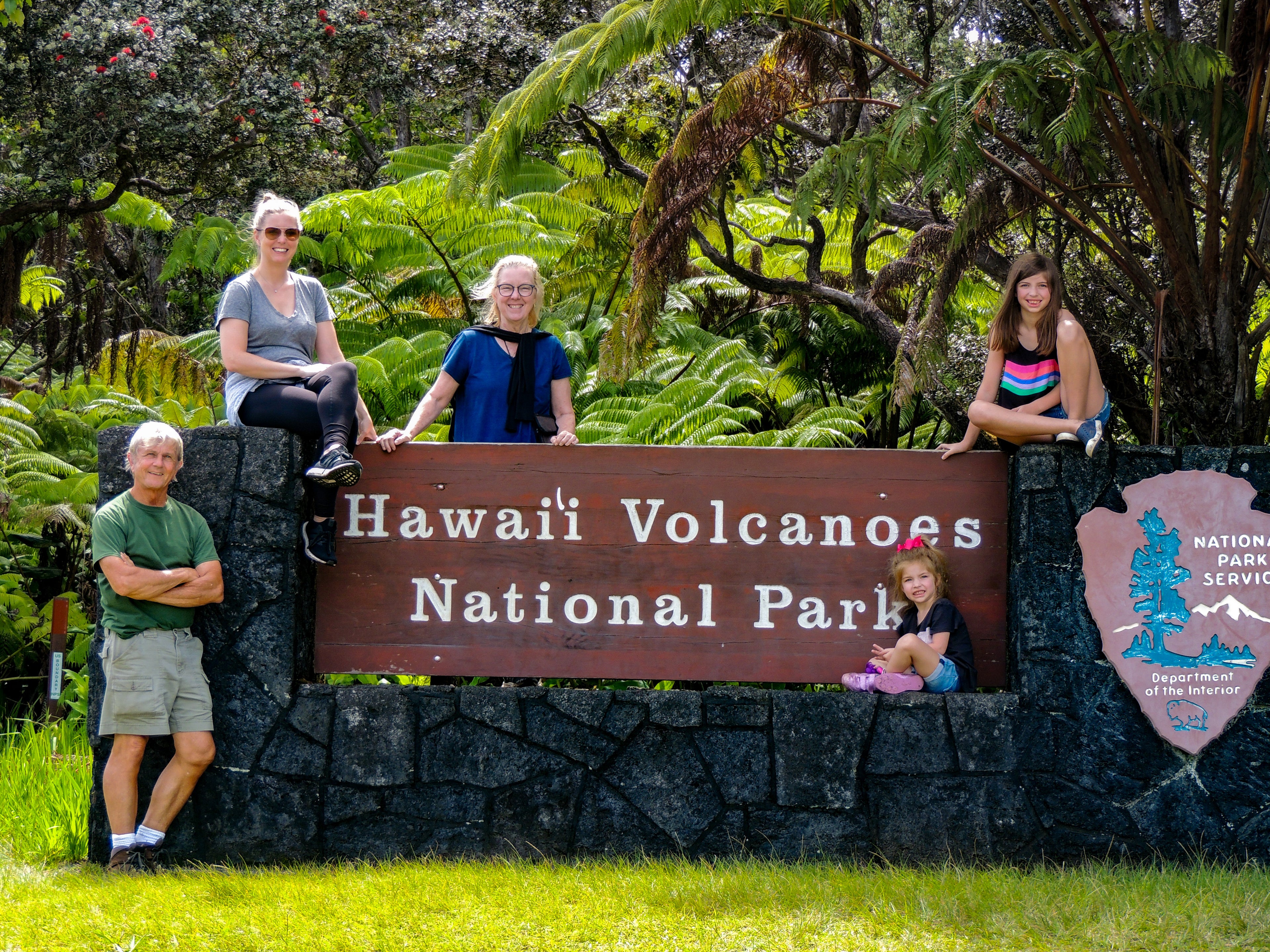
Volcanoes National Park basics
While the National Park Service is technically in charge of Volcanoes National Park, Pele, the legendary Hawaiian goddess of volcanoes and fire, has the first and last word on all activities there. If the old Yankee Stadium was "the house that Ruth built," then Volcanoes National Park -- and, in fact, the entire island of the Big Island of Hawaii -- is surely the land that Pele built. Pele, "she who shapes the sacred land," supposedly lives in the Halema'uma'u Crater within the park.
Related: Points and miles guide to visiting Hawaii
How to get there
Hawaii Volcanoes National Park is in the southeast corner of the Big Island of Hawaii and occupies about 12% of the island's land mass. Highways circle the perimeter of the island, so there is easy access to the park from the major airports at Kona and Hilo. Many tourists drive a rental car to the park, but you can also go as part of a group tour. Look for tour operators at Viator.com , or search Google for "Hilo" and "Volcanoes National Park" and you'll find options from companies like Roberts Hawaii and others.
When is the park open?
The park is open 24 hours a day, with its busiest time being between 10 a.m. and 3 p.m. Despite the 500 square miles of park space, our observation is that most visitors stay within a few miles of the park entrance.
How much does it cost?
Entrance to the park costs $25 per noncommercial vehicle. This fee is good for seven days and covers all the occupants in the vehicle. Individuals that come by bus, bike, motorcycle or on foot will pay fee of $12, which also covers seven days. Of course, national park passes are valid and welcome. Our lifetime senior citizen national parks pass worked perfectly for our group of five.
What's the park like?
Since the Big Island first poked its head above the blue Pacific waters some 500,000 years ago, volcanoes have shaped and molded the diverse topographical and environmental landscape of the island on an almost continual basis. Elevation changes from sea level to 13,500 feet have transformed the island into a climatic and vegetative cornucopia, with landscapes ranging from almost desert dry to rainforest to arctic in a span of less than 50 miles.
Upon arriving, your first stop will undoubtedly be the visitor center where, depending on your time and level of interest and curiosity, you can get either Volcanoes National Park 101 or glean enough information for a thesis toward a master's degree in volcanology. The center is well staffed with park rangers and well supplied with park souvenirs and basic provisions for your visit. You can also learn about the ranger-led walks and talks that happen several times a day and that go to multiple destinations.
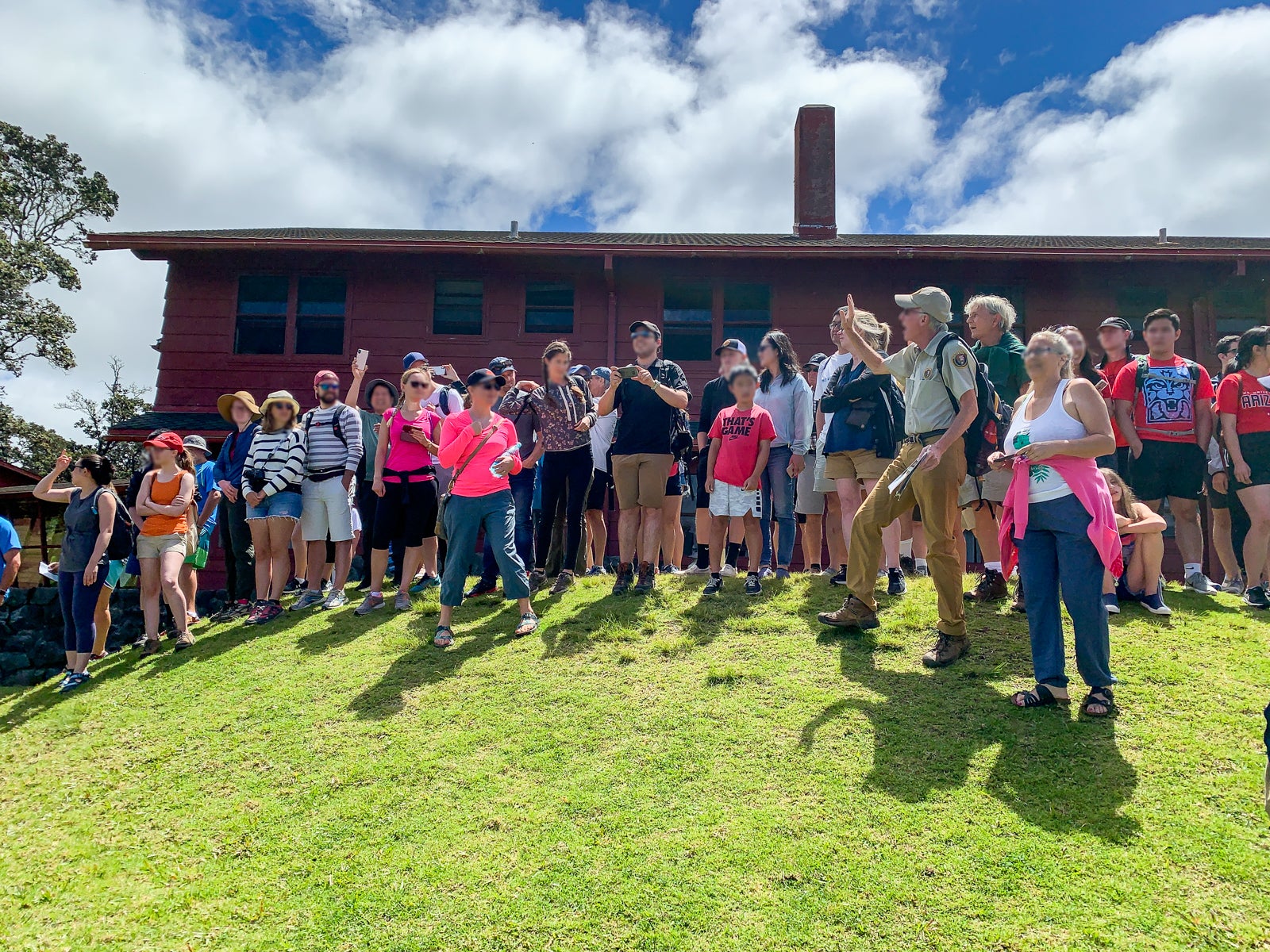
The Volcano House awaits you about 100 yards from the visitor center. Virtually the entire south side of the building is glass to allow your first view of the Kilauea Caldera and the Halema'uma'u Crater. Head through the door to the viewing platform to get an even better look at one of the main reasons you came to the park.
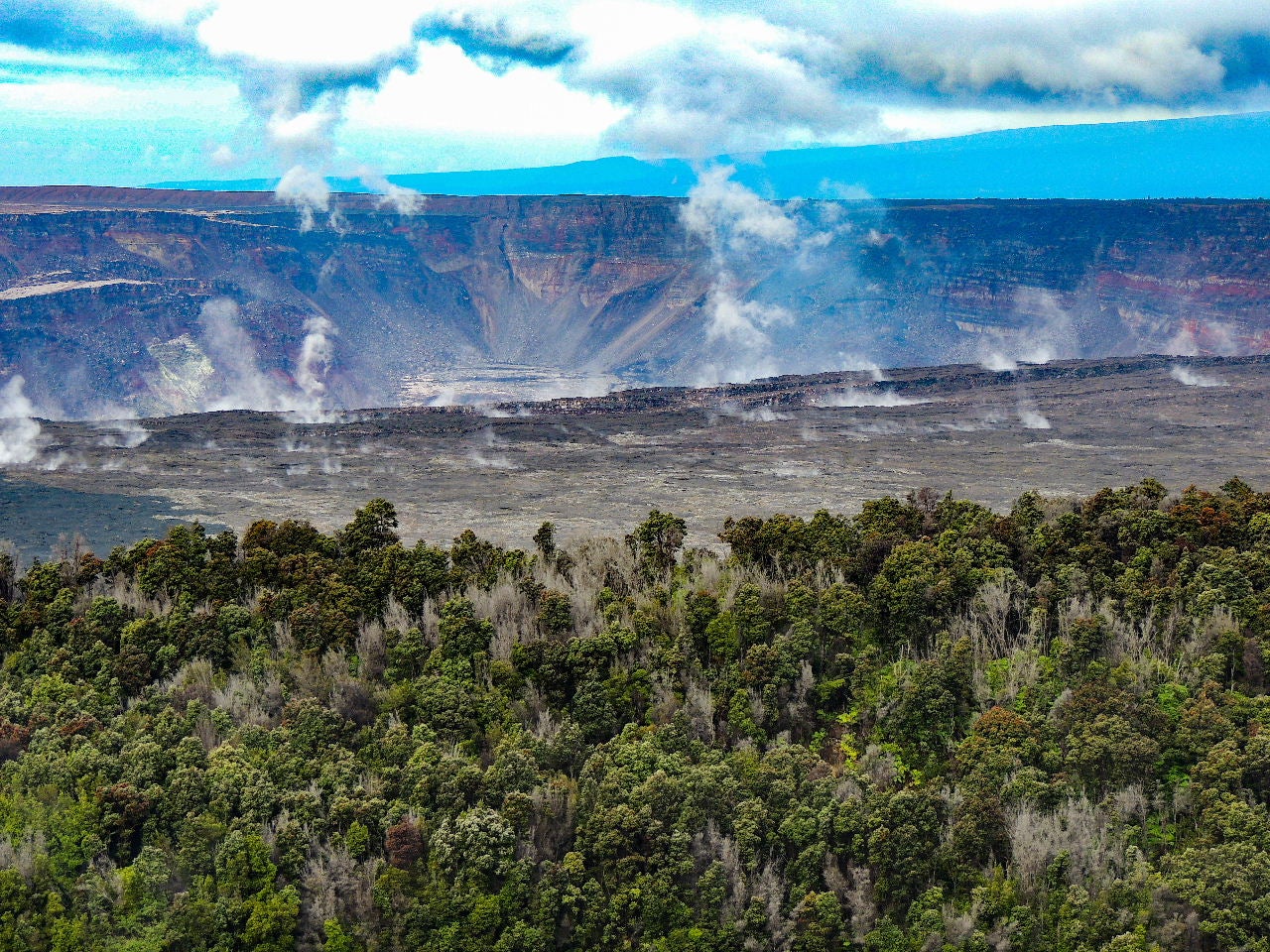
Impact of the 2018 Kilauea eruption
Kilauea, the most active volcano on the planet, had been alive and erupting almost nonstop since 1983. But in May of 2018, a series of earthquakes preceded a new and more vigorous lava flow that created fissures through which gushed rivers of 2,000-degree lava, which made its way relentlessly down the shield volcano and toward the sea. More than 700 houses were lost in neighborhoods that were in its path and Volcanoes National Park was closed for months due to the dangers and damage.
The consistent volume of lava flowing would have filled 40,000 dump trucks per hour. The total amount of lava released would fill about 300,000 Olympic swimming pools and cover the entire island of Manhattan with 27 feet of lava. An additional 875 acres of new land was created by the lava as it interacted with the ocean waters. The Halema'uma'u Crater has almost doubled its size since May of 2018, and has gotten about 1,500 feet deeper.
Damage to the infrastructure of the park has resulted in both short term and long-term closures. The Jaggar Museum and crater lookout was the most popular attraction in VNP, and it was damaged significantly by last year's activity. The ledge that it sits on has now been declared unsteady and it is highly likely the site will never reopen. The Thurston Lava Tube has been closed to the public for the past 16 months, but progress is being made toward its reopening later this year. (A lava tube is like a self-created subway tunnel for lava.) The highly traveled Crater Rim Trail and Crater Rim Drive are both only partially available to the public at this time.
Another significant post-2018 eruption development is that Kilauea is now sleeping. After 38 straight years of lava flowing and lava glowing, right now there is nada lava. No flow, no glow.

The lava lake in the Halema'uma'u Crater has been replaced for the first time in known history with water. Experts are a little wary of this new situation, as they are concerned that when Pele turns the hot lava faucet back on, that mixture of lava and water could lend itself to a more explosive reaction.
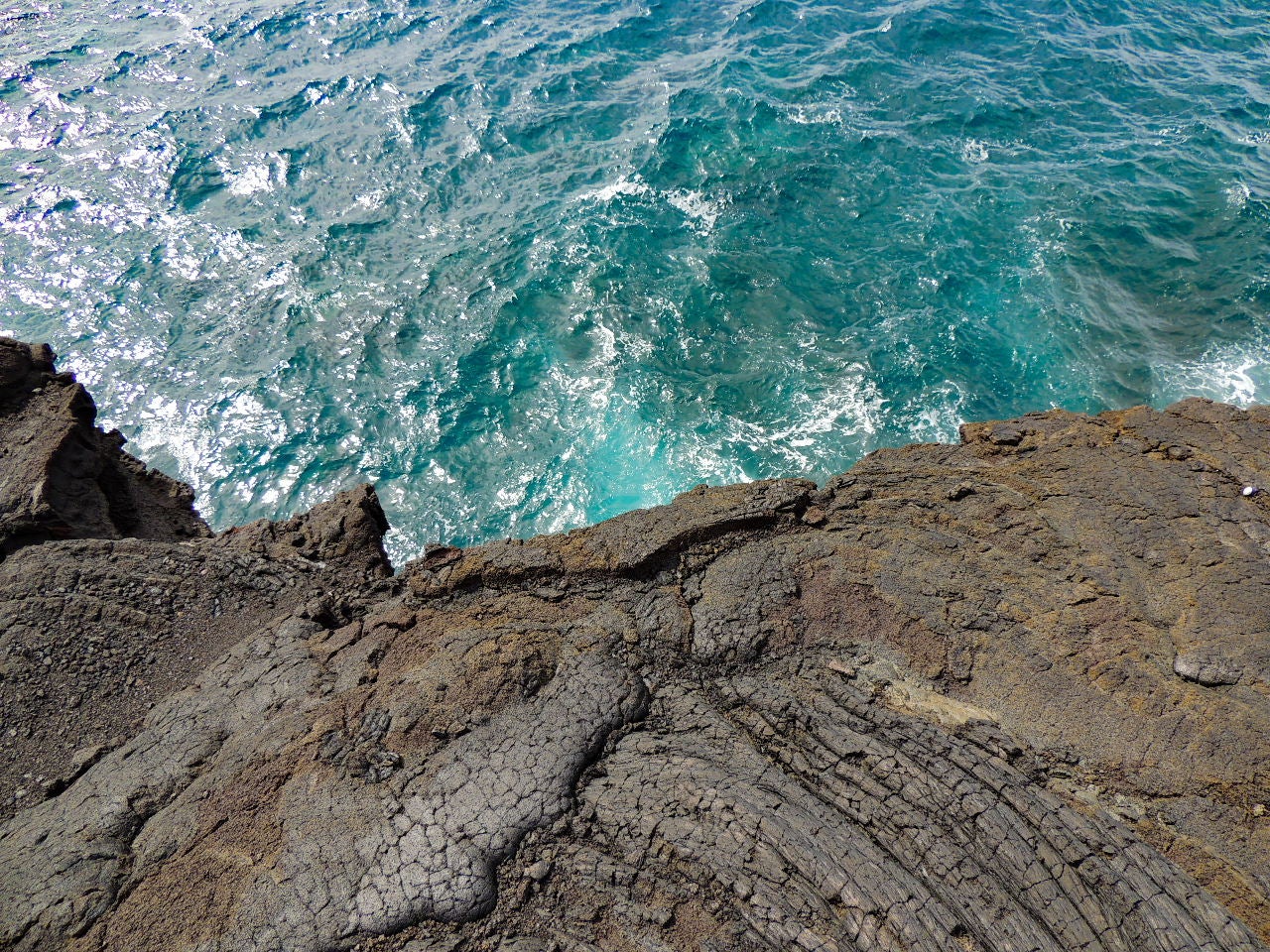
Things to do at Volcanoes National Park
To appreciate and experience the offerings of the park, we visited the steam vents, drove the Chain of Craters Road and hiked the Devastation and Halema'uma'u Crater trails.
The 38-mile round-trip Chain of Craters Road is like a geological history map of recent and long-ago volcanic activity. The road follows and bisects several massive lava flow fields that stretch for miles until they disappear into the ocean's edge.
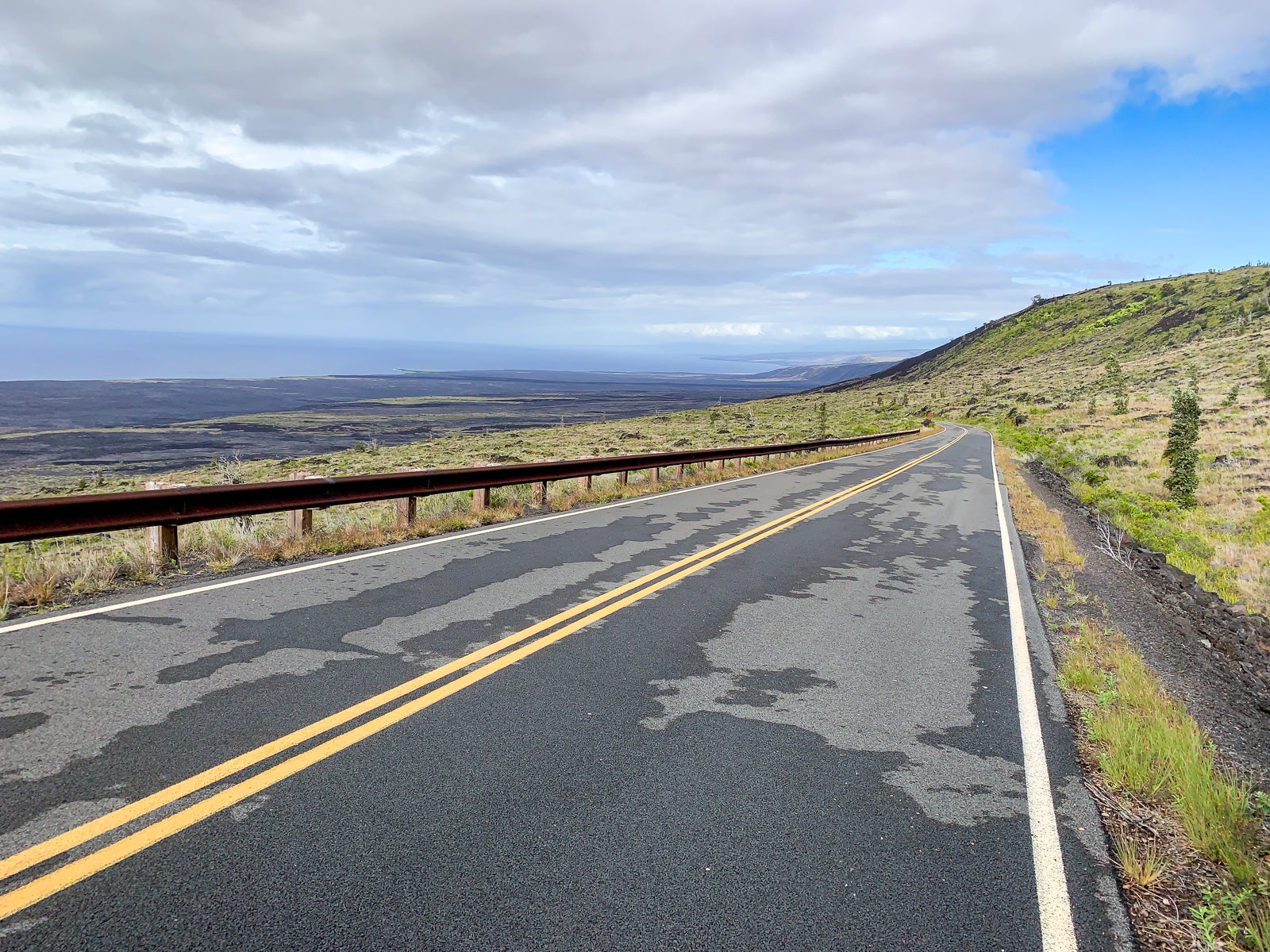
The road has a significant elevation drop of 3,700 feet, and it is therefore easy to figure out which way the lava is wont to go. We found unexpected beauty on our excursions onto the lava beds in the color variance of the lava itself, the artistic qualities of the random flow patterns and in the vegetation now calling the lava home.
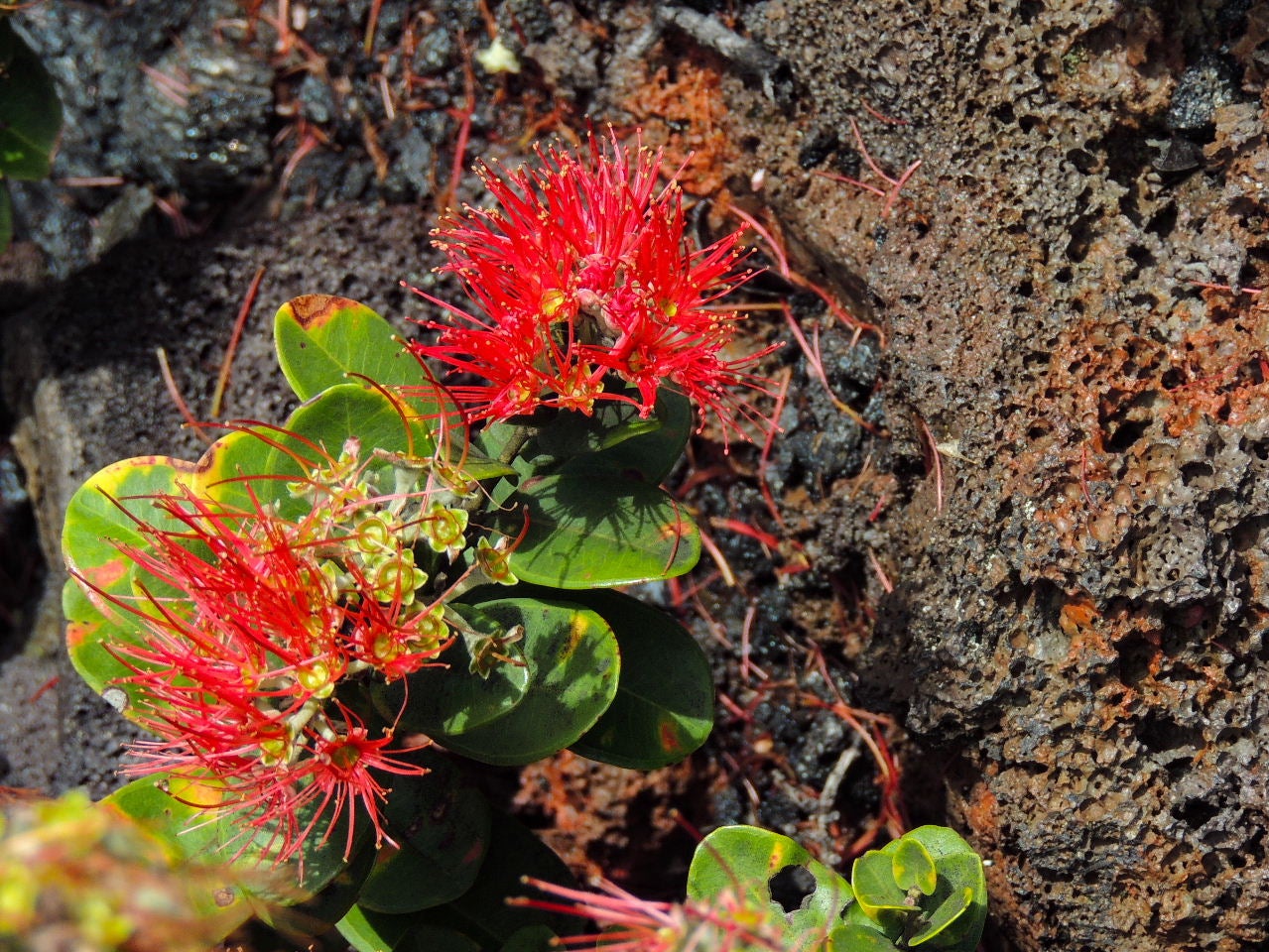
Following the road to its conclusion will lead you past the petroglyph fields to the Holei Sea Arch.
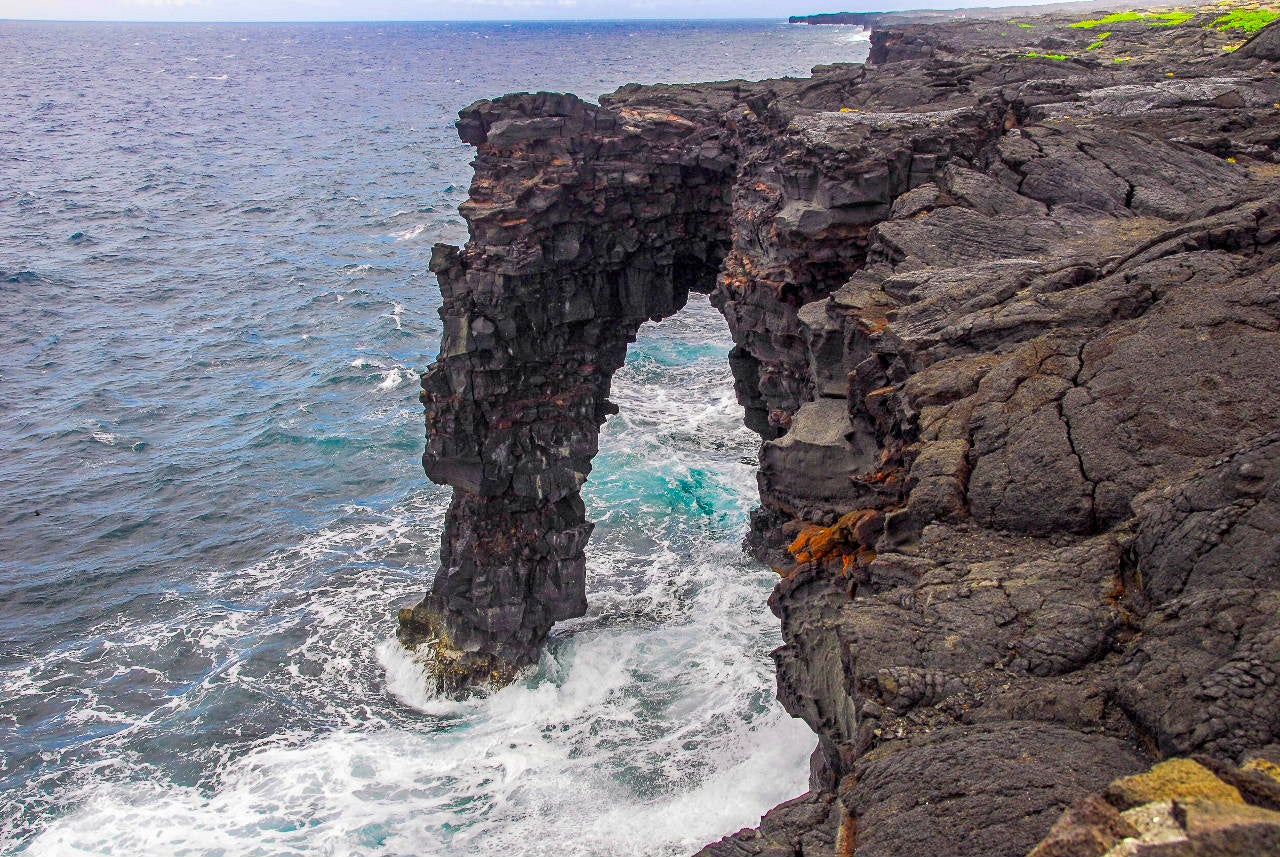
Just a short drive from the Visitor Center on the part of the Crater Rim Drive that is open, you will find Devastation Trail. This short hike gives you a graphic illustration of the dramatic environmental changes associated with this volatile area. A dense rainforest occupied this landscape prior to a 1959 eruption that left the area burned, barren and covered in a lava/cinder mix. As time has passed, nature has started its never-ending cycle to reclaim what was lost. Life is returning and, given enough time, will surely recreate its former self until ... it starts all over again.
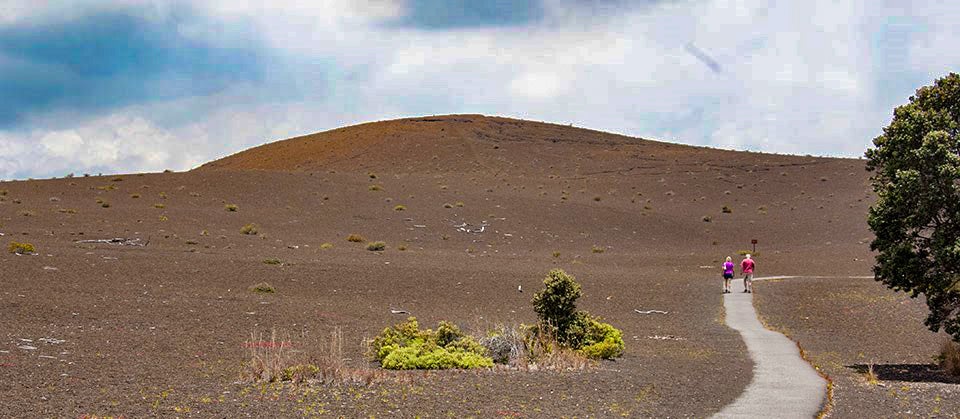
The Halema'uma'u Trail is another interesting, moderate hike that quickly takes you through some of the extremely diverse vegetative zones seen in this national park. The walk starts near the Volcano House and descends through an almost jungle environment that is wet, warm and very conducive to prolific plant growth. The forest trail is closely lined and canopied by huge healthy ferns and native trees and plants.
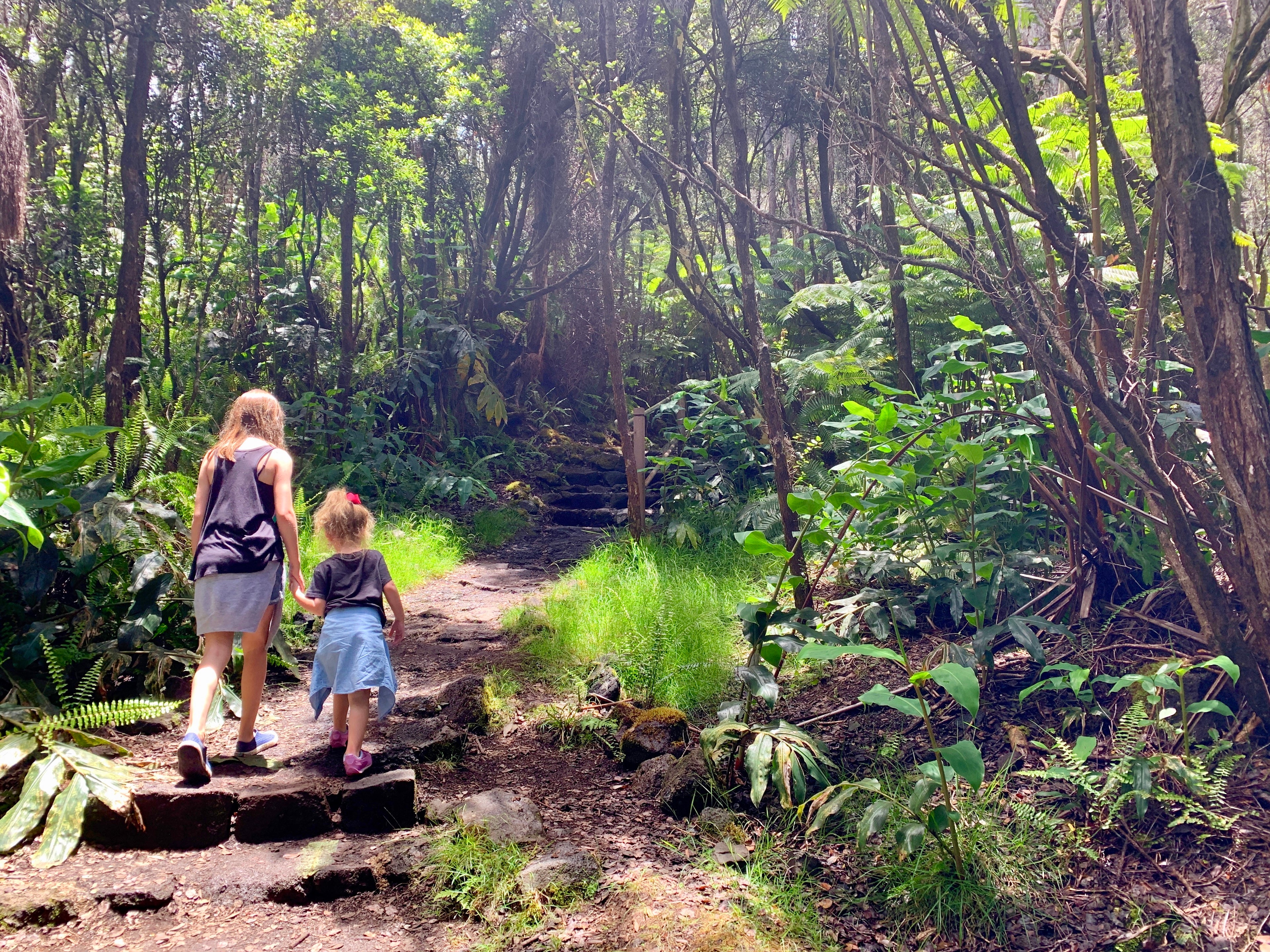
The hike takes you down about 500 feet in less than a mile as you essentially go down the sidewalls of the Kilauea Crater until you reach its caldera. Goodbye greenhouse, hello Mars.
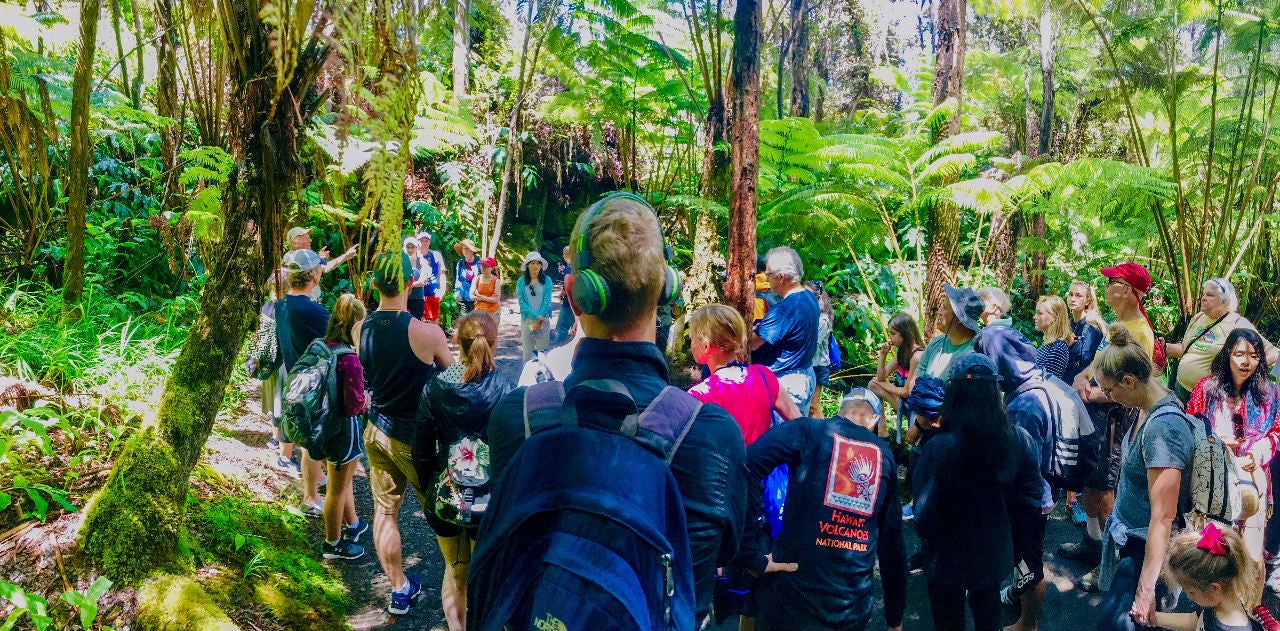
The hike used to continue to near the edge of the Halema'uma'u Crater, but the recent volcanic activity has restricted this access.
After the immersion in the contrasting temperature, exposure and landscape at the crater, you return up the tropical hillside. Our party of four ranged from a 4-year-old to a 70-year-old and all made the trek OK. A few strategic resting stops await those wishing for a quick break to either catch a breath or to linger a moment longer to absorb the surroundings.
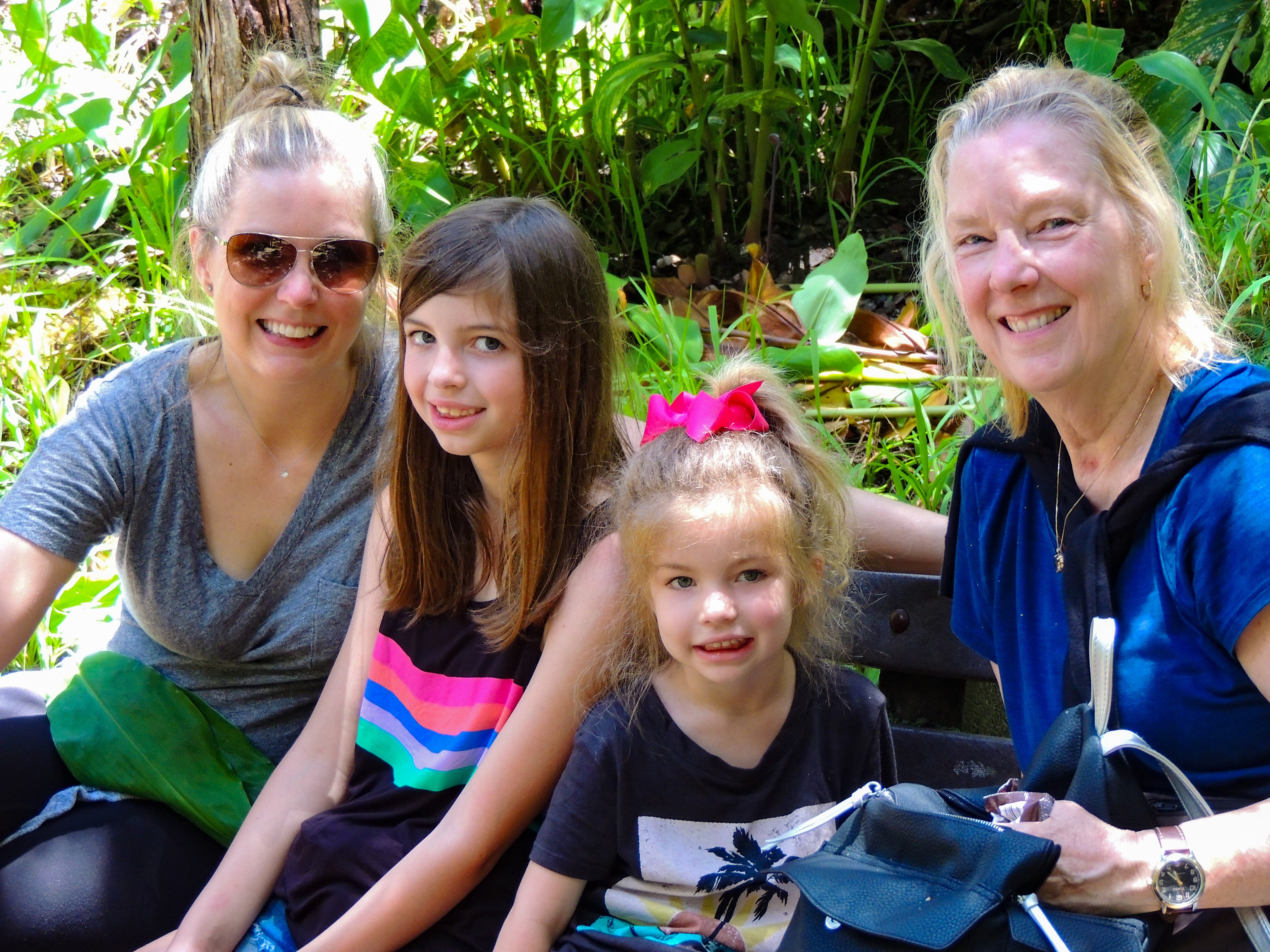
Where to stay at Volcanoes National Park
Lodging in the park is limited. The historic Volcano House has 33 guest rooms and sits adjacent to Halema'uma'u Crater on the Kilauea Caldera. Rates vary depending on date and type of accommodation, but average in the $250 to $350 per night range.
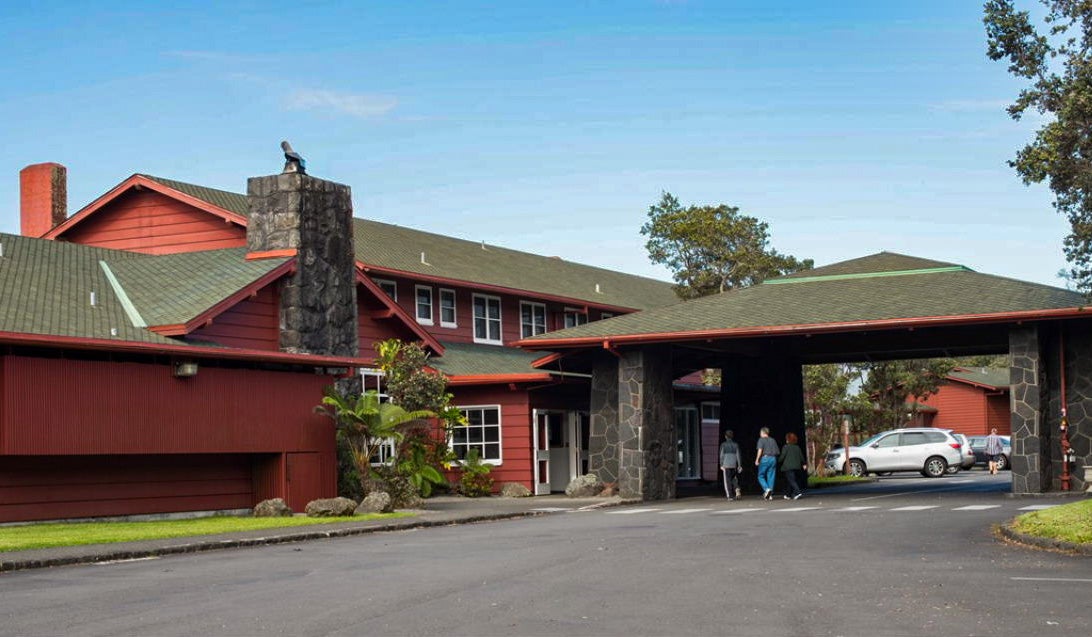
Ten rustic (read: basic) camper cabins are located nearby in the Namakanipaio Campground for $80 a night. Our one overnight stay was in one of these cabins. It proved to be quite adequate and a nice balance to the nicer resorts and hotels we experienced on the rest of our trip.
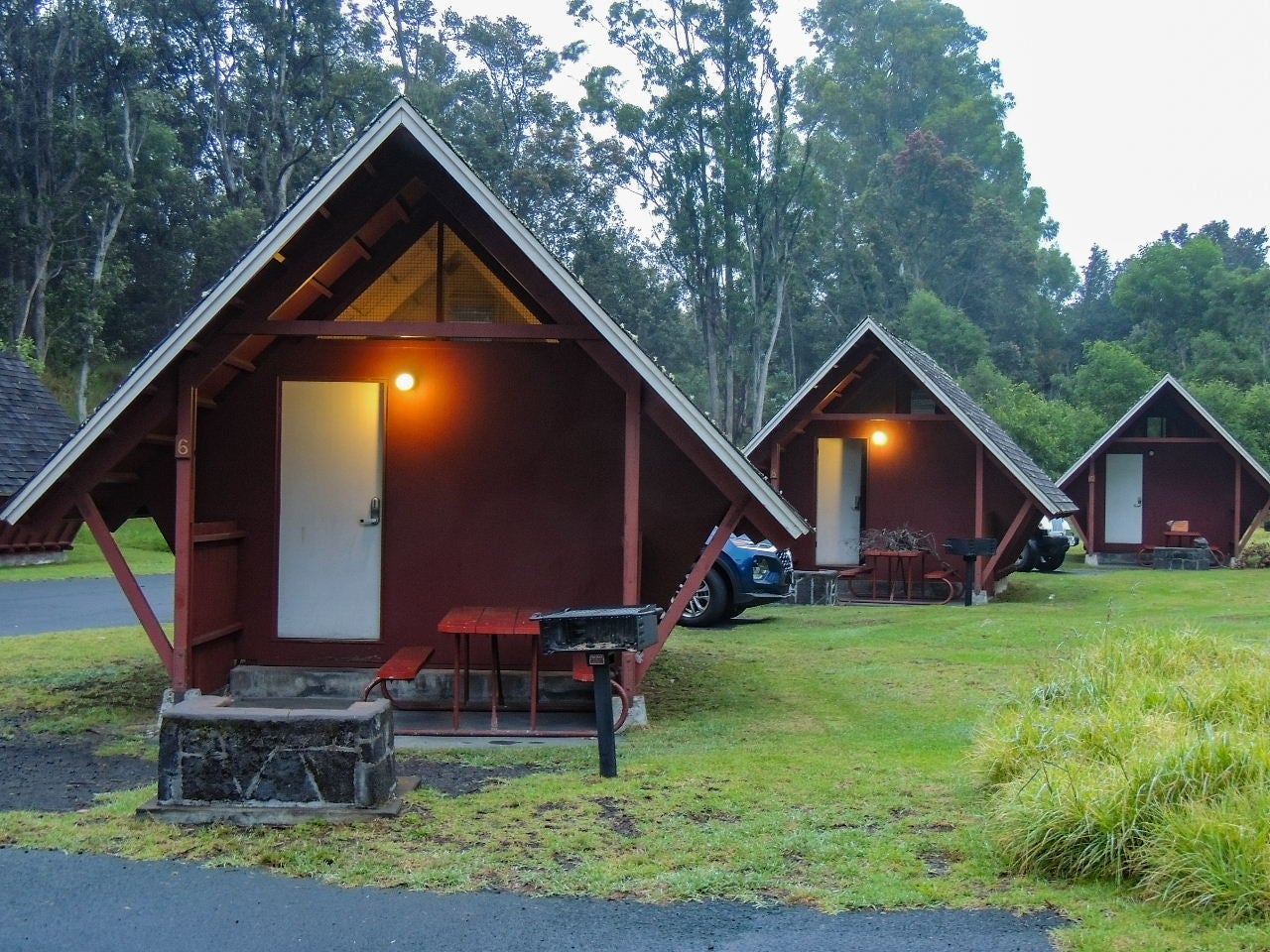
A limited number of campsites are also available in the park for $15 each. Additional lodging can be found 10 minutes away by car in Volcano Village, or 30 miles away in Hilo, where a wide array of options are located, such as the Hilton Naniloa in Hilo where we stayed using Hilton points the night after we finished exploring Volcanos National Park.
Where to eat
Pick up some fresh pastries at Punalu'u Bake Shop on your way into the park (if coming from the Kona side) and save those for snacks as there aren't a ton of dining options within the park. Volcano House does serve sit-down meals, but it can take a while and the cost of sit-down meals adds up.
There are a few other restaurants in the immediate vicinity, such as the Lava Rock Cafe, where we enjoyed chili and stir-fry one night, as well as a well-reviewed Tuk Tuk Thai Food Truck we missed on this trip.
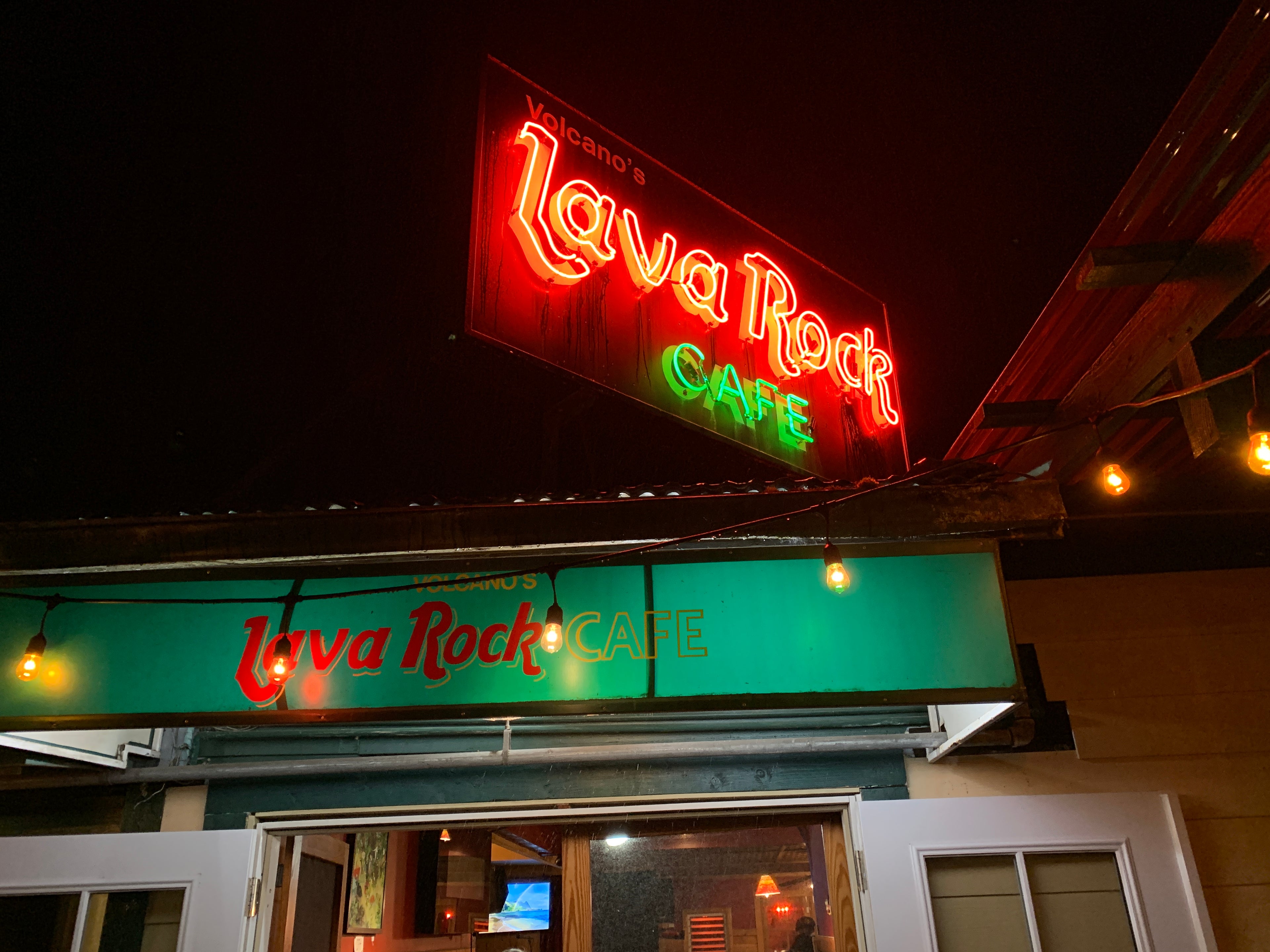
Surprises within the park
One of the bigger surprises that we learned was that the park is the 15th most-visited national park, with about 2.5 million annual visitors. We were amazed at this statistic because you do not just casually drop by the park to check out the lava. It is not like being at the Grand Canyon in Arizona when, on a spontaneous whim, you decide to head north to Utah to scout out the hoodoos in Bryce or The Narrows in Zion -- this one is over 2,300 miles of ocean away.
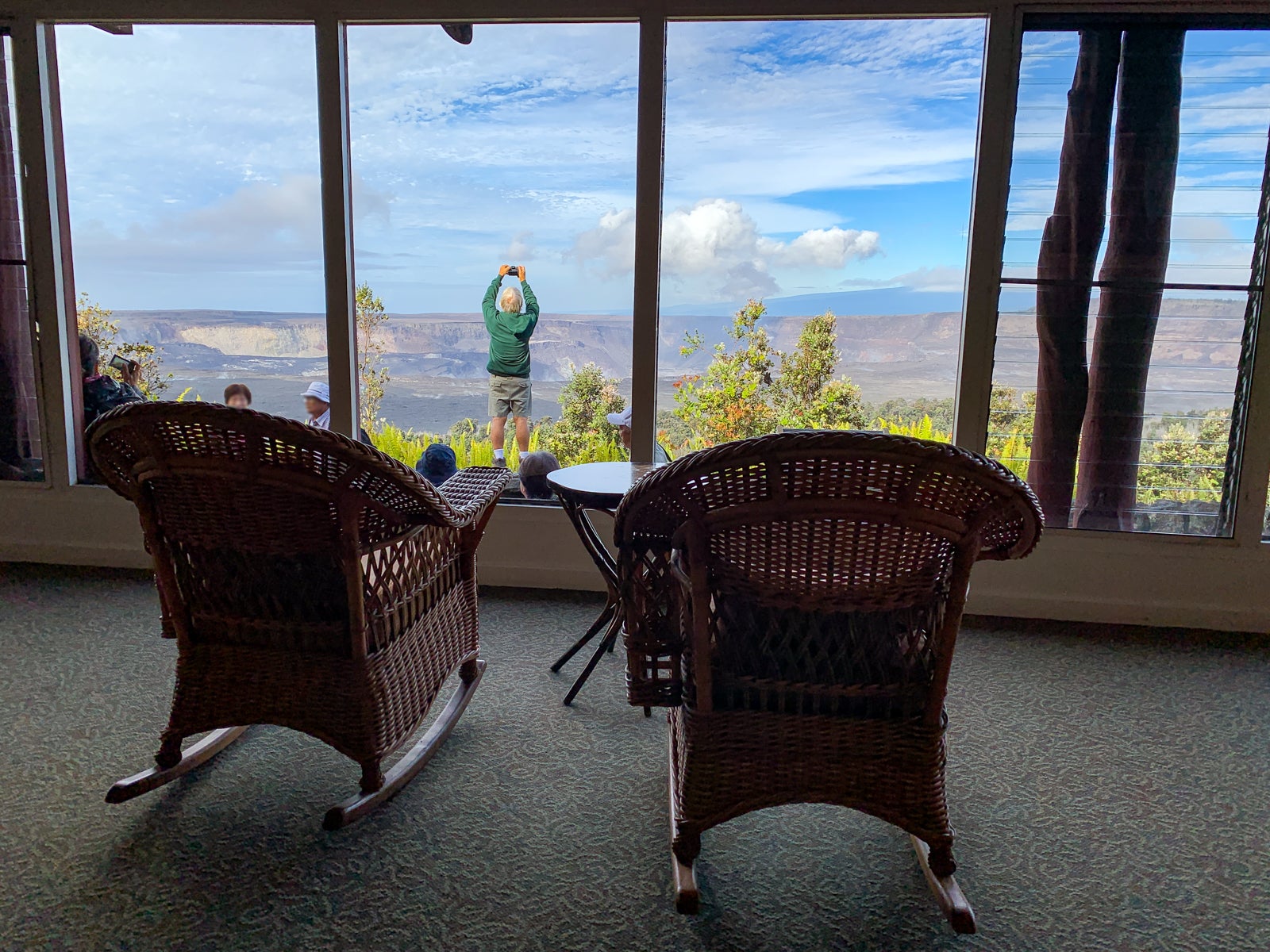
One jaw-dropping and smile-inducing experience we shared in the park was the perceived closeness and intensity of the stars. The Big Dipper was directly overhead, but its name truly did not do it justice. Maybe the Extra Large, Bigger, Badder, Bolder, Brighter Dipper would have been more appropriate. Each of the seven stars shined so brightly and so clearly that the stellar array seemed to be sitting just above the treetops. It was as if 5 watt bulbs had been replaced by 100 watters. We wished the opportunity to view the stars atop the nearby 13,500 foot Mauna Kea had presented itself on this trip. Mauna Kea is recognized as the top astronomical observation area in the Northern Hemisphere due to its elevation, clean air, cloud-free skies and dark nights. Next time, for sure.
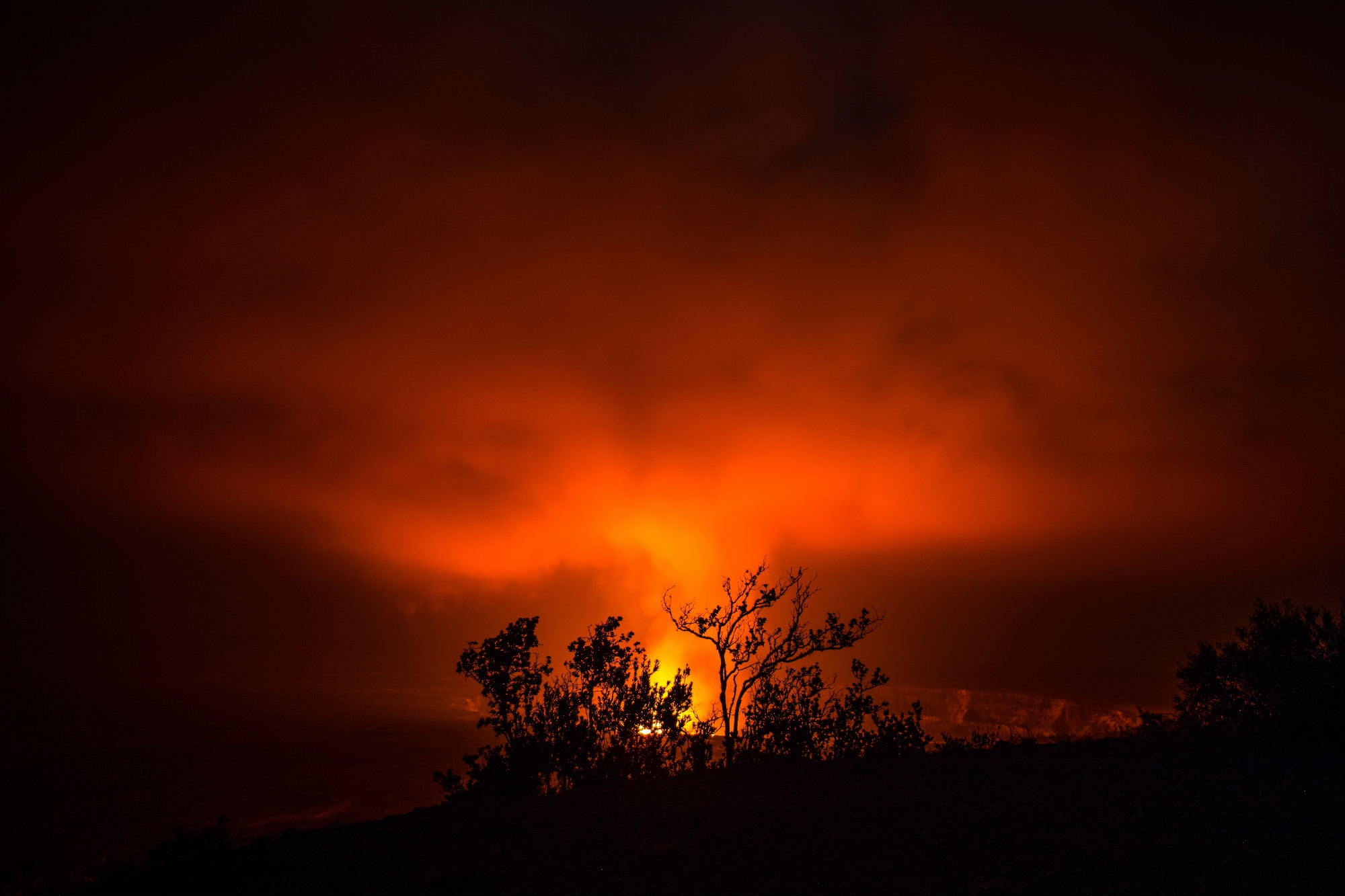
Bottom line
We hope to return to Volcanoes National Park someday. We really want to see those stars again and hope to see the lava lake in the Halema'uma'u Crater glowing like a cauldron with orangish-red lava streams flowing gently (and safely) to the sea. Pele, are you listening?

Hawaii Volcanoes National Park Itinerary (one, two, and half-day trips) 2024
Hawaii Volcanoes National Park is a very unique and special place to visit on the Big Island.
Hawaii Volcanoes National Park, established in 1916, is home to two of the world’s most active volcanoes – Mauna Loa and Kilauea. Kilauea is very popular as it erupted recently!
We spent a whole day exploring Hawaii Volcanoes National Park on my family trip to Big Island .
There are many amazing things to do in Volcanoes Park that we enjoyed, like hiking, seeing the volcanoes, walking on a volcano crater floor, seeing a 500-year-old lava tube, seeing lava glow in the dark (if there is volcanic activity), Sulphur banks, stargazing, and much more.
Even if you can only make a day trip to Big Island , I highly recommend visiting the Hawaii Volcanoes National Park, as it is the most popular thing to do on the Big Island.
In this article, you will find all the information you need to plan your Hawaii Volcanoes National Park visit for one, two, or even a half-day trip.
Volcanoes National Park 1 day itinerary – Top things to do in Volcanoes Park
The itinerary below will allow you to see and experience all the main sights of Hawaii Volcanoes National Park – do the most popular hike, walk through a lava cave and rainforest, and hopefully, see the lava glow at night (if there is volcanic activity happening during your visit).
Your start time will depend on whether you are staying in Hilo or Kona . Staying in Hilo or Volcano Park itself will make this one-day itinerary more feasible.
If you are coming from Kona, then start early, around 7 AM, so that you are in the park by 9 AM.
Overview of 1 day Volcanoes National Park Itinerary
Below is a quick version of how to spend a day in Volcanoes Park, seeing the main sights and attractions. Most of these are quick stops, with the exception of the Kilauea Iki Crater hike and Chain of Craters road drive.
- Start at the Kilauea visitor center – 30 minutes
- Kilauea Iki Crater hike – 2 hours
- Nahuku – Thurston Lava Tube – 30 minutes
- The Halema`uma`u crater Overlook at the Volcano House – 30 minutes
- Ha‘akulamanu (Sulphur Banks) – 30 minutes to an hour
- Wahinekapu (Steaming Bluff) / Steam vents – 10 minutes (view from the parking lot)
- Kilauea overlook – 30 minutes
- Chain of Craters road and Holei Sea Arch – 3 hours (if it’s not raining)
- Lava Glow at night from Devastation trail – 1 hour
Continue reading on to explore what to do at each of these stops and what to see. Honestly, there is so much to explore!
My favorites were the Kilauea Iki Trail hike (who doesn’t love walking on a lava crater floor!) and seeing the lava glow in the night. We were really lucky that Kilauea was erupting when we visited!
- Kilauea visitor center
Kilauea visitor center is a great first stop in the Hawaii Volcanoes National Park. The lobby features a lot of interactive displays about the park.
You can pick up a map and talk to the park rangers about current park conditions, learn about the hikes, and get information about the latest volcano eruptions.
The Kilauea visitor center is open seven days a week from 9 AM to 5 PM, except on holidays.
Time needed: 30 minutes to see the displays and get current conditions information.
Kilauea Iki Trail
If you have time to do only one hike on the Big Island, then it should be the Kilauea Iki Trail .
This is a unique hike as you walk inside the Kilauea Iki volcano crater and through a beautiful lush rainforest. Plus, at the end, you can visit a lava tube!
This trail starts at the Kilauea Iki trailhead parking lot. The total roundtrip distance is around 3 miles and has an elevation of around 700 feet as you climb down the crater and back up. But it is not very hard to do, more like moderate.

I recommend doing this trail counterclockwise from the Kilauea Iki trailhead parking lot, which is what we did. The crater has a lot of huge lava rocks and broken earth surfaces in many places.
You get some really beautiful views of the crater from the Kilauea Iki overlook . The crater is so big that pictures do not do justice, as you cannot capture the entire crater from the hike.
You have to see this one! The crater is so huge that people look like ants on the trail from afar.
The way back up passes through a beautiful rainforest, and the coolness of the rainforest is welcoming after walking across the crater.
Time needed: Around 2 hours.
- Nahuku – Thurston Lava Tube
If you did the Kilauea Iki Crater hike counterclockwise on the way back to the parking lot, make sure you visit the Nahuku – Thurston Lava tube .
It’s a huge 500-year-old lava cave, and it is incredible to walk through it. The total walk is less than half a mile and is easily doable by all. There are no steps in the lave tube.
The lava tube has lights inside during the day from 8 AM to 8 PM. You might need a headlamp or phone light here for some dark areas.
There might be some water puddles on the floor of the cave and some low ceilings for which you might need to watch your head. It was really cool and refreshing inside the cave after the hike through the crater.
Time needed: Around 30 minutes to explore the lava tube.
- The Halema`uma`u Crater Overlook at the Volcano House

After your hike, stop by the Volcano House to take in the view of the Halema`uma`u crater from their large overlook area. The Volcano House is opposite the Kilauea Visitor Center.
When we visited, we could see steam coming out of the crater during day time. You can take beautiful pictures from the overlook with the crater in the background.
The Volcano House has guest rooms, cabins, and campsites if you want to spend the night in the volcano park. It also has a restaurant, gift shop, and restroom facilities.
Time needed: 30 minutes to see the overlook, more if you plan to have lunch at the restaurant.
Crater Rim Drive
Crater Rim Drive is the main road in the park that goes around the Kilauea caldera and the Halema`uma`u crater. Everyone visiting the park is driving on this road, even if unknowingly!
The main part of the road, which has all the attractions, is from Kilauea overlook to the Devastation trail area and is around 5.5 miles.
After the recent Kilauea eruptions, you can no longer drive the full perimeter of the Crater Rim Drive.
Time needed: It will take around 20 minutes by car from Kilauea overlook to the Devastation trail area without any stops. But you will likely make the stops below along the Crater Rim Drive. Don’t worry if you do not have time to do all the stops if you are short of time.
- Ha‘akulamanu (Sulphur Banks)
The Sulphur Banks can be accessed via the short Sulphur Banks trail from either the Visitor Center or the Steam Vents parking lot. It is a total 1.2-mile loop.
There is a paved trail at first, and then a boardwalk to see the Sulphur vents up close. Please stay on the designated trails here, as wandering off the trail could be dangerous!
At Sulphur Banks, you will see the volcanic gases and steam emitting from the earth’s surface, some cool rock formations, and yellow mineral deposits. The smell of Sulphur is pretty strong here, but a mask can help make it tolerable.
If you haven’t seen Sulphur banks before then make sure to stop by. I found it very similar to Yellowstone and Lassen National Park .
There are signs that say that the gases might not be suitable for pregnant women and very young children, as well as people with respiratory diseases.
Time needed: Around an hour to see the Sulphur Banks.
- Wahinekapu (Steaming Bluff) from Steam Vents parking lot
Wahinekapu (Steaming Bluff) viewpoint is a short walk from the Steam Vents parking area on Crater Rim Drive.
Here you will see hot steam coming from the earth’s surface, which is due to groundwater falling on hot rocks and vaporizing.
There are some Steam Vents right near the parking lot, which feel like a sauna when you stand near it! A cool experience.
Time needed: Just 5-10 minutes stop if viewing the Steam Vents from the parking lot. If exploring the trail to Steaming Bluff, then 30 minutes to an hour.
- Kilauea overlook

The Kilauea overlook on the Crater Rim Drive provides the best views of the Kilauea caldera and the Halema`uma`u crater. This is also a great spot for viewing the glow of the lava in the dark.
There is a parking lot at the overlook. It is a short walk up a paved trail to various viewpoints. This is the closest you can get to the Kilauea caldera safely.
Time needed – 30 minutes.
- Chain of Craters Road
The Chain of Craters scenic drive is within the Hawaii Volcanoes National Park and is 19 miles long that takes you to sea level.
Along this drive, you will see volcano craters and rocks of varying sizes on both sides of the road. There are several hikes and vistas to explore along the way.
At the end of the Chain of Craters road is the Holei Sea Arch, which is a 90-foot-high arch carved in the lava rocks due to erosion and is impressive to see.
You will need to walk around 1000 feet at the end of the road to get to the arch viewing area.
Time needed – Around 3 hours for the drive and a couple of stops. Driving all the way to the ocean and back will take around 2 to 2 and a half hours, so make sure you have enough daylight hours and gas in your car to complete this drive.
- Pu‘uloa Petroglyphs
Pu‘uloa Petroglyphs are ancient carvings in hundreds of years old lava rocks that depict the life and culture of Native Hawaiian people. It represents hopes of a long and prosperous life, and Puuloa means ‘hill of long life.’
Pu‘uloa Petroglyphs are towards the end of the Chain of Craters road, just before the Holei Sea Arch, and accessible by a short 1.2-mile out-and-back hike, starting at the Puʻuloa parking area.
The initial part of the hike is over a rocky lava field, and the later part is over a boardwalk built to view the Petroglyphs and protect them from foot traffic.
It can be very hot here in the mid-day, and there is no shade. Good hiking shoes, water, sunscreen, and hats are recommended, as the trail is rocky at the beginning.
Time needed: 30 minutes to an hour. It might be hard to fit this in a 1-day itinerary, depending on what other hikes you are planning to do in the day.
- Devastation Trail and nighttime lava glow sighting

Lava sighting depends on whether any volcanic activity is going on when you visit. When we visited, the Kilauea volcano was active at that time.
If there is volcanic activity, you can stay in the Volcanoes Park after dark to see the lava glow.
The easiest way to see lava glow is from the Keanakākoʻi Overlook, which can be reached by a short hike from the Devastation trail parking lot.
Park at the Devastation trail parking lot during sunset and walk the short and easy trail to the Keanakākoʻi Overlook. From here, you can see Halema`uma`u crater and any lava activity and glow.
We were incredibly lucky to see the red glow of lava when we visited. It was a surreal experience to walk at night on the trail. The stars are usually bright and beautiful in the clear, dark night sky as there is no light pollution here.
There were a lot of people on the trail, so it was easy to find our way to the overlook to see the glow and back to our car. We just followed the crowds!
Time needed: One hour for the walk and viewing the glow.
Stargazing at Hawaii Volcanoes National Park
Although the Maune Kea mountain peak (also in Big Island, Hawaii) has the largest research observatory in the world, Hawaii Volcanoes Nation Park is also an excellent place for stargazing.
There is no light pollution for miles here, and on a clear night, you can see brilliantly shiny stars from anywhere in the park, just look up.
You can use a stargazing app on your phone to identify some stars and constellations.
I bet that was a lot of information about the Hawaii Volcanoes National Park attractions!
Remember, you do not need to do everything above and feel rushed. Pick a few that appeal to you most and enjoy them!

Half-day trip to Volcanoes National Park Itinerary
With so much to see and experience in Hawaii Volcanoes National Park, I would not recommend spending just a half day here.
That said, if you are really pressed for time, then plan to either arrive before sunrise or arrive later in the day and stay till dark so that you can have a chance to see the lava glow.
You can still do everything below in half a day; I would skip the Chain of Craters Road drive as it is very long and can take up to 3 hours.
Hawaii Volcanoes National Park half-day itinerary:
Volcanoes national park 2 day itinerary.
If you plan to stay overnight in Hawaii Volcanoes National Park, you will have more time to explore the many attractions and hikes in the park.
You can drive the Chain of Craters road on the second day and explore more stops along the way.
Pu‘uloa Petroglyphs hike would be a good addition to your 2-day itinerary. You can also explore any of the additional hikes below:
Hawaii Volcanoes National Park Hikes:
If you have two days in the Volcanoes Park, then on the second day, you can explore some more hikes in the park.
Devastation Trail to Puʻupuaʻi Overlook hike
Devastation Trail to Puʻupuaʻi Overlook is an easy 1 mile out and back hike from the Devastation trail parking lot to the Puupuai overlook.
From the Puupuai overlook, you can enjoy the views of the cinder cones in the Kilauea Iki crater.
The hike is paved and fairly easy to do. It is wheelchair and stroller-friendly, but some parts might have a slight uphill grade.
Time needed: 30 minutes
Halema‘uma‘u trail hike
Halema‘uma‘u Trail is a moderate 1.7 mile out and back trail with around 450 feet elevation. The trail can be started from the Kilauea visitor center (longer) or Volcano House (shorter).

The trail starts by descending through a lush rainforest to the floor of the Halema‘uma‘u crater.
You can extend the hike from the crater by connecting with the Kilauea Iki Trail or Bryon Ledge Trail and making it longer.
Time needed: It can take you anywhere from 2 to 5 hours, depending on if you combine it with other trails or just return once you reach the crater floor.
Uēaloha (Byron Ledge) Trail hike
Byron Ledge Trail is another trail in the same area at the edge that separates the Halema‘uma‘u crater from the Kilauea Iki crater. After the recent eruptions, only a portion of this trail is open.
You can access this trail from the Devastation Trail parking lot and can combine it with Halema‘uma‘u Trail or Kilauea Iki Trail to make it longer.
Time needed: It can take you anywhere from 1 to 5 hours, depends whether you combine it with other trails or just return back once you reach the edge of the craters.
Hawaii Volcanoes National Park tours
Are you looking to take a tour to make sure you don’t miss the must-see sights in Big Island and Volcanoes National Park?
There are excellent full-day volcano tours from Kona . If you are staying in Hilo, there are several half-day Volcano tours from Hilo as well.
Below are some of the best tours that cover a lot in a short time –
Best day tours for Volcanoes National Park:
Looking for a day trip to volcanoes park from oahu.
Day trip from Oahu to Volcanoes National Park and Hilo – Includes inter-island flights and a ground tour of the Big Island that covers top sights in Volcanoes Park and Hilo!
Things to do near Hawaii Volcanoes National Park
If you are staying in the Hilo region or Volcano Park for a few days, then below are some great places to visit in the east and south regions of the Big Island, Hawaii.
Punalu black sand beach
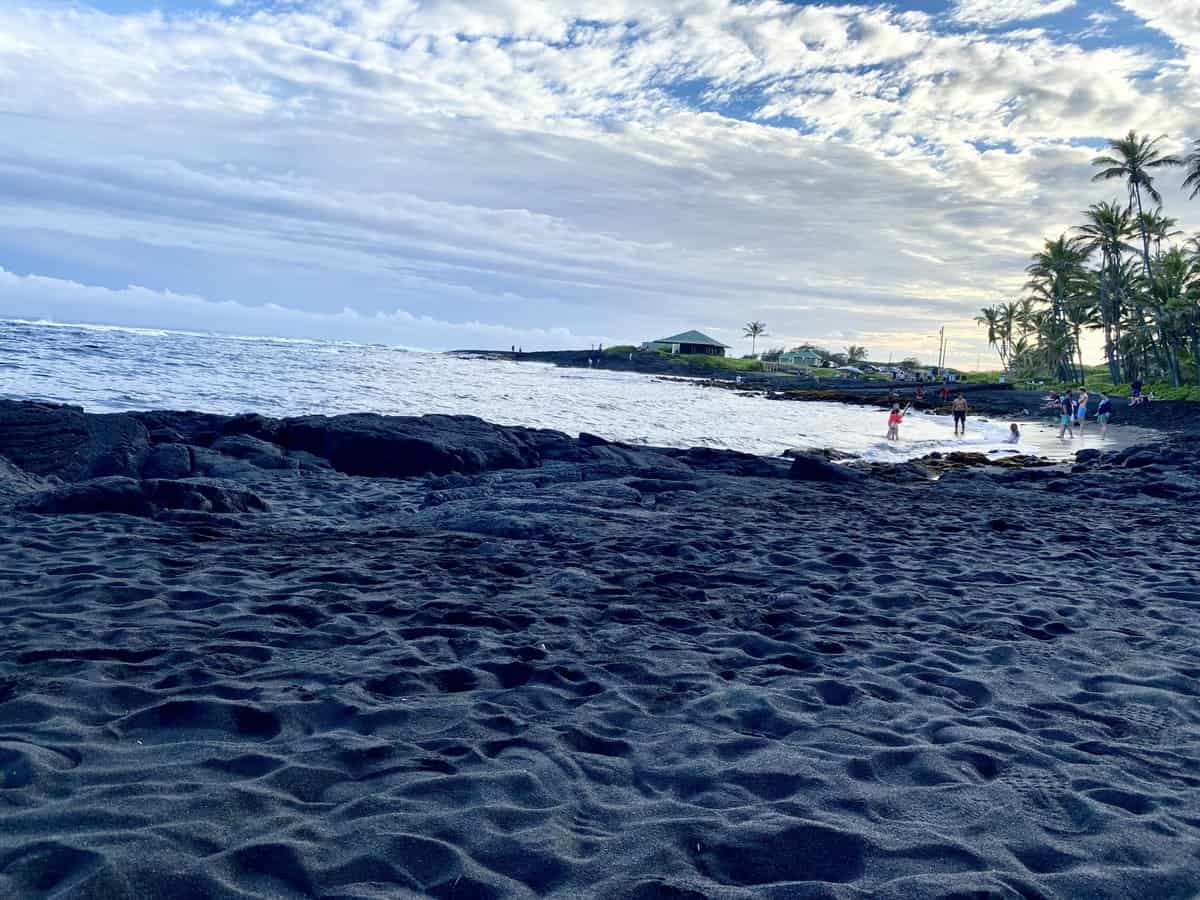
No matter how many days you are spending on the Big Island, I believe the Punaluu black sand beach must be on your to-do list for sure, as it is unique.
The sand is actually tiny particles of black lava rocks and looks like black sand. You can spot some sea turtles in the water if you are lucky.
Swimming or snorkeling should be attempted here only if the water is calm, as sometimes the rip currents can be strong here. Snorkeling in Kona is better than on the eastern side of Big Island.
Punaluu Black Sand Beach is on the southeast part of the Island and is around a 30-minute drive from Volcano Park and a 1-hour drive from Hilo.
Explore Hilo
Explore the town of Hilo by visiting the downtown Hilo region. Visit Coconut Island, a small island accessible by a pedestrian bridge on Banyan Drive.
You can see incredible views of Mauna Kea mountain peak from Coconut Island on a clear day.
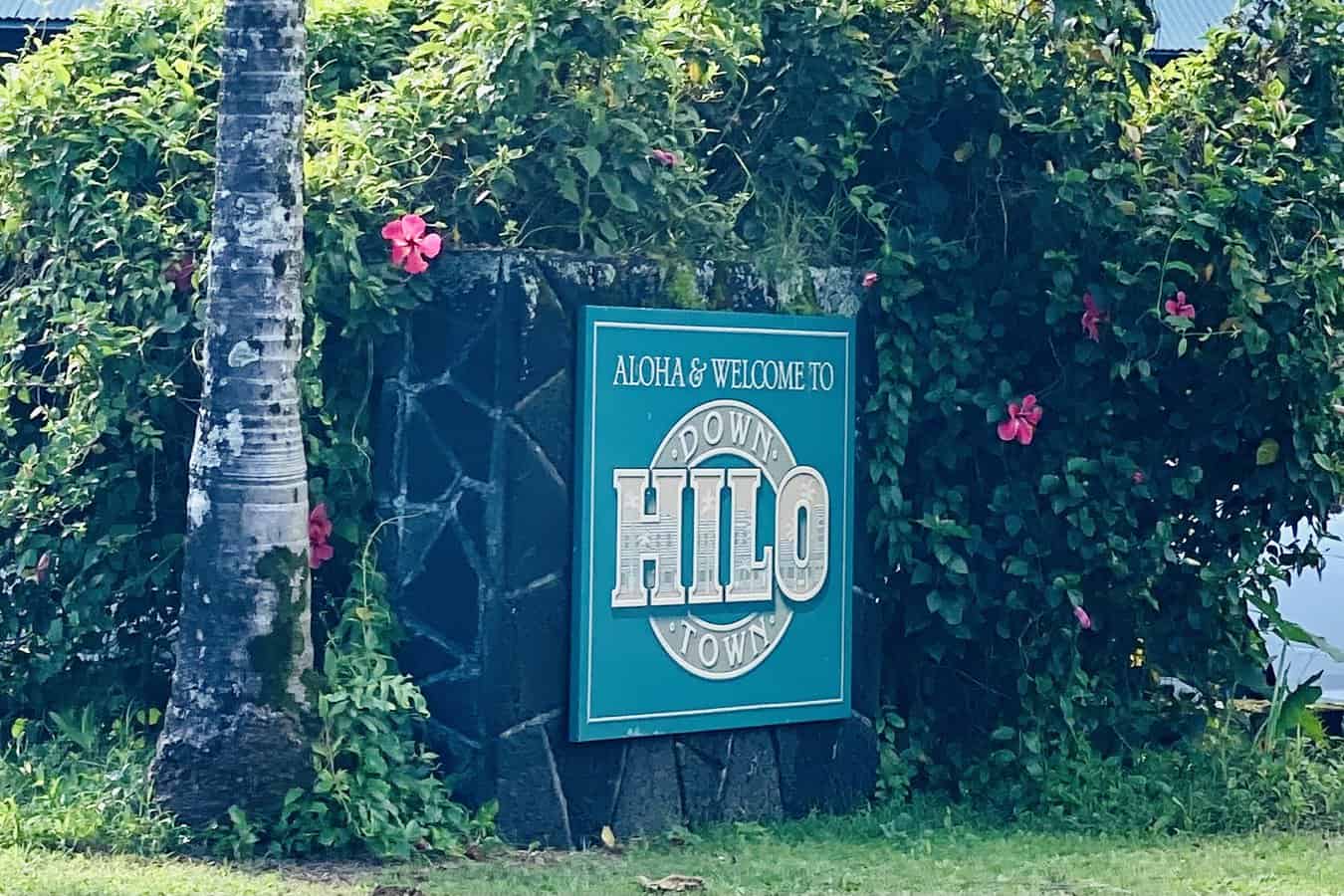
Walk along Banyan Drive, which is lined by massive banyan trees. The Banyan drive is called the ‘Hilo Walk of Fame ‘ as celebrities planted these banyan trees.
In front of each banyan tree is a plaque that lists the celebrity who planted it. Each banyan tree with its roots hanging from the branches and touching the ground seems like a mini forest!
Liliuokalani Park is a beautifully landscaped park in a Japanese garden style near Coconut Island.
Visit the various waterfalls in Hilo, like Akaka Falls, Rainbow Falls, and Peepee Falls. If you have time to visit only one waterfall on the Big Island, then it should be Akaka Falls and Akaka State Park .
Tips for visiting Hawaii Volcanoes National Park

Below are some tips that will help you have a great day in Hawaii Volcanoes National Park.
Carry your essentials
Carry essentials like a headlamp, park map, rain jacket, reusable water bottle, snacks, and sturdy closed-toe shoes. Bring hiking poles also if you use them.
Consider using an audio tour app on your phone.
If you are taking a rental car on the Big Island and driving yourself, I highly recommend using an audio-driving tour.
Audio tour guides are really helpful in exploring the Big Island, and they have a Hawaii Volcanoes National Park tour you can buy.
The app uses your phone’s GPS location and gives you information about upcoming stops and attractions.
➡ Big Island Adventure Bundle – 5 audio tour routes covering the entire Island.
➡ Hawaii Volcanoes National Park Audio Tour – Audio tour for just the Volcanoes Park.
Stay on the designated trails.
Make sure to follow the park rules, trail boundaries, and signs. Stay on the trails. It can be dangerous to wander off the trail here due to unexpected collapses and cracks in the surface.
Follow the Ahu (stacked rocks)
The park rangers here often mark trail paths with a small pyramid of lava rocks which are called ‘ahu.’ It is a unique thing on the Big Island! Do not change the rock stacks or create your own, please!
Fun fact about Hawaii Volcanoes National Park
Did you know that the Big Island keeps growing in size with each volcano eruption? To learn more about the unique history of Hawaii Volcanoes National Park, visit the National Parks Service official website.
How to get to Hawaii Volcanoes National Park
You can either drive yourself to Volcano Park or book a volcano tour from either Kona or Hilo.
Drive to Volcanoes Park
You will need a rental car to drive yourself to Hawaii Volcanoes National Park to see the many attractions, views, and vistas.
I recommend booking your rental car with Discover cars as they check the top rental car brands and offer the best rates!
If driving yourself, I highly recommend getting an audio tour for your car like this Hawaii Volcanoes National Park Audio Tour or Big Island Adventure Bundle that covers the whole island!
Park hours and admission fees
Hawaii Volcanoes National Park is open 24 hours a day, all year, even on holidays. You must pay the entrance fee below to visit the Hawaii Volcanoes National Park.
- Private Vehicle ($30, valid for seven days)
- Motorcycle ($25, valid for seven days)
- Individual/Bicycle ($15, valid for seven days)
Where to stay for Hawaii Volcanoes National Park
Many travelers opt for a day trip to Volcanoes Park from Kona, home to some of the best resorts on the Big Island .
However, it’s worth noting that Hilo is closer to the volcano park, and staying in Hilo provides quicker access to the park.
There are also accommodation options available near the Volcanoes Park as well for those who wish to stay in the area.
Where to stay in Kona-Waikoloa
Hilton Hawaiian Village is an excellent ocean-front resort in North Kona’s Waikoloa region. This is the best place to stay for families or friends looking for a very happening resort. The pool complex here is massive, and the resort is huge with a lagoon and resident dolphins!
Courtyard by Marriott King Kamehameha’s Kona Beach Hotel is at a great location in downtown Kona and has a beach right out front. Great for families looking for some snorkeling fun. Kona’s Alii Drive is within walking distance.
There are several vacation rental home and condos in Kona if you are looking for more space and a kitchen. Ideal for families or longer stays!
Kona is a great place to stay if you want to do water excursions like taking a Kona sunset cruise or relaxing on the white sand beaches in Kona.
Where to stay in Hilo
Hilo is only 45 minutes away from Volcanoes Park and is a great place to spend a couple of nights and make a day trip to Hawaii Volcanoes National Park.
Banyan Drive is where most of the better hotels are in Hilo. There are fewer hotel options in Hilo than in Kona.
We stayed at the Hilo Hawaiian hotel on Banyan Drive, for two nights, and it was very comfortable with great views of the Coconut Island and Mauna Kea summit. The oceanfront location was excellent, and we enjoyed the pool and gardens.
Grand Naniloa Hotel by Doubletree Hilton is the only brand-name hotel on the Hilo side. It is also on Banyan Drive with excellent ocean views.
Hilo also has many great vacation rental home and condos for longer stays or if you need a kitchen.
Where to stay in and near Volcanoes Park
If you want more time to explore the Volcanoes park, staying closer to the Volcanoes park is a better option.
Kilauea Lodge is just 1 mile from the Hawaii Volcanoes National Park and has an in-house restaurant. Great place to stay close to the park.
The Volcano House is the only option to stay inside the National Park, with great views of the Halema`uma`u crater from the overlook. It has guest rooms, cabins, and campsites.
The Volcano Village near Volcanoes Park has several amazing vacation rentals and condos for your stay.
Hawaii Volcanoes National Park: FAQs
Below are some frequently asked questions about Hawaii Volcanoes National Park to help plan your trip to this very special place!
Where is Hawaii Volcanoes National Park?
Hawai’i Volcanoes National Park is in the southeast region of Big Island, Hawaii. It takes around 2 hours to drive each way from Kona to Volcanoes Park.
If doing a day trip to Hawai’i Volcanoes National Park from Kona, make sure to start really early in the day. Visiting the Volcanoes Park is one of the most popular excursions in Kona .
Volcanoes Park is more easily accessible from the Hilo region and is only 45 minutes from Hilo downtown. I visited Volcanoes Park from Hilo, and it was the perfect day trip to Hawaii Volcanoes National Park.
Is Kilauea volcano erupting?
The Kilauea volcano has been very active and erupting since September 2021. Before your visit make sure to check the current conditions of volcanic activity at the Hawaii Volcanoes National Park official website .
Which is the best month to visit Hawaii Volcanoes National Park?
The best months to visit Hawaii Volcanoes National Park are generally during the drier season, from April to October, due to better weather, clear skies, and more accessible trails.
However, visiting Hawaii during the winter months (November to March) can also be rewarding if you don’t mind the rain and want to see lush landscapes.
We visited Big Island and Volcanoes Park in January’s first week during the school break, and it was great. We didn’t encounter that much rain, only once or twice in 7 days, and it only lasted an hour or so. Make sure to check park conditions before your visit.
It does snow in Hawaii Volcanoes National Park in winter, but only on the mountain peaks of Mauna Loa And Mauna Kea. We did not see any snow while exploring the National Park in winter.
What is the best time of day to visit Hawaii Volcanoes National Park?
The best time of the day to visit Hawaii Volcanoes National Park is from before sunrise to evening or afternoon to after dark.
Make sure you are there for some time when the sky is dark so you can see any volcanic activity and experience stargazing.
How much time do you need at Volcano National Park Hawaii?
You should plan to spend one full day at Hawaii Volcanoes National Park. At least a day is needed to see all that it has to offer.
Staying overnight in the park is also an option; otherwise, staying in Hilo is the best way to maximize your time in the park and explore Hilo waterfalls and town.
Final Takeaways: Hawaii Volcanoes National Park itinerary for half, 1, or 2 days
I hope you have all the information you need to plan your visit to Hawaii Volcanoes National Park.
There is so much to see and experience here, from exploring lava tubes and hiking in volcanic craters to marveling at active volcanic activity or simply taking in stunning landscapes.
Below is a summary of everything we covered in this post.
Top 13 things to do in Hawaii Volcanoes National Park:
- Kilauea Iki Trail (best hike!)
- Crater Rim drive
- Holei Sea Arch
- Stargazing after sunset or before sunrise
Hawaii Volcanoes National Park is a sacred place for the people of Hawaii and an amazing, powerful land to visit!
More about Big Island
Visiting Big Island, Hawaii? Check out my other posts in the Big Island series:
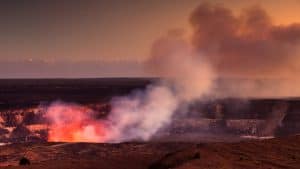
Best Volcano tours from Kona

Best Volcano tours from Hilo, Hawaii
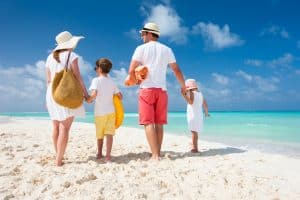
9 Best Resorts on Big Island for Families
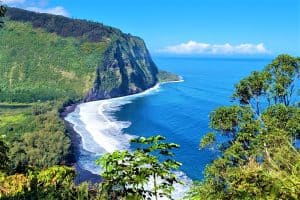
BEST 7 day Big Island itinerary for epic Hawaii vacation

Big Island one day itinerary suggestions
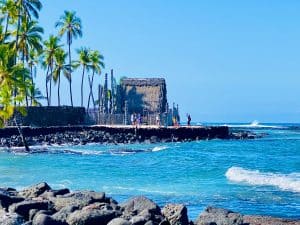
Kona tourist attractions- 45 BEST things to do in Kona, Hawaii
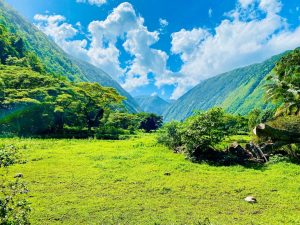
Hilo vs Kona- Which side of Big Island to stay?

Hiking the unique Kilauea Iki Trail in Hawaii Volcanoes Park
Anu Agarwal is the founder and author of vacation travel blog Destination Checkoff. Anu, a Northern California resident, and a regular nine-to-fiver, loves to vacation with her family to destinations all over the world. She is obsessed with doing endless research for her trips. She has traveled to several destinations in the United States, Canada, Mexico, Europe, and Asia. With her blog, Anu is excited to share her destination itineraries and vacation travel guides and help you check those dream destinations off your bucket list!

1 Day Ultimate Hawaii Volcano National Park Itinerary
Walk along the crater ridge, explore the inside of a lava tube and drive down to the coast to see the ancient petroglyphs. Hawaii Volcano National Park is full on interesting and unique experiences that make the perfect day trip while in Hawaii. This Volcano National Park itinerary will tell you exactly how to plan your trip including general information as well as suggestions of how to organize your time in the park.
We spent a day exploring Hawaii Volcanoes National Park and were blown away by the scenery and experience. You can see more about planning a your visit to this national park on our Hawaii Volcanoes page or check out our 2 day itinerary to the Big Island of Hawaii.
You can find the itinerary for this park in the first section below. If you are looking for more information on planning your visit, continue scrolling to the bottom of this post.
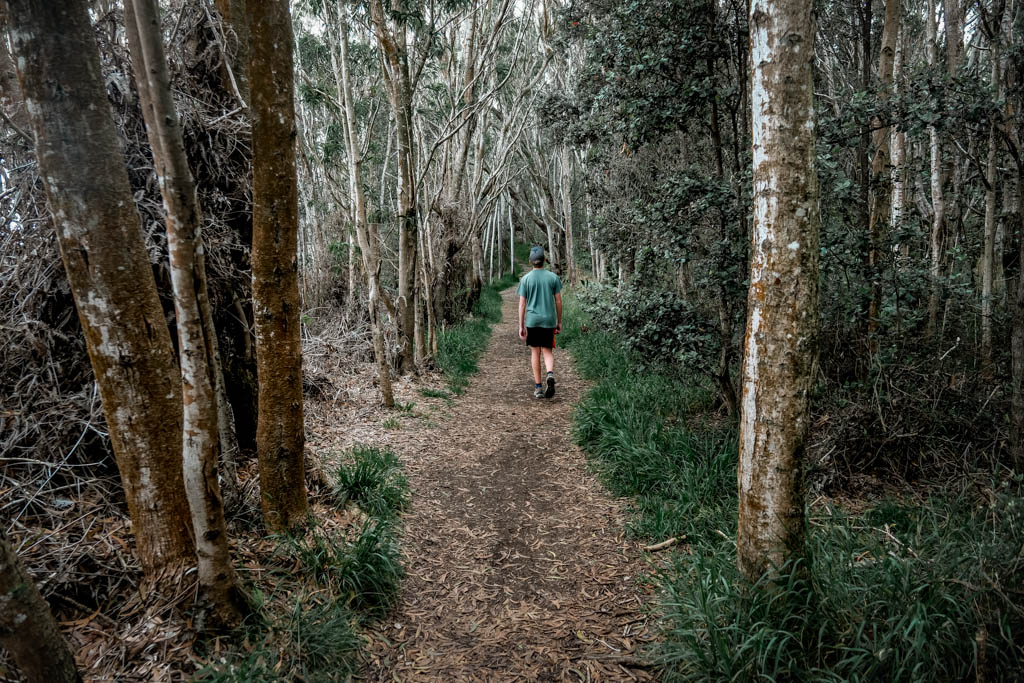
An Overview of the Park
In this Hawaii Volcano National Park itinerary, you will see the highlights of the park including exploring the region around the crater as well as the sites down Chain of Craters Road. You can easily spend a half day exploring the park just around the crater and then take the afternoon to drive down to the coast.
The drive down Chain of Craters Rd to the coast takes about 1.5 hours and offers incredible views and a different perspective on the park. Most of the hikes throughout the park are short and easy so you can do several short hikes throughout the day.
With just one day, you won’t have quite enough time to visit Mauna Loa unless you are up for a longer day of driving.
See the Best Hikes in Hawaii Volcanoes National Park.
Top Volcano National Park Tips
- Follow all safety signs and note that the area is unstable. To get up to date safety information, visit the National Park Service page on the park.
- Start your day early. To fully see the Hawaii Volcanoes National Park in one day you should plan to enter the park as early as possible and at least by 9 am. We arrived just before the visitor center opened at 9 and go a jump start on the crowds. By the time we finished our morning hikes, the parking lot was full.
- Dress appropriately. The weather in the park around the crater is much cooler than the coast. In addition, many of the trails don’t have shade, so bring plenty of layers and bring water, sunscreen and snacks.
- Stay on the trails and practice leave no trace. Walking off the trails can damage the fragile ecosystem AND can be dangerous.

1 Day Ultimate Volcano National Park Itinerary
Start your morning as early as possible. The entrance gate is open 24 hours a day, but the visitor center doesn’t open until 9. Note that this itinerary has a lot of hiking involved but you can easily skip a few of the hikes.
Stop at the Visitor Center
Even if you arrive before 9 you can stop at the visitor center to see any park updates that may be posted or use the bathroom. We enjoyed the visitors center and learn lots about the history and plants and animals in the park. The exhibits were interesting and we enjoyed looking at the maps and doing some last minute planning.
If you arrive really early – skip to the morning hike first and then stop at the visitor center after your hike.
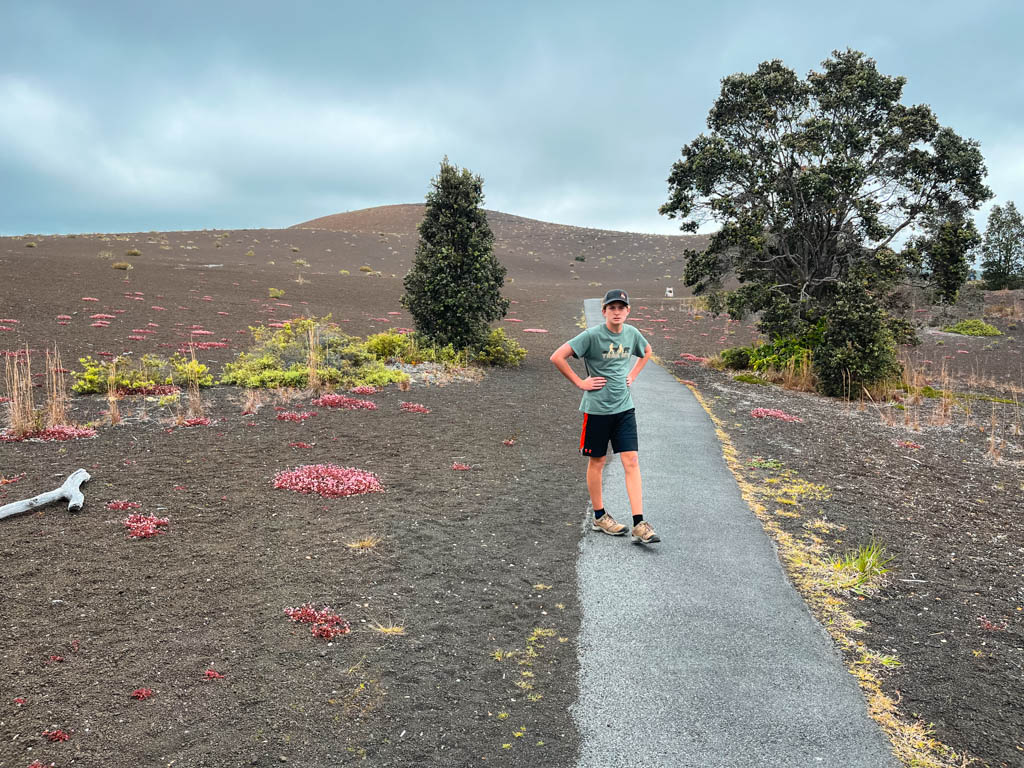
Hike the Kīlauea Iki Trail as a Loop (including a stop at Thurston Lava Tube)
To do this hike, you can park at several locations. We left our car at the visitor center since it was early, but you can also drive to the Kīlauea Iki Trail. This route is slightly different from others you see and includes the Thurston Lava Tube and the Sulpher Banks Trail. The NPS service has a similar hiking route that is helpful to follow. You can hike this loop in either direction – we chose to go counterclockwise.
* If you don’t want to walk down into the crater, you can also skip that part of the hike and simply hike the Sulphur Banks Trail and Crater Rim Trail as an out and back. This avoid almost all the elevation gain.
From the visitor center, hike the Sulphur Banks Trail. We really enjoyed this trail and it is generally short and easy. Make sure to stay on the trail in this area and follow posted signs.
The Sulphur Banks Trail ends at an overlook of the crater. From here follow the Crater Rim Trail along the edge of the Crater. This part of the trail is paved and very easy walking. Most of the trail is right along the crater edge with a small section that goes through some forest.
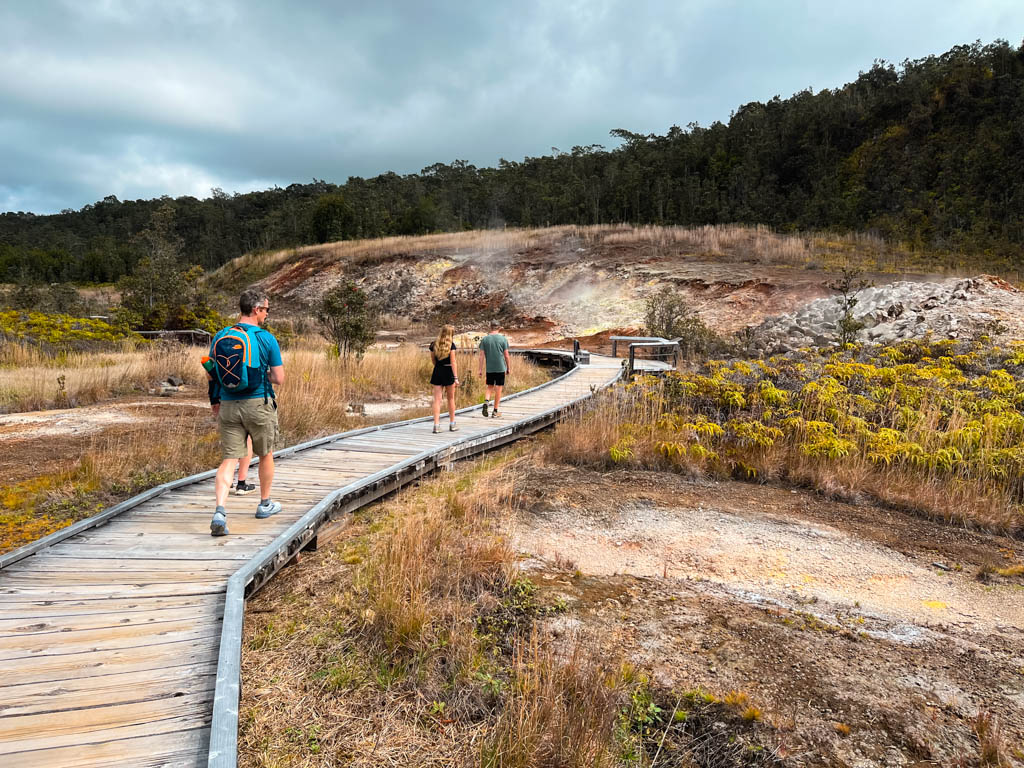
At the viewing area at the end of the Crater Rim Trail, descend into the crater on the Kīlauea Iki Trail. The trail descends some stairs until it reaches the bottom of the crater. This part of the hike is really interesting as you are walking right across a lava bed and there are some vents with steam coming up around you. Follow the stacked rocks to find your way.
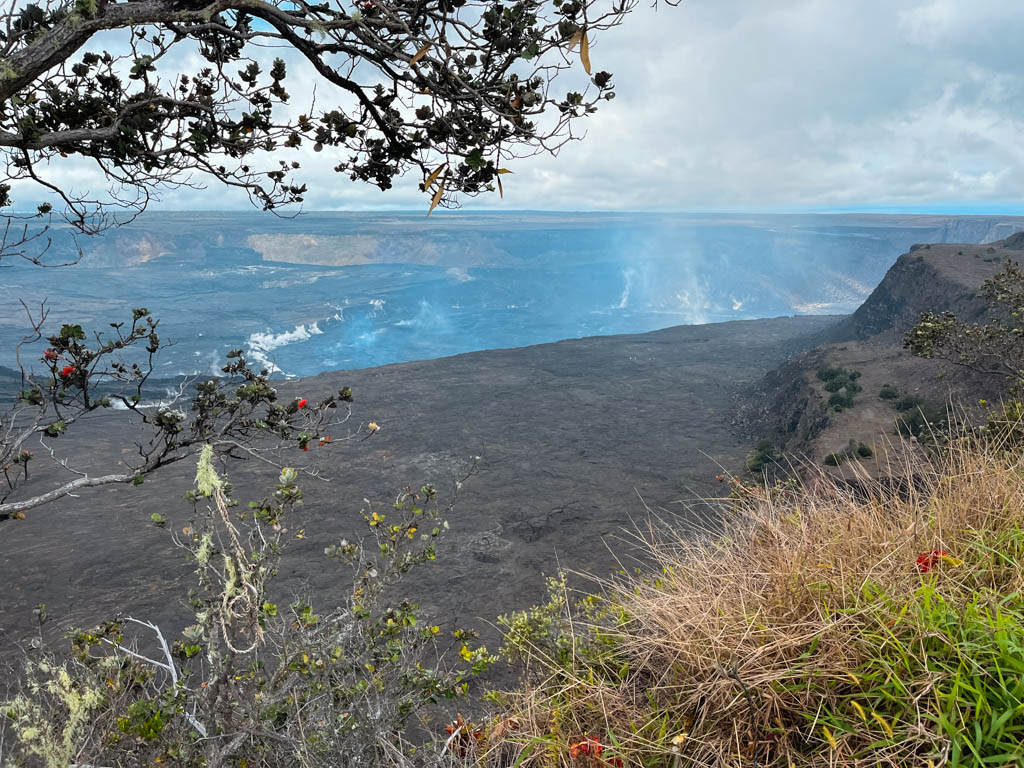
At the far and of the crater ascend up a series of switchbacks that may be muddy if there has been rain. It was dry when we were here so not really an issue. At the crater rim, walk to the Thurston Lava Tube.
The Thurston Lava Tube formed when flowing lava began to cool forming a hard outer shell. When the lava stopped flowing and drained away the tube was left. The Thurston Lava Tube is paved, well lit and easy to explore.
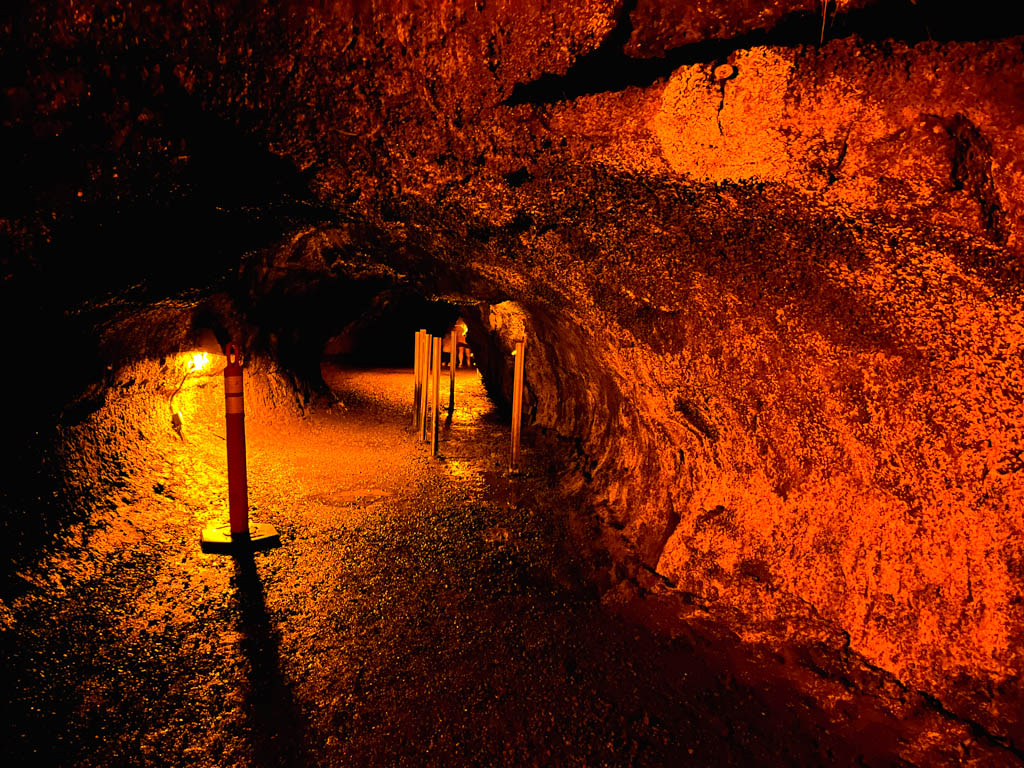
After enjoying the Lava tube, finish your hike by walking the connector trail back to the visitor center.
This entire hike took us about 2.5 hours including some time with a ranger who told us more about the crater. The hike really covers the best and most interesting things to see in this part of the park.
Before heading down to the coast, use the bathroom if needed.
Start the Drive Down Chain of Craters Road and Stop for a Picnic Lunch at the Devastation Trail
Depending on your timing, it is likely close to lunch. Drive the short distance down the Chain of Craters Road and stop for a picnic lunch at the Devastation Trail Parking lot. This gets you away from the bustle of the visitor center. Take the very short walk for just the start of the Devastation Trail. This is a large pile of cinder left behind after an eruption. It’s interesting to see the plant life trying to get a hold in this challenging environment.
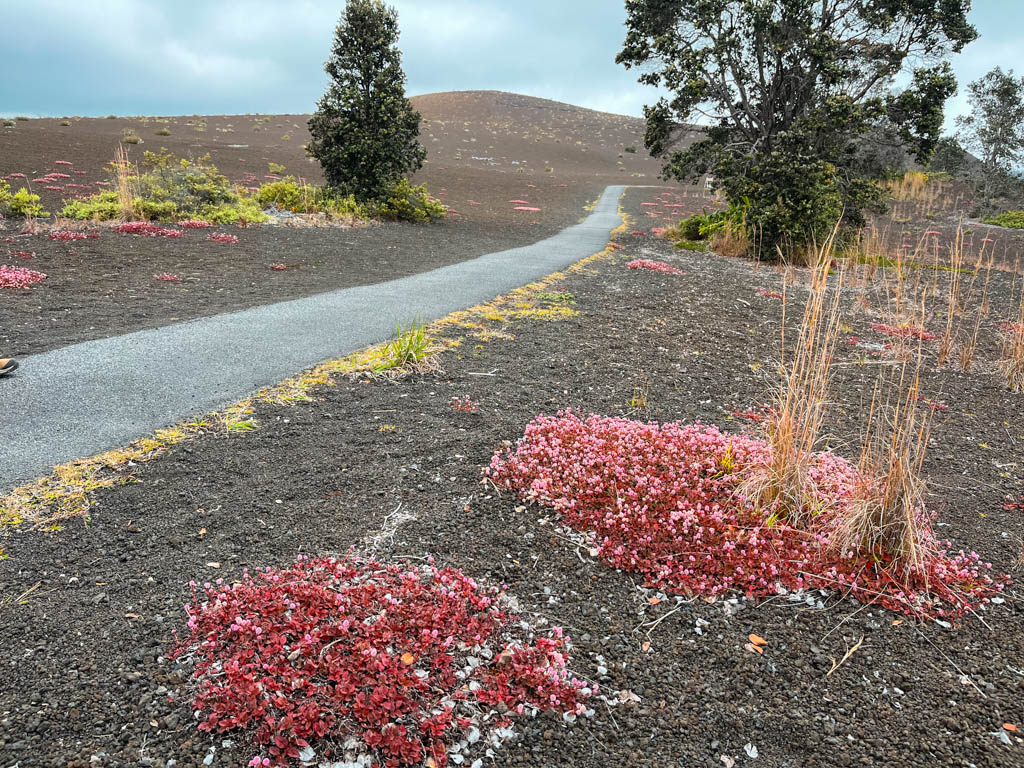
Drive to the Sea Arch
After lunch continue driving down to the coast on Chain of Craters Road. This is a fascinating drive that gives you a fresh perspective of the park. You will drive through lava fields and be able to see the paths of many different eruptions over time. The road is well paved with long switchbacks.
At the base of the hill, the lava field extends in a plain our towards the coast where to plunges into the see. Once you reach the base of the hill continue on to the end of the road. At one point, this road continued along the coast but recent eruptions covered the road. To see the sea arch, park right at the end of the road and walk a very short distance down to the overlook. The sea arch is ok, but it was even more interesting to see where the dramatic lava coastline meets the crashing waves of the Pacific.
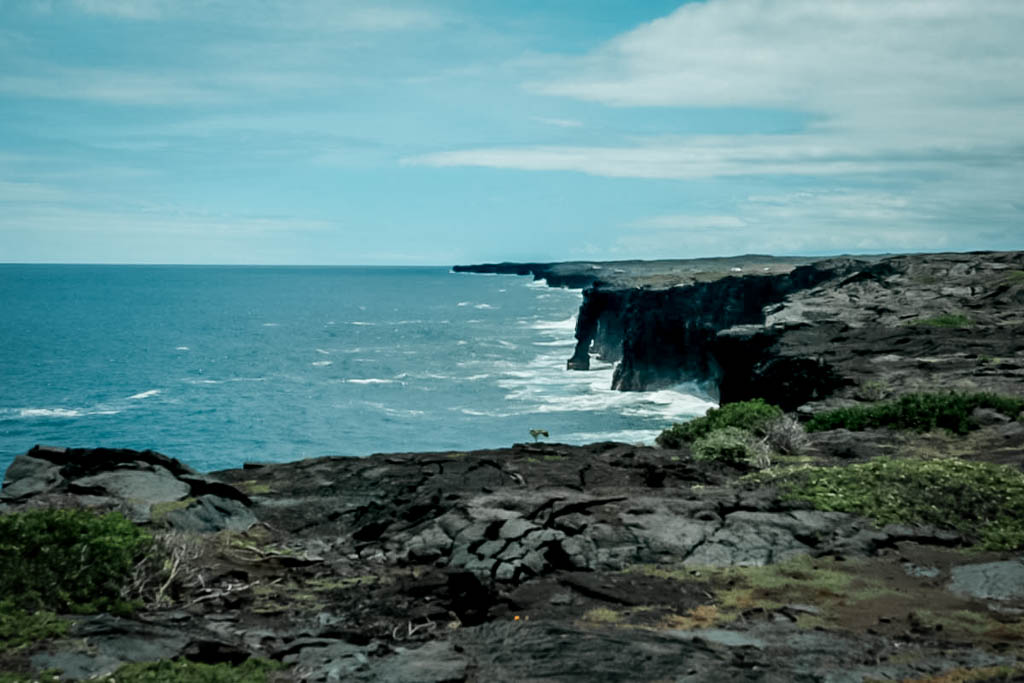
Stop to See the Petroglyphs
Retrace your drive back up Chain of Crater Road. Just before you begin ascending, you will see the pull off for the Pu’u Loa Petrogpyh Trail. This 1.5 mile trail goes through the lava field to a boardwalk area where you can see several well preserved and interesting petroglyphs.

If you are too tired (and hot) to hike out this far, cross the road and walk on the trail here for about 7 minutes to see some petroglyphs. Enjoy the heat before heading back up Chain of Craters Road towards the visitor center. At this point it is likely late afternoon and time to head back to your hotel.
Optional: Visit Mauna Loa
If you go an early start or just want some more time in the park, you can also drive up to Mauna Loa.
This drive is about 17 miles each way and goes along the side of Mauna Loa – The start of this scenic drive is just outside the main entrance of the park. We did not do this drive on our Volcano National Park itinerary because we were tired after a long day in the park and still had a drive back to our hotel.
General Things to Know About Hawaii Volcanoes National Park
Best time to visit the park.
You can visit Hawaii and do this Volcano National Park itinerary at any time through the year. The temperature is very consistent although much cooler at the altitude. If you drive down to the coast on Chain of Craters Rd, the temperature will increase by about 30 degrees. Be prepared for a range of conditions.

Is 1 Day Enough?
In our opinion, one day in Volcano National Park is the perfect amount of time to spend in this park. If you plan to explore every corner of the park, you can easily spend 2 days. It is also possible to see the park in 1/2 day although you will either spend all your time driving or only have time to visit the crater area of the park. Below are some suggestions on how to adjust your itinerary:
Half Day Hawaii Volcano National Park Itinerary
If you only have time for a half day Volcano National Park itinerary, I would do just the first half of the itinerary described below. Basically you will hike the Kīlauea Iki Trail as a Loop. This gives you the highlights in this part of the park. With just a half day you won’t have time to drive down Chain of Craters Road to the coast.
Volcanoes National Park 2 Day Itinerary
If you are planning a 2 day Volcano National Park itinerary, you can easily spread out the activities. For day 1 – I would recommend the Kīlauea Iki Trail as a Loop. In the afternoon drive up to Mauna Loa to explore this less visited part of the park.
On your 2nd day, take your time and drive down Chain of Craters Road to the sea arch on the coast. Stop at the Petroglyphs and then enjoy stopping at some of the less visited craters and hikes along this route. The National Park service has a good overview of the route with some addition suggestions on places to stop.
Entrance Fees and Logistics
In order to enter the park, you will need to pay the park entrance fee of $30 or use an annual park pass. The park is open 24 hours a day 7 days a week with some exceptions on holidays. You can see the most updated schedule on the NPS website .

How to Get to the Park
The park is easy to get to on a well paved road and is under 3 hours from almost anywhere on the island of Hawaii. To get to the park itself, you can take Highway 11 (Hawaii Belt Road) southbound, which leads directly to the park entrance. If you’re arriving in Kona, the drive to the park takes around 2.5 to 3 hours. Take Highway 11 eastbound, passing through beautiful landscapes and scenic views until you reach the park entrance. It’s advisable to rent a car to have flexibility and convenience in exploring the park and its various attractions. Alternatively, guided tours and transportation services are available from nearby towns, providing organized trips to the park if you prefer not to drive yourself.
You can rent a car directly from the airport and search for the best rate on Discover Cars.
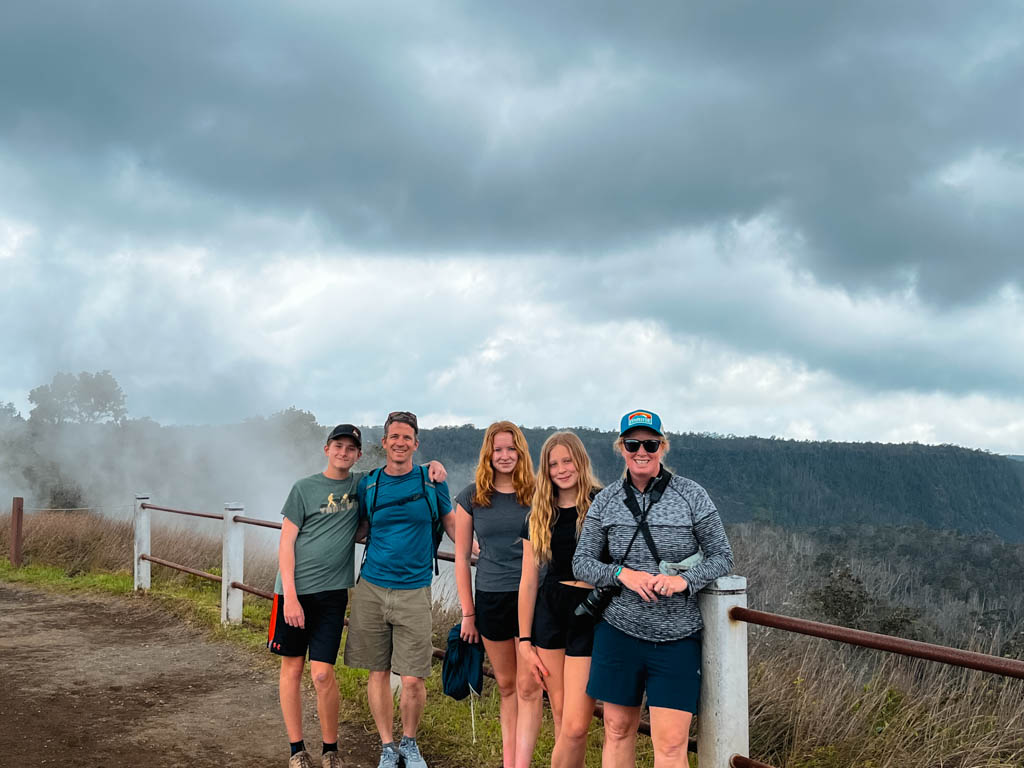
What to Wear and Pack for your Itinerary
It’s important to pack right for your day in the park. In addition to the clothing and supplies below, you should plan to pack a picnic lunch and fully gas up your car. Once you get in the park, there are no places to stop to eat or get gas. Below is a general packing list for the park and if you are planning to do some of the hikes in the region, make sure you pack the top essential hiking items.
In general we recommend hiking in short or lightweight pants and a t-shirt with layers to add on top if needed.
In general for a day in Volcanoes National Park that includes sightseeing, drives and hiking, we recommend:
- Hiking boots/shoes
- 2 full water bottles
- Warm Top Layer
- Plenty of Snacks and a picnic Lunch
- Camera/phone
- Map (grab one in the visitor center)
- Hat, sunglasses, and sunscreen
Common Questions about a Volcano National Park Itinerary
Can I see flowing lava in the park? The availability of flowing lava varies and is dependent on volcanic activity at the time of your visit.
Are pets allowed in Hawaii Volcanoes National Park?
Pets are generally not allowed on trails or in most areas of the park. However, they are permitted in designated areas such as campgrounds and parking lots, as long as they are kept on a leash.
Can I camp in Hawaii Volcanoes National Park?
Yes, camping is allowed in designated campgrounds within the park. Namakanipaio Campground is the only established campground within the park boundaries, offering tent and cabin camping options. Permits and reservations may be required, so it’s advisable to plan ahead and check the park’s official website for details.
More Information About Hawaii and Other National Parks
If you have more time on the big island, one of the top activities is to hike and explore Mahaiula and Makalawena Beach
Maui: Check out our 5 day itinerary to Maui. Make sure to visit Haleakala National Park and explore the northeast part of the island.
Looking more more information on US National Parks, see how we plan a National Parks Trip and find all our guides to the parks we’ve visited.
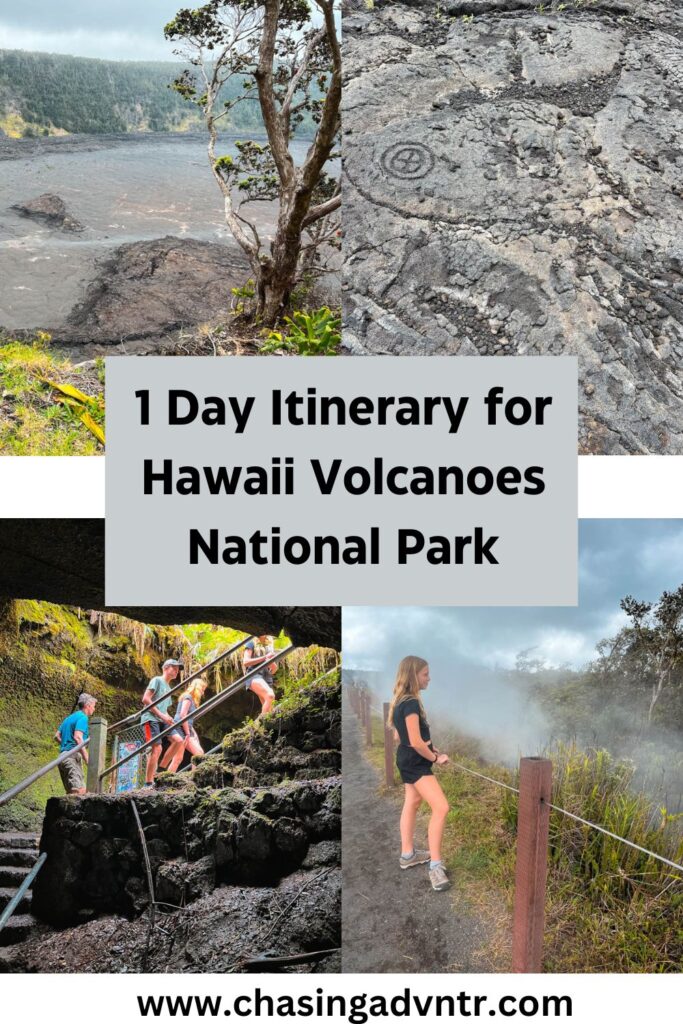
About the Author: Gretchen Stuppy Carlson
A passionate adventurer and travel agent dedicated to getting families outside and exploring. Gretchen is an expert in adventure travel with 15+ years of experience working in outdoor education and travelling with her own family.
View all posts by Gretchen Stuppy Carlson | Website
What's Your Next Adventure?
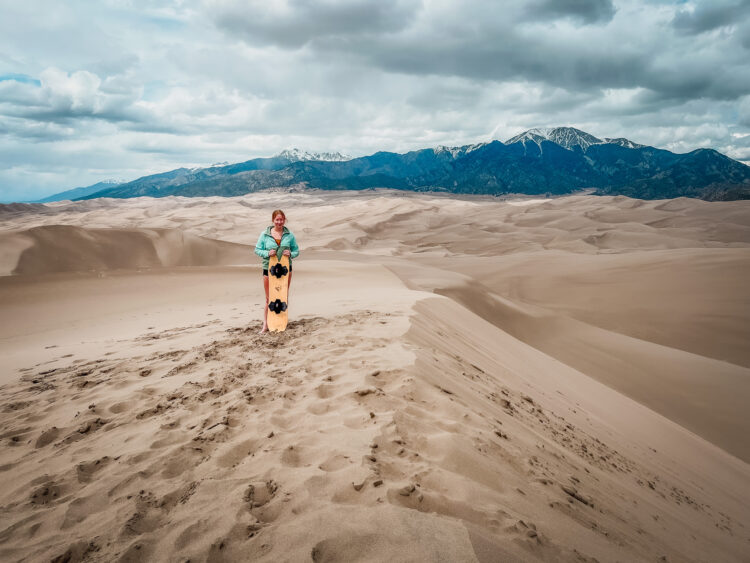
How to Sand Board Great Sand Dunes

Guide to Hiking Great Sand Dunes
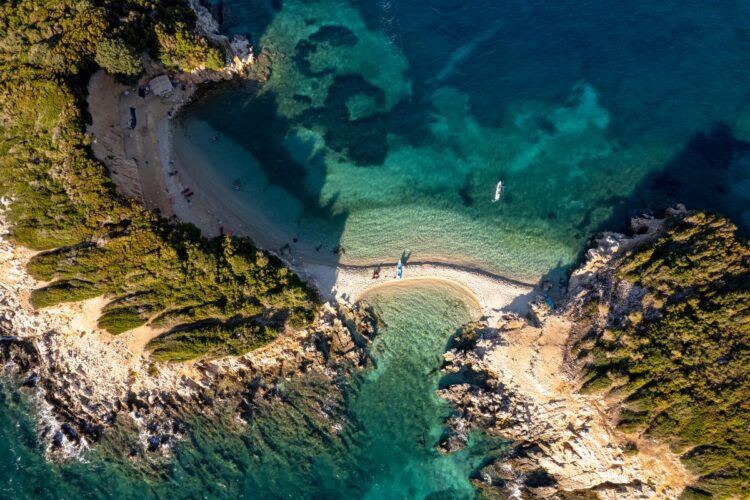
5 Destinations to Visit Next Summer
General newsletter popup.
Demo Description
Get Inspired for your Next Adventure
Our weekly newsletter is full of hidden gems, destination ideas, first hand experience and travel deals.
For a limited time, get your FREE ebook: 100 Adventures of a Lifetime when you join our newsletter

This will close in 0 seconds
First-timer’s guide to Hawaiʻi Volcanoes National Park

Apr 18, 2024 • 10 min read

The scale and ferocity of Hawaiʻi Volcanoes National Park is a wonder to experience © Yiming Chen / Getty Images
Unsurprisingly, Hawaiʻi Volcanoes National Park on Hawaiʻi Island is one of the state’s most popular attractions.
This incredible landscape is home to two massive volcanoes – Kīlauea being one of the world’s most active – and stretches from sea level to the summit of Mauna Loa, one of the world’s largest. Sprawling across 333,259 acres on the island's southeastern side, the park is one of the most dynamic and diverse in the US.
Its ever-changing landscape boasts an assortment of terrain, from lush rainforests and barren lava fields to a volcano often dusted with snow every winter. Yes, even in Hawaiʻi!
So grab those hiking boots and binoculars and use our insider guide to get the most out of your first trip to this unique national park.

When is the best time to visit Hawai‘i Volcanoes National Park?
There isn’t an especially bad time to visit the park, which sees nearly two million visitors annually. The weather on the Islands doesn’t vary much, with temperatures fluctuating between 66-85°F throughout the year. Winter and early spring, though, tend to be rainier and cooler than other times of the year and hurricane season runs from June to November, which can mean tropical storms, whipping winds and torrential rain.
The busiest travel seasons in Hawaiʻi are summer and winter – summer is peak vacation time for families and winter lures travelers eager to escape colder climes. Expect more people on trails and longer waits for parking during these periods.
Spring and fall are slower travel months and ideal times to visit the park. Trekking conditions are much more comfortable without the intense summer heat and you’ll likely find better airfare prices and hotel rates at nearby hotels. The park does get a surge of visitors during spring break and around the weekend of the annual Merrie Monarch Festival , a week-long hula competition based in Hilo around late March or early April.
Tuesday is the busiest day at the park – pick another day if at all possible. This is when the Pride of America , a cruise ship that sails around the Islands, docks in Hilo. Many of its 2000 passengers head to the national park, hitting popular stops like the Kīlauea Visitor Center , the Kīlauea Iki Trail , and Nāhuku (otherwise known as Thurston Lava Tube ). Winter brings yet more cruise ships to Hawaiʻi Island as thousands of North Pacific humpback whales migrate annually from Alaska to the warmer waters surrounding the Islands.
Though Kīlauea stopped erupting on Sept 16, 2023, the volcano still attracts visitors despite no visible lava fountains or flows. And it’s likely it will erupt again – the Puʻuʻōʻō eruption, which began in 1983 and lasted 35 years, ranks as the longest and most voluminous known outpouring of lava from Kīlauea’s east rift zone in more than 500 years. “If there is an eruption,” says Jessica Ferracane, the park’s spokesperson, “it is busy all day, every day, especially if it’s at the summit of Kīlauea.”
Planning tip: The park is currently undergoing a big disaster recovery project following the 2018 Kīlauea eruption and summit collapse. There could be temporary area closures, lane closures, reduced parking and other limited services for the next two years. Check the park website to check for construction closures and delays .
Find out everything you need to know about what's happening in Hawaii throughout the year in our guide to the best time to visit the Aloha State
How much time should I plan to spend at the park?
Hawaiʻi Volcanoes National Park may not be as huge as Alaska’s 13.2-million-acre Wrangell-St. Elias National Park & Preserve – larger than Yellowstone National Park, Yosemite National Park and Switzerland combined – but it does stretch from sea level to the summit of 13,681-ft Mauna Loa and across seven different ecological zones. You’ll need at least a full day to explore all the best parts of the park but two days are even better.
Park staff recommend that visitors arrive by sunrise to hit the park’s most popular trails first – it's open 24 hours to allow everyone to maximize their time. Dusk is also a wonderful time to go exploring – the lack of light pollution provides dark skies that are perfect for stargazing.
There are a variety of hikes within the national park, from the easy 1.2-mile Kīpukapuaulu Trail to the challenging backcountry treks up Mauna Loa that can take two days. And having an extra day means you can visit the park’s quieter and less crowded Kahuku Unit on the southerly slopes of Mauna Loa. This 116,000-acre former ranchland is about an hour's drive from the Kīlauea Visitor Center and is open to the public five days a week. You can hike to the top of an old cinder cone, trek through a pristine Hawaiian rainforest or bike through scenic pastures with panoramic views of the ranchlands.
The tiny town of Volcano Village just outside the park is also well worth a visit, with its laid-back eateries and food trucks, art galleries, and a vineyard and winery .
Is it easy to get in and around the park?
The nearest airport is Hilo International, about 30 miles northeast of the park (you can fly into the Ellison Onizuka Kona International Airport at Keāhole, but the drive from Kailua-Kona will take about two hours). Getting to the park from Hilo is easy – take Route 11 (Hawaiʻi Belt Road) west until you reach the main entrance. The drive takes about 45 minutes.
Hele-On Bus is the island’s only public bus service, operated by Hawaiʻi County. The No. 11 Red Line runs between Hilo and Hawaiʻi Volcanoes National Park, stopping daily at the Kīlauea Visitor Center. The bus schedule is subject to change, so check ahead. There is no public transportation or shuttle service within the park, so you’ll need a car to get around.

Top things to do at Hawaiʻi Volcanoes National Park
Kīlauea iki trail.
One of the most popular hikes in Hawaiʻi Volcanoes National Park is the 4-mile roundtrip Kīlauea Iki Trail. The terrain is varied – it starts in a forest of native ʻōhiʻa trees and hapuʻu (Hawaiian tree fern) and ends with a walk across an otherworldly crater floor – and it’s short enough to complete in a few hours, giving you plenty of time to visit other parts of the park.
The trailhead is at an overlook of the crater formed from an eruption in 1959 that was marked by fountaining lava over a half-mile long and a plume reaching a world-record 1900ft high. The first part of the trail is a descent through a lush rainforest lined with native ʻōhiʻa and koa trees. Look for the white-rumped ʻapapanae , a nectarivorous Hawaiian honeycreeper, often found flitting from tree to tree. The switchbacks end at the crater floor, a vast moonscape that sharply contrasts with the surrounding native forests.
This lava tube – also known as Thurston Lava Tube – was created by a river of 2000°F (1093°C) molten lava about 500 years ago. Discovered in 1913, this massive lava cave is very accessible, with a flat rock floor and ceiling height of more than 20ft in places. Electric lights illuminate most of the path, though you may want to bring a flashlight – it takes about 20 minutes to stroll through the tube. The rainforest that surrounds Nāhuku is brimming with native birds, including the scarlet ʻiʻiwi , a Hawaiian honeycreeper listed as threatened under the Endangered Species Act.
Hōlei Sea Arch
At the end of the Chain of Craters Road – about 18 miles from the Kīlauea Visitor Center – is the Hōlei Sea Arch , a 90-ft-tall rock formation cut into the cliff of an ancient lava flow about 550 years ago. In 2020, the park opened a new viewing area about 1000ft past the gate at the end of the road and set back away from the cliff edge.
Puʻuloa Petroglyphs
There’s an area of Pānau Nui on the southern flank of Kīlauea with numerous pecked images, or petroglyphs, in the hardened lava. Puʻuloa, which translates to “long hill” in ʻōlelo Hawaiʻi (the Hawaiian language), is a sacred place to Native Hawaiians. The archaeological site here boasts more than 23,000 petroglyphs – the largest collection in Hawaiʻi – with motifs of circles, canoe sails, human forms, feathered capes and other geometric shapes.
Devastation Trail
This half-mile hike is suitable for everyone as it's wheelchair and stroller accessible. The paved path meanders through a stark yet beautiful landscape buried by falling cinder from lava fountains of the 1959 Kīlauea Iki eruption. You might find volcanic debris in the form of glass-like droplets and strands called Pele’s Tears and Pele’s Hair, respectively, named after the revered Hawaiian goddess of fire and volcanoes. Nēnē (Hawaiian geese) frequent this area; refrain from feeding or interacting with this threatened species.

My favorite thing to do at Hawaiʻi Volcanoes National Park
Unfortunately, there aren’t many places in Hawaiʻi where you find native forest birds anymore. Their populations have plummeted due to habitat destruction, predators like feral cats, mongoose and non-native mosquitoes that spread avian pox and avian malaria.
But at Hawaiʻi Volcanoes National Park, where native habitats are protected and able to thrive, you can see – and hear – a variety of these special birds, from the friendly ʻelepaio (Hawaiian flycatcher) to the elusive ʻōmaʻo (Hawaiian thrush), which can only be found in the montane rainforests on Hawaiʻi Island. The bright orange ʻākepa , an endangered Hawaiian honeycreeper with an odd-shaped beak, can be spotted in the high-elevation forests of the park’s Kahuku Unit. And if you’re lucky, you might catch a glimpse of the endemic ʻio , the only hawk species native to Hawaiʻi.
I love wandering along the 1.2-mile Kīpukapuaulu Trail, an easy loop through pristine native forestland in an area known as a “bird park.” A kīpuka is an area of land that’s surrounded by younger lava flows, like an “island” within a sea of lava. There are more native tree species per acre here than any other forest in the national park, which means you’ll find native forest birds that rely on the native trees that grow here.
How much money do I need?
Park entry costs $30 for a private car, $25 for a motorcycle, and $15 for pedestrians and cyclists. The park has gone cashless, so payment has to be made with debit or credit cards in person or online .
If you're also planning to visit Puʻuhonua o Hōnaunau National Historical Park near Kailua-Kona or Haleakalā National Park on Maui, consider buying the Hawaiʻi Tri-Park Annual Pass for $55. This allows you to enter all three of these parks in a single, private vehicle.
The National Park Service offers free admission to everyone on the following days: Martin Luther King Jr. Day, the first day of National Park Week in April, Juneteenth, the Great American Outdoors Act, National Public Lands Day and Veterans Day.
Average costs at Hawaiʻi Volcanoes National Park
- Basic room for two at Volcano House: $80 to $385 per night
- Airbnb in Volcano: $150 average per night
- Cup of coffee: $3.50
- Midrange meal: $15-$20 per person
- Local beer: $10
- Gas (regular) in Hilo: $4.81 per gallon

How to travel in the park consciously
With two active volcanoes and ongoing construction to repair damage caused by the 2018 Kīlauea eruption, it’s important to stay on marked trails and overlooks and keep out of closed areas. And no matter what you may have seen on social media, please leave the rocks alone and unstacked. Park staff often use ahu (stacked rocks) to mark trails; it’s not an invitation to do the same. Not only is it culturally insensitive but it can be disorienting to hikers who rely on the ahu to guide them along trails. It’s also long believed that taking lava rocks brings bad luck. Hundreds of people return rocks they’ve taken from the park every year.
There are many culturally significant sites within the park, itself a Unesco World Heritage Site. These include petroglyphs, historic trails, fossilized footprints, shelter caves, heiau (Hawaiian temples) and stone walls of canoe sheds and corrals. Many of these sites are listed in the National Register of Historic Places – please be respectful when you get the chance to see them close up.
The land within the park is sacred to Native Hawaiians, with moʻolelo (stories) and mele (songs) tied to this area. They believe Pele, the Hawaiian goddess of fire and volcanoes, lives in Halemaʻumaʻu Crater at the summit of Kīlauea. If you come across Native Hawaiians performing cultural rituals in the park, keep a respectful distance. Let them – and others – connect undisturbed with nature.
This article was first published Sep 14, 2021 and updated Apr 18, 2024.
Explore related stories

Destination Practicalities
Jul 19, 2024 • 8 min read
Hawai'i is the largest island in the state of Hawaii, also known as the Big Island. Plan your visit with our first-time guide.

Jun 4, 2024 • 13 min read

May 27, 2024 • 7 min read
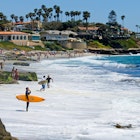
May 3, 2024 • 12 min read

Mar 29, 2024 • 5 min read

Mar 25, 2024 • 8 min read

Mar 24, 2024 • 7 min read

Mar 19, 2024 • 5 min read

Mar 5, 2024 • 12 min read

Feb 2, 2024 • 5 min read

The Ultimate Guide to Hawaii Volcanoes National Park on the Big Island
Heading to the big island and hope to see real lava on your hawaiian vacation scroll to find out everything you you need to know in this guide to hawaii volcanoes national park, the only unesco world heritage site in hawaii., this guide to hawaii volcanoes national park was written by hawaii travel expert marcie cheung and contains affiliate links which means if you purchase something from one of my affiliate links, i may earn a small commission that goes back into maintaining this blog..
Believe it or not, the island of Hawaii, also known as the Big Island is a new island and is constantly growing. The growth is all due to the hot spot that has continuously spewed lava into the ocean.
It’s also one of the few places in the world where regular people can hike to the active lava spots and get amazing photographs of the lava flowing into the ocean.
But the lava isn’t the only thing you can do here at Big Island Volcano Park. There are tons of things to do in Volcanoes National Park if you have the time.
So How much time do you need at Volcano National Park? There is no easy answer to this question. It all depends on how much time you have.
There are several activities you can do that allow you to get a brief glimpse of what the park has. Or, you can spend days exploring every inch of the Hawaii National Volcano Park.
So, whether you are doing a day trip to Hawaii Volcanoes National Park or are planning on spending several days there, this Volcanoes National Park guide has you covered!
First trip to the Big Island ? Read THIS first!
Don’t have time to read many Hawaii blog posts and reviews? Here are some of our top picks for visiting the Big Island.
Popular Big Island Tours/Activities
- Manta Ray Snorkeling Tour (you can ONLY do this on the Big Island)
- Hawaii Volcanoes National Park Tour (this is the BEST way to see lava if you aren’t renting a car)
- Mauna Kea Stargazing Tour (this is a cool adventure for teens and adults)
- Swim with Dolphins (this is a unique experience for kids of all ages and adults)
- Kona ATV Tour (we love this one because they also do cultural activities)
- Book a Photo Shoot (this is a Hawaii souvenir you’ll treasure forever)
Favorite Big Island Resorts/Hotels
- Hilton Waikoloa Village (this is a mega resort where you can swim with dolphins or just enjoy their massive pool area)
- Courtyard by Marriott’s King Kamehameha Beach Hotel (this is a moderately-priced Kona hotel right on a little lagoon)
- Fairmont Orchid (this is a swanky resort with an awesome pool area and beach)
Want to Rent a Car in Hawaii? One of the best places to rent a car in Hawaii is Discount Hawaii Car Rental because they get the best rates from top national companies like Alamo, Dollar, Thrifty, Avis, Enterprise, Budget, and Payless.
Want to skip all the planning and just access my detailed Big Island Itinerary, complete with daily schedules, kid-friendly activities, and travel hacks? Click the button below.
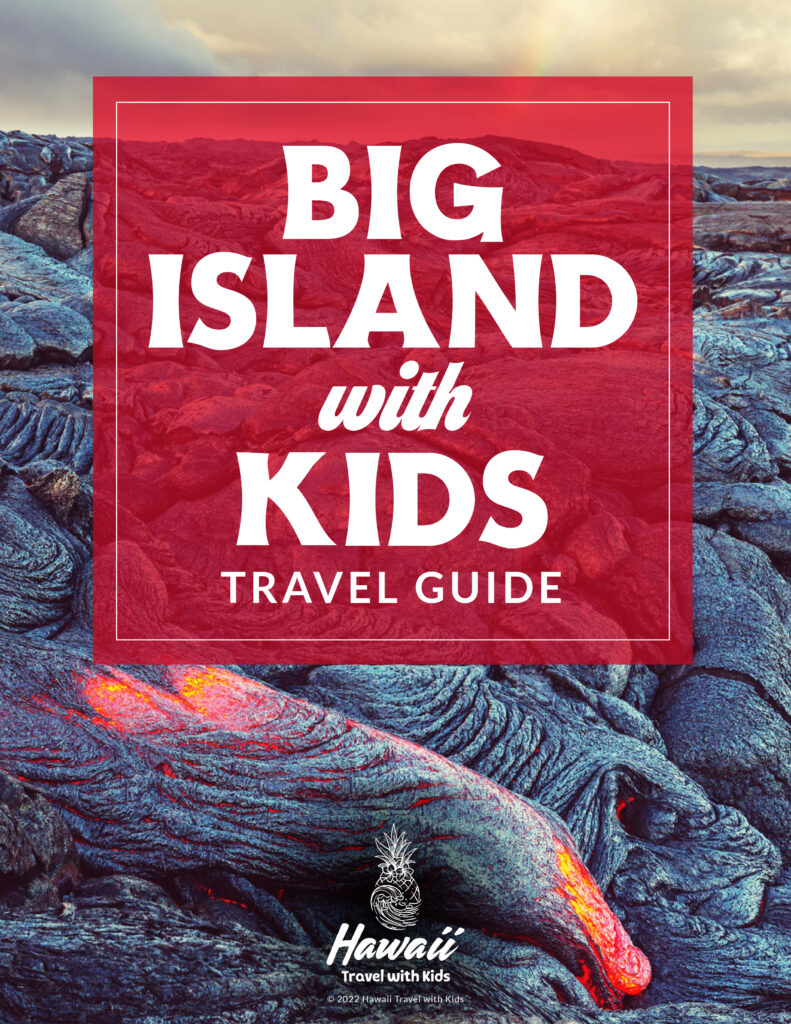
The Ultimate Guide to Hawaii Volcanoes National Park
Here is your Volcano National Park guide to learn all there is to see and do here along with how to get to Volcano National Park.
Where is Volcano National Park located?
Before you can start planning on what to see and do at the park, you need to know where to go. The Hawaii Volcanoes National Park is located on the south side of the Big Island between Hilo and Kona .
Starting in Kona — Fastest Way
If you are starting out on the Kona side of the island, or the “dry” side, you will have to take Highway 11. Start by going southeast, you’ll cut through Kealakekua, Captain Cook, South Point, Na’alehu, and Pahala.
Don’t just drive through these areas, there are tons of things to see. You can stop and enjoy the black sand beach that is located on the Ka’u Coast. Look for signs for Punalu’u.
Have a picnic and enjoy the basking turtles for a bit before heading back on the road.
Then you can simply continue driving around Highway 11 until you reach the Hawaii Volcanoes National Park.
In total, the drive from Kona to Volcano National Park is about 2 and a half hours and is 96 miles if you are going to the park from the Kona side of the island. This is of course taking the shortest route.
Starting in Kona — Alternative Route
Another option is to start from Kona and go through to Waikoloa. From Waikoloa, you’ll head up to Waimea. You can take the ‘shortcut’ through the dormant volcanoes of Mauna Loa and Mauna Kea on “Saddle Road.”
Saddle Road isn’t as bad as it once was. It used to have blind turns and very windy roads with limited visibility.
But over the years, the state has made improvements to the road, and it’s an easy smooth drive to get to the Hilo side of the island.
If you take this route, you’ll be amazed by old Lehua forests and see just how massive Mauna Loa and Mauna Kea are.
This route will take about 2 and a half hours to get to the Hawaii Volcanoes National Park. It doesn’t have a view of the coast, but the view is still pretty awesome cutting through the sleeping volcanoes.
Starting in Kona — Alternative Route 2
Or, you can go from Waikoloa to Waimea and continue around through Laupāhoehoe, and see the stunning coastline with this route.
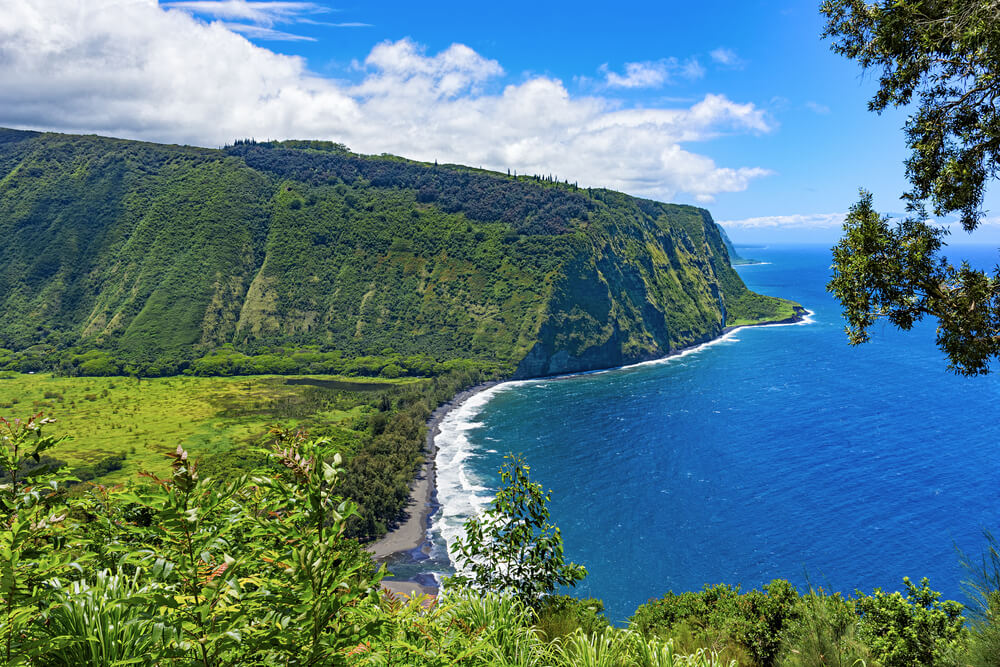
If you take this route, don’t forget to take a detour to Waipio Valley lookout in Honoka’a. There you will see an amazing view of a black sand beach and glorious valleys.
It was here that Water World was filmed for the land scenes.
Word of caution though, don’t try to go down to the beach. Just enjoy the lookout.
The hike down is easy and you may think you have the time to go down and back up. But the climb back up is what will take the most time.
The road is super steep and it switches back again and again. It takes ten minutes to climb down, but at least 35 to get back up. It is not an easy climb to the top. However, you can do the Waipio Valley Shuttle tour , which is awesome!
But, if you want to hike, then jump back in your car and cruise to Laupāhoehoe where you’ll find the Akaka Falls .
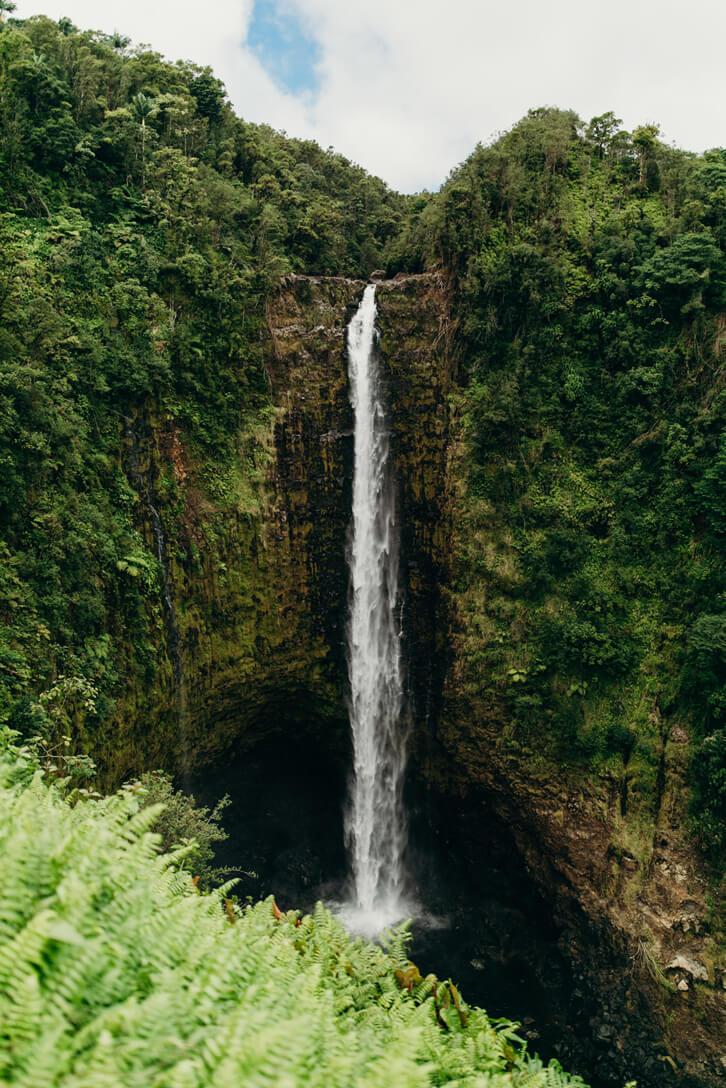
Here you’ll hike through the rainforest and find a spectacular waterfall. The path to the waterfall is easy and maintained. It takes about 20 minutes for a round-trip hike to see the falls.
Cutting through Hilo or Starting in Hilo
Once your legs are stretched, continue on Highway 19 and connect with Highway 11. You’ll be cutting through Hilo on this route and get to see the Banyan trees on the main strip, and also Hilo bay.
This route will take you around 2.5 to 4 hours depending on if you stop to hike, or if you stop at each point before getting to the Volcano National Park.
However, if you are staying in Hilo , you’ll find the park is a mere 30 miles southwest. Simply drive for 45 minutes through Hilo and you’ll come across the park.
Cost of Admission to the Hawaii Volcanoes National Park
Unfortunately, there is a cost to get into the park, but at least it isn’t too bad. Since 1987, the park has charged per vehicle. For cars, there is a $30 entrance fee. For motorcycles, it is $25.
But, there are so many things to see and do here with the Hawaiian volcanoes, that the price is well worth it.
Best Things to Do at Big Island Volcano National Park
When you first drive through the entrance of the Hawaii Volcano National Park, you may find yourself on a foreign planet. At least, that will be what it seems like.
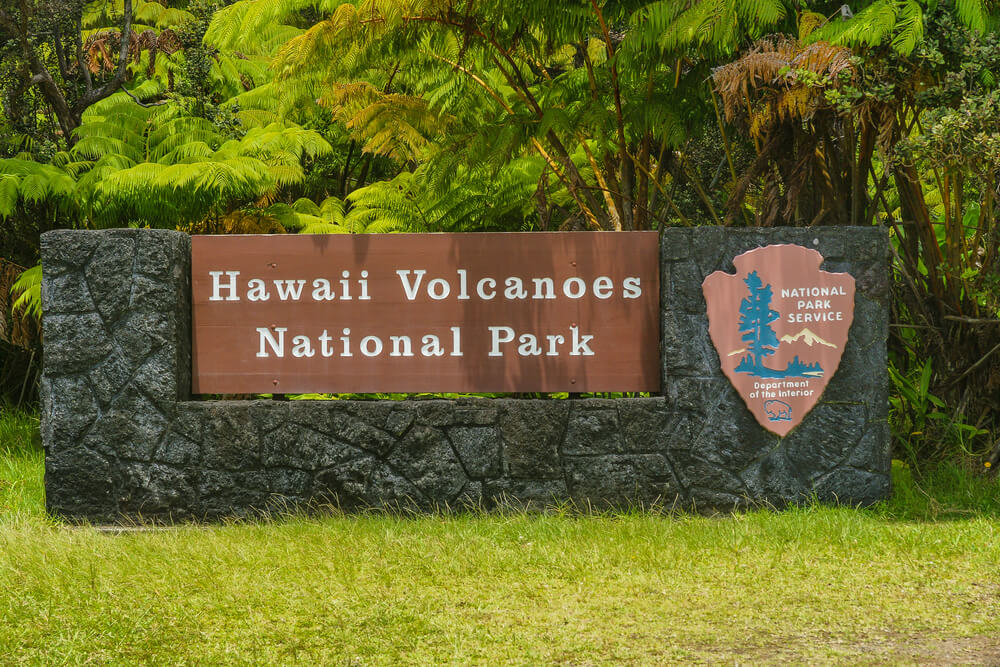
The vast dark ragged and rugged landscape makes it look like you are someplace other than Earth. And you may wonder what all you can do here at the park.
Well, there are tons of things for you to see and do at this UNESCO World Heritage Site.
You’ll first want to get an idea of what is around you. Stopping at the Kīlauea visitor center should be your first priority.
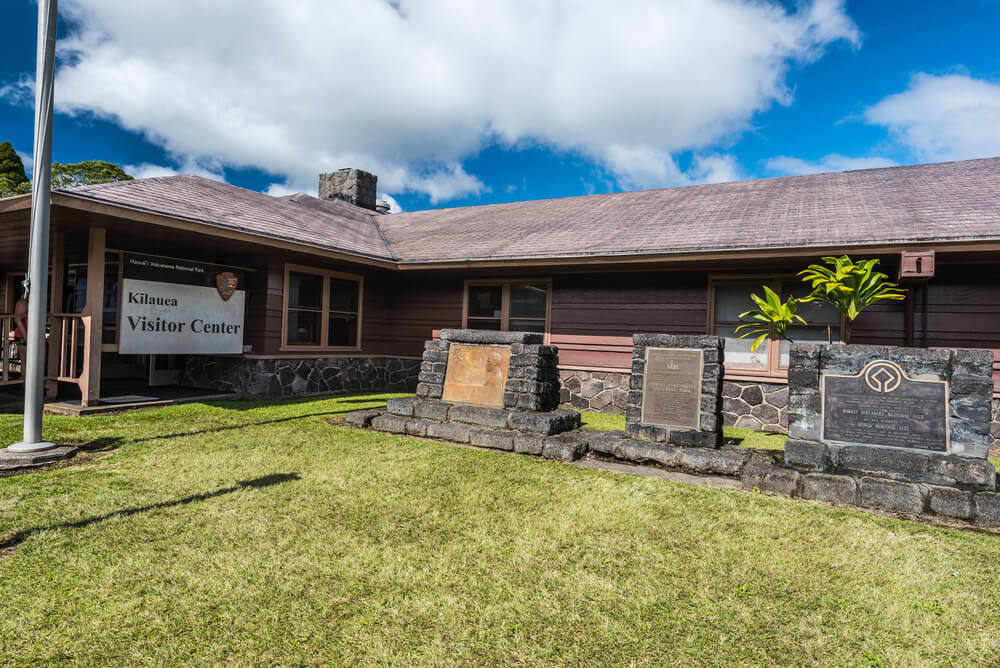
It is here that you’ll learn about the different types of lava flows. You will also get to see the different advancements scientists are making to explore and better understand lava and the earth’s core. They have all the Hawaii Volcano National Park facts.
Once you roam around the museum and snag a map of the park, you might want to jump right into actually seeing lava flow out into the ocean. The thing is though you are still a ways away from the shore.
In fact, it will take about 45 minutes to travel down the road to get to the place where you can park and then another 30-minute hike to the coastline over frozen lava fields.
So, you might want to wait and do this last for 2 reasons.
First, there is a lot to see and do between the visitor center and the shoreline. Just making a beeline to the flowing lava will have you missing out on some amazing sites.
Second, viewing the lava lake at dusk is far more stunning than watching it during daylight hours. Normally the glowing light is visible during the day. To get that remarkable and unforgettable view, wait till dusk.

Thurston Lava Tube
The Thurston Lava Tube is one of the more popular sights to see at Hawaii Volcanoes National Park.
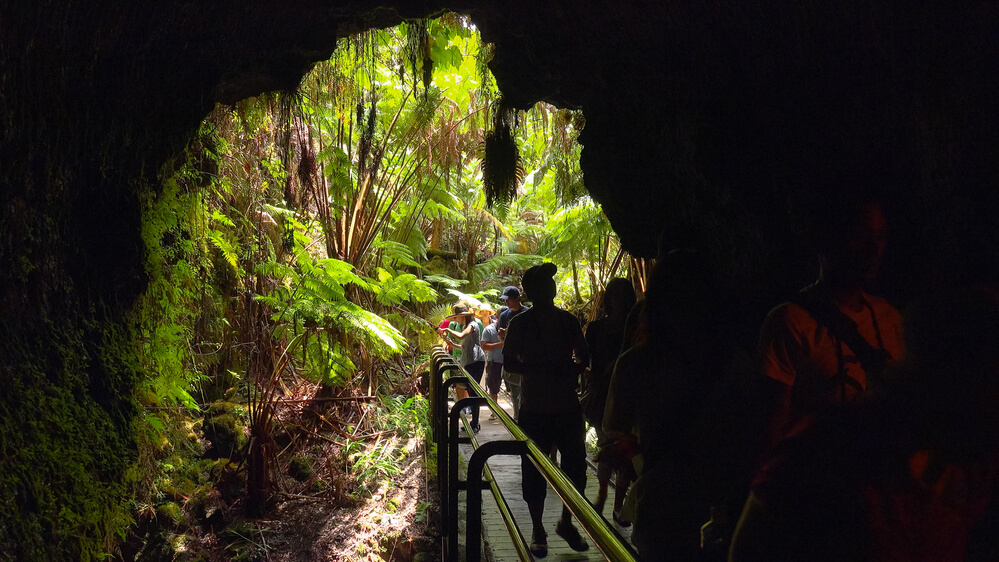
It is a spot where lava passed through clean leaving an open area for you to walk through. It’s basically a cave that anyone can walk through. The ground is flat, and it goes on a short distance and is a must-see.
Crater Rim Road
The Crater Rim is the fastest and easiest way to see a lot in a short amount of time. Of course, short is relative seeing as there are so many spots to stop and take in the view, have a picnic, or just relax and enjoy nature.
But if you are on a time limit, then doing the Crater Rim Drive or the Crater Rim Trail will give you the most photo opportunities for your time.
First, you’ll start out at the visitor’s center and drive around to the Steam vents. There you will also be able to take in the Steaming Bluff and Ha’akulamanu.
Just be wary of the stench around the Ha’akulamanu sulphur banks trail.
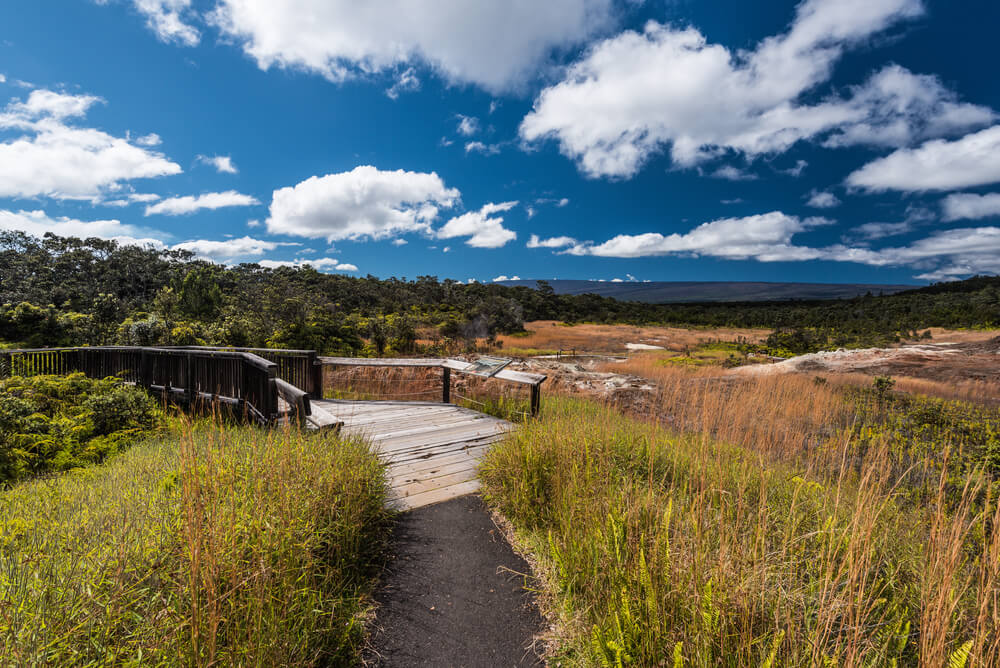
The steam vents and bluff are around the Sulphur Banks area which means that the air quality will be poor and will stink of rotten eggs because that is what sulfur smells like.
Once you get your pictures, continue on the drive and stop off at the Kilauea Iki Overlook. The view here is fantastic and wonderful. There are plenty of places on the side of the road to stop for a picnic or enjoy the scenery.
Then it’s off to the Pu’u Pua’i Overlook where you can see even more awesomeness of how lava can transform and create new land.
Once you have seen the valley area, you can head towards the “Devastation Trail” and stretch your legs on a small hike.
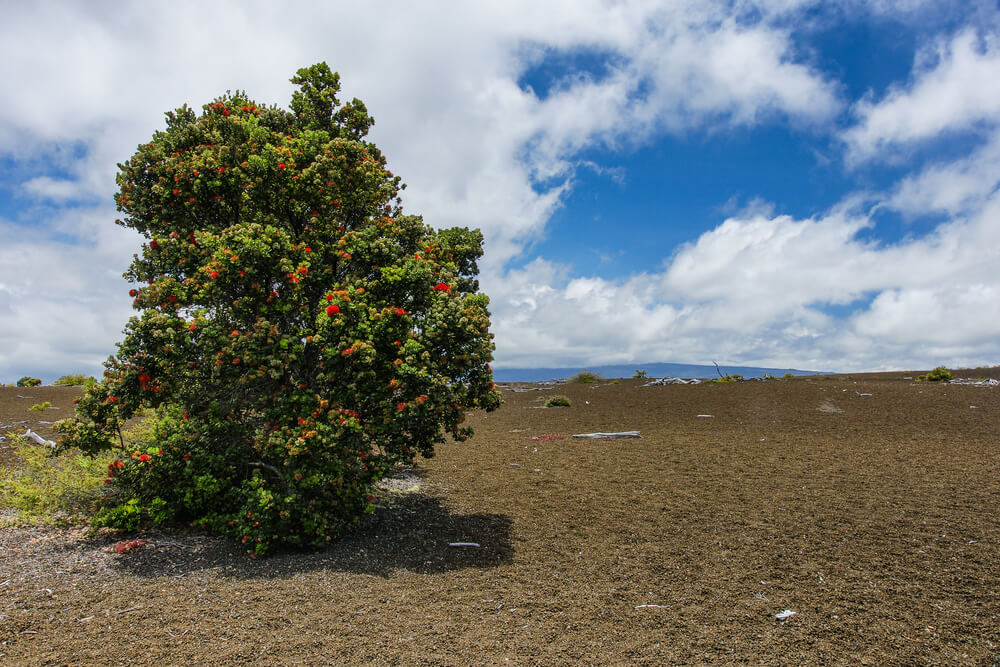
The Devastation Trail makes it seem like you are on the moon or even Mars. There are no trees or anything around and looks just as it sounds. Barren and devoid of life.
Finally, the Crater Rim Drive will take you to Keanakako’i Crater. Once you have got your fill of the Crater Rim, you can start the long drive down the Chain of Craters Road.
Here you will find lots to see, from old lava rivers that are dated along the road to views of the Pacific Ocean.

The Chain of Craters Road will bring you down the slopes of Kilauea towards the ocean. Here you can check out the Holei Sea Arch at the end of the road. It is here that you really understand and see that the Big Island is a new island and growing.
Hiking Trails in National Volcano Park
There are tons of hikes to enjoy while visiting Kilauea volcano. Some are short and others take longer.
The Kilauea Iki Crater hike is about 2 to 3 hours and is quite popular. The Kilauea Iki Crater trail can be challenging, so it’s probably not the one you want to do with kids.
The Crater Rim Trail, sulphur banks, the Kilauea Caldera hike, and Kīpukapuaulu are other fun hikes to see more parts of this large park.
Volcano Art Center Gallery
If you want to explore some of the most gorgeous art of the hot lava and volcanoes, check out the Volcano Art Center gallery while you are at the park.
You can also explore more at Volcano Village as well.
Special Ranger Programs at Hawaii Volcanoes National Park
There are some really cool programs at this Hawaii National Park that are offered throughout the year.
On select Tuesdays, head to the Kilauea Visitor Center for After Dark In The Park for special presentations by leading scientists, artists, and cultural experts on park-related topics.
Join Hawaiian practitioners as they share the arts and culture of Hawaiʻi with demonstrations and hands-on activities during ʻIke Hana Noʻeau (which translates to “Experience the skillful work”.)
Grab tickets for a small, underground laboratory where you’ll experience A Walk Into The Past – A Living History.
This is where a living history presenter dressed in period costume brings back to life Thomas A. Jaggar, founder of Hawaiian Volcano Observatory.
Find out which programs are happening during your trip
Camping at Hawaii Volcanoes National Park
The Hawaii Volcanoes National Park is a lot bigger than what people think. You can spend days here and still not see everything. That is why the park offers people the ability to camp in the park.

Granted, you’ll have to get a pass and talk to the rangers at the visitor center to know what part of the park is closed off to campers and hikers.
But if you have time to kill, camping at Volcano National Park and exploring the park as the Hawaiians once did make it a memorable experience for sure. It is the best way to see Volcano National Park.
As for hiking, there are tons of trails you can go on. Each trail is different and some are harder than others.
There is one trail that takes you over the crater and takes several hours to complete or one that brings you through a rain forest where you can search for the Hawaii State bird, the Nene Goose. It all depends on your level of exercise.
Just be sure to bring plenty of food and water while experiencing the park.
Find out more about Camping in Hawaii
What to Bring to Hawaii Volcanoes National Park
When viewing the lava at Halema’uma’u Crater on the slopes of Kilauea, there are a few things you need to do it safely. Wear sturdy closed-toe shoes . Lava is unforgiving and one slip or stumble and the lava rocks will cut into you very easily.
You should also have with you plenty of water . There are so many people who get lost on the trail coming back to their car and are without water that it is scary. So just make sure you have water with you at all times.
A flashlight is a must if you are going to see the lava at dusk. You’ll lose track of time down there watching the lava spewing into the ocean and you’ll need a light to find the trail to get back to the car. Find the best prices here.
Flashlights are inexpensive and can save your life out there.
Far too many people get turned around in the open lava field and lose track of where they are going without a light.
Many wonder what to wear to Hawaii Volcano National Park and I always say you’ll need a good jacket or wind breaker . The temperature drops at night in the park. It also has a tendency to rain in the evening in Hilo. Check out the latest prices and more details.
Granted, Hawaii temperature doesn’t drop like you would see in the deserts of say Arizona, but it does get chilly. It can even drop down to the high 40s or low 50s. In this case, it can be quite cold and damp. So bring a jacket while visiting the park.
Where to Stay Near Hawaii Volcanoes National Park
If you think you’ll want to spend more than one day exploring this Hawaii National Park, you might consider staying nearby. There is one hotel, many vacation rental homes, and even cool Hawaii treehouses worth a stay.
Volcano House
If you want to stay in a Hawaii Volcanoes National Park hotel, Volcano House is the only hotel located within the park. It first opened in 1846 and sits on the rim of Kilauea’s Halemaumau crater. Read my full review HERE .
People come from all over the world to experience its iconic location, rich cultural legacy, and warm Hawaiian hospitality. If you are planning a Volcanoes National Park vacation, you’ll definitely want to stay at the Volcano House Hotel. Check out the latest prices and more details .
Rainforest Stay at Volcano Village
This cute, modern vacation rental is just 3 miles from the entrance to Hawaii Volcanoes National Park. It can sleep 4 people and they have a hot tub! Check out the latest prices and more details .
Lava Lodge at Volcano Village
Just one mile from the entrance to Hawaii Volcanoes National Park is Volcano Village, in the old Ohi’a lush rainforest. You can easily walk to popular Volcano restaurants and shops. Check out the latest prices and more details .
Treehouse Cottage at Kilauea Volcano
For a really epic experience, stay at a real treehouse cottage near Kilauea. This VRBO is just a few minutes from the main gates to Hawaii Volcanoes National Park. Check out the latest prices and more details.
UNESCO World Heritage Site
In 1987, Hawaii Volcanoes National Park was named a UNESCO World Heritage Site. That’s because it’s home to Mauna Loa and Kilauea, two of the world’s most active volcanoes that are accessible.
It’s a great place to witness geological processes.
In fact, if you measure Mauna Loa from the ocean floor, it’s the greatest volcanic mass on Earth!
Best Hawaii Volcanoes National Park Tours
For your Hawaii volcanoes trip, you might want a guide and go on a tour to see the active volcano and everything else in the park.
Here are some of the best Hawaii volcano tours to try:
Volcano Unveiled
One of the best volcano tours on the Big Island is run by Hawaii Forest & Trail, which is certified by the Hawaii Ecotourism Association.
Volcano Unveiled is a 12-hour tour that includes a 2-3 mile hike to see Kilauea volcano. You’ll also head to Kauhi Cave, a private lava tube and cavern that’s only available through this tour. Check out the latest prices and more details.
Along the way, your guide will explain more about Hawaii’s geology, culture, and history.
Get your Volcano Unveiled tour tickets
Hawaii Grand Circle Island Volcano Tour
Roberts Hawaii is one of the oldest tour companies in Hawaii and they have been running this Hawaii Grand Circle Island Tour for years.
This 10-hour minibus tour covers approximately 250 miles on the Big Island. You’ll get to see the beautiful Hamakua Coast, Rainbow Falls State Park, ‘Imiloa Astronomy Center, Punalu’u Black Sand Beach, and the Royal Kona Coffee Farm. Check out the latest prices and more details.
But, it also includes a comprehensive tour of Hawaii Volcanoes National Park. You’ll see the Volcano House, the Kilauea Iki Overlook, and Puhimau.
Get your Hawaii Grand Circle Island Tour tickets
Epic Island Journey
Hawaii Forest & Trail’s Epic Island Journey is an 11.5-hour tour where you’ll see some of the most popular Big Island attractions. Check out the latest prices and more details.
Check out Hawaiian Green Sea Turtles at Punalu’u Beach, see a beautiful flower farm, explore a private lava tube, tour Kona Joe’s coffee mill, and see Rainbow Falls from a private viewing deck.
One of the coolest parts of this tour is the guided exploration through Hawaii Volcanoes National Park, where you’ll get amazing views and learn tons about Hawaii’s geology and culture.
Get your Epic Island Journey tour tickets
Hawaii Volcanoes National Park Driving Tour App
If you want your own DIY Hawaii Volcanoes National Park tour, download this driving app .
You’ll get turn-by-turn navigation to must-see locations like Kilauea Iki Trail, Thurston Lava Tube, Devastation Trail, Pu’u Loa Petroglyphs, and Holei Sea Arch.
Get the driving app
Hawaii Volcanoes National Park FAQs
It’s one of the best places to see fresh lava in Hawaii. Plus, this Hawaii National Park has some of the rarest geological and biological landscapes in the world.
Spread across all 8 islands, there are around 15 different volcanoes, but not all are active volcanoes any more.
There are 2 active volcanoes: Mauna Loa and Kilauea. Kilauea is the most active volcano.
You bet! Although, use common sense about not hiking on the sharp lava rock in the dark to avoid injuring yourself. And don’t go anywhere that has a “keep out” sign.
Yes, as long as the volcano is actively erupting. You can always check before your trip if that’s the main reason you’d like to visit this Hawaii National Park. If it is actively erupting, you have a great chance of seeing the lava flow since the park is open 24 hours a day!
While you can visit Volcano National Park Hawaii for a few hours, spending at least a day or two would probably be best. That way you can see and explore all the Volcano National Park things to do.
You will need to pay an entrance fee. The Hawaii Volcanoes National Park entrance fee is $30 per vehicle.
There are tons of Hawai’i Volcanoes National Park animals to see. You might spot some cool birds, insects, and marine life to enjoy during your volcano Hawaii vacation.
The Volcano Park Hawaii is open 24/7, even on holidays! So, no matter when you come to visit, you can always enjoy a nice Volcanoes National Park getaway.
Either early morning or after sunset is the best time to visit Volcano National Park to see the glow of the hot lava. However, it’s always best to check before you head out to see when the volcano will be most active for your Hawaii volcano trip!

Guide to Hawaiʻi Volcanoes National Park Wrap-Up
There are far too many things to see and do at the Hawaii Volcanoes National Park for one post. You can go simply to search for wildlife like boars, goats, donkeys, and all the native birds that live in the forest, including the Hawaiian goose.
Or you can go to bask in the hot springs near the Steam Vents and enjoy a natural sauna experience on this Hawaii island.
But no trip to the park would be complete without a stop at The Volcano House. Here you’ll find a 5-star restaurant that serves amazing food and is the perfect way to end your trip to the Hawaii Volcano National Park .
If you are heading to Hawaii Volcanoes National Park with kids , you might want to run one of these volcano experiments at home . It’s a great way to learn about volcanoes!
Now that you know what to do at Volcano National Park, enjoy and have a blast with your Hawaii volcano vacation.
Looking for more things to do on the Big Island? Check out my Kona Travel Guide and my Hilo Travel Guide , Best Volcano Tours , Cheap Things to do on the Big Island , where to go skiing on the Big Island , and Best Places to Stay on the Big Island .
The Best Volcanoes National Park Itinerary for 1 or 2 Days
If there’s ONE thing to prioritize during your trip to the Big Island, make it a visit to Volcanoes National Park. Even though I’ve been to Hawaii several times, I am never not in awe of Hawaii’s active volcanoes.
In this guide, I’ll provide a list of things to do, best hikes, scenic drives, and tips so you can make the most of your visit to Hawaii Volcanoes National Park. Read on to discover how you can see the main attractions in just 1 or 2 days.
This post may contain affiliate links for highly recommended products or services that I want to share with you!
Table of Contents:
Volcanoes National Park 1 Day Itinerary
1. stop by the kilauea visitor center.
All visits to Volcanoes start at the Kilauea Visitor Center. Here, you’ll find educational displays, films, and exhibits that go into the geology, history, and cultural significance of the park so you can fully appreciate its legacy. You’ll also find helpful information and park rangers who will provide tips on how to make the most of your visit based on your interests.
⌛ Time Spent: <30 minutes 📍 Address : Kīlauea Visitor Center
2. Hike the Kilauea Iki Trail
After the Visitor Center, start your day hiking the Kilauea Iki Trail . If you only have time for one thing at Volcanoes National Park, make it this hike. You’ll walk through lush rainforest, a barren lava field, and end with one of the best views of the volcanic landscape form Kilauea Iki Overlook .

You’ll want to make sure you start your day off with this hike as the parking is extremely limited and fills up quickly
🚶🏻♀️Distance: 3.3 mi ⏰ Duration: 2-3 hours 🥵 Difficulty: Moderate 📍 Address : Kīlauea Iki Trailhead
3. Explore the Thurston Lava Tube
Before heading back to the parking lot, make sure to stop by the Thurston Lava Tube. Located right at the start (or end) of the Kilauea Iki Trail, the Thurston Lava tube is a laval tunnel that was formed by flowing, molten lava. While it only takes about 10-15 minutes to walk through, the lava tubes are a great example of the volcano forces that have shaped the island.
⌛ Time Spent: <30 minutes 📍 Address : Thurston Lava Tube
4. See Top Sights Along the Crater Rim Drive
The Crater Rim Drive is the best way to see most of the stunning sights in a short amount of time. After visiting the Thurston Lava Tube, head over to the Kilauea Overlook for panoramic views of the active volcano and vast caldera below. Nearby, you can also visit the Halema’uma’u Crater , which legend says is the home of the Hawaiian goddess Pele (the goddess of fire and volcanoes).

If you have more time or are looking for more evidence of the park’s volcanic activity, you can also turn around and visit the Steam Vents at Wahinekapu and Ha’akulamnu Sulphur Banks .
For an even more immersive experience, consider hiking to the Steam Vents and Sulphur Banks. Both the Halemaumau Trail and Ha’akulamanu (Sulphur Banks) Trail are easily found by parking at the Kīlauea Visitor Center.
- 🚶🏻♀️Halemaumau Trail Distance: 1.6-2.6 mi roundtrip (trail begins at Volcano House, which is across the road from the Visitor Center)
- 🚶🏻♀️Ha’akulamanu (Sulphur Banks) Trail Distance: 1.2 mi round trip (trail begins at the Visitor Center)
Map of Crater Rim Drive
⌛ Time Spent: 1 hour 📍 Address : Kīlauea Overlook l Halemaumau Crater l Steam Vents l Sulphur Banks
5. Visit Volcanoes National Park at Night [June 2024 Kilauea Volcano Eruption: Ended]
If Kilaeua is erupting, one of the best things you can do is visit Volcanoes National Park at night to see the active lava flow. The NPS website has a live eruption camera that shows if there’s visible lava.

There are 3 main eruption viewing locations that offer great views of the lava. For the recent 2023 Kilauea Volcano eruptions, I parked at Devastation Trail and hiked to the overlook near Keanakākoʻi Crater. This is an easy, 2-mile out and back hike on a well-paved road (great for hiking in the dark) with clear views of the lava lake.
Volcanoes National Park 2 Day Itinerary
One option for your second day in Volcanoes National Park is to follow the same itinerary as the 1-day itinerary mentioned above. If so, take your time to fully explore these areas, allowing for additional hikes, photo ops, and revisiting park highlights .
6. Head to the Ocean Along the Chain of Craters Road
If you’re making your way through Volcanoes National Park and you’ve already done the Crater Rim Drive, the Chain of Craters Road should be next on your list.
Map of Chain of Craters Road Highlights : Maunaulu / Pu‘uhuluhulu → Pu’uloa Petroglyphs → Hōlei Sea Arch
The Chain of Craters Road is 18.8 miles of spectacularly scenic road. Along the drive, you’ll find remnants of past eruptions with top highlights being the Maunaulu / Pu‘uhuluhulu hike , Pu’uloa Petroglyphs , and Holei Sea Arch .
⌛ While the drive is about 1-1.5 hours out and back, I’d recommend you allocate at least 4-5 hours and pack lunch . This will give you plenty of time for short hikes, photo ops, picnics, and additional stops along this absolutely gorgeous stretch of road.
Maunaulu / Pu‘uhuluhulu Hike
The Maunaulu / Pu‘uhuluhulu hike gives you the chance to see the landscape of the Big Island and glimpse into the various stages of volcanic formation. Along the route, you’ll hike through a lava field with dramatic views of fresh black rock and rolling green hills. From the summit of Pu‘uhuluhulu, you’ll get panoramic views of Mauna Kea, Mauna Loa, and Hualalai volcanoes as well as stunning views of the Pacific Ocean.
🚶🏻♀️Distance: 2.5 mi roundtrip ⏰ Duration: 2-3 hours 🥵 Difficulty: Easy to Moderate 📍 Address : Artist’s Bluff Loop Trailhead 🥾 Hiking Route: NPS Mauna Ulu Trail Guide
Pu’uloa Petroglyphs
The Pu’uloa Petroglyphs are one of the most culturally significant sites in Volcanoes National Park. Long ago, ancient Hawaiians carved over 23,000 images in the hardened lava fields to honor their gods, mark trails, and tell stories. You can see these etchings of people, circles, and other geometric shapes by hiking a little over a mile.
🚶🏻♀️Distance: 1.2 mi roundtrip ⏰ Duration: <1 hour 🥵 Difficulty: Easy but exposed. Bring good shoes, sunscreen, and water. 📍 Address: Pu‘u Loa Petroglyphs 🥾 Hiking Route: AllTrails
Hōlei Sea Arch
The last stop of the Chain of Craters Road is Holei Sea Arch. This 90-foot archway was formed by lava flowing into the ocean and stands as a testament to the ever changing landscape of Volcanoes National Park.
As I stood taking in the views of the arch and stunning coastline, I couldn’t help but think how much it reminded me of the jagged landscapes of the Snaefellsnes Peninsula in Iceland. I absolutely love how places that are so far away can still feel strangely familiar and is one of my favorite things about traveling. You too can see this amazing lava formation for yourself before it eventually disintegrates into the sea.
📍 Address : Hōlei Sea Arch
Additional Things to Do in Volcanoes National Park
If you have more time, here are some other popular attractions in Volcanoes National Park:
- Devastation Trail – enjoy a simple hike along a paved trail and see how the land’s been recovering after being buried by the 1959 Kīlauea Iki eruption. We did this trail at night after driving from Kona to Volcanoes National Park to see the active lava flow.
- Puhimau Crater – an inhospitable, barren pit crater that you can stop at briefly as you drive along the Chain of Craters Road
- Kealakomo & Hilina Pali Overlooks – scenic point where you can look out to the Pacific Ocean while standing on land that’s been destroyed by volcanic activity

Map of Best Things to Do in Volcanoes National Park
BONUS! Catch the Sunset at Mauna Kea
After spending the better part of the day exploring Volcanoes National Park, I highly encourage you to drive to Mauna Kea for sunset and/or stargazing. At 13,803 feet above sea level, Mauna Kea summit is the highest point in Hawaii and an astronomer’s paradise. It is also the only place on the island where you truly need warm clothing.
Drive from Volcanoes National Park to Mauna Kea
It’s about a 2-hour drive from Volcanoes National Park to Mauna Kea Visitor Center. The road to Mauna Kea is called Mauna Kea Access Road off Highway 200.
There aren’t any large signs on the highway so be sure to look out for the access point (which is located near the Pu’u Huluhulu Cinder Cone Parking Lot). We left Volcano National Park by 3:30 so we’d have ample time to get to Mauna Kea summit for sunset.
⌛ Time Spent: 2 hours 📍 Address : Volcanoes National Park → Mauna Kea Observatory
Stop at Mauna Kea Visitor Center
Onizuka Center for International Astronomy is the official name of the Mauna Kea Visitor Center. It’s a mandatory stopping point en route to the summit. At the visitor center, you can use the restrooms, acclimate to the altitude, change into warm clothes, and give your tires a break. Spend at least 30 minutes at the Visitor Center to adjust to the altitude and learn about the cultural significance of the mountain.
⌛ Time Spent: 30 minutes
Wait for Sunset at Mauna Kea Summit & Observatory
It’s about a 30-minute, slow drive from Mauna Kea Visitor Center to the summit. Once you’re at the top, get comfortable as you witness one of the most stunning sunsets of your life. Mauna Kea is one of the only places in the world where you can see the sun dip below the clouds amidst volcanoes, mountain peaks, and telescopes.
⌛ Time Spent: 1.5 hours
Tips for Visiting Mauna Kea Summit
If you are interested in visiting Mauna Kea – especially for sunset and for stargazing -, you will need to plan for the following ahead of time:
- Pack warm clothing – even in the summer, the average high on the top of Mauna Kea is 47°F. I understand it can be frustrating to pack bulky clothes for 1 thing but do not underestimate how cold it is. Pack long sleeves, thermals, and a rainproof jacket (which is always good to bring to Hawaii anyways).
- Rent an appropriate car – to drive up to the observatory, you will need a 4WD car or you will get turned around at the checkpoint . I’d recommend renting a 4×4 car just for the day because you don’t really need it anywhere else on the island. We rented a Jeep for the day through Turo that we were able to pick up near Volcanoes National Park, which was super easy.
- Book a tour – even with the proper car, the drive isn’t for the faint of heart. As someone who gets car sick and has a fear of heights, I 100% would have gone through a tour if I was a solo female traveler.
⭐ Best Tour: Mauna Kea Summit Sunset & Stargazing Trip with Photo through Hawaii Island Holidays has the best reviews. Other tour packages include similar highlights but this didn’t have as many negative reviews about cancellations, delays, and communication. Do note that the weather can be unpredictable on the mountain, meaning tours can get canceled and visibility could be poor when you go up there. The tour is also not cheap and not refundable so that’s why my top preference is always try to figure out how to go on your own but this tour looks like a great option if you’re traveling solo.
When is the Best Time to Visit Volcanoes National Park?
The best time of year for hiking are the dry months between April and September , which will have better trail conditions and clearer views of the volcanic landscape. You’ll also want to get an early morning start as the park can get crowded and some parking lots can fill up before noon.
Of course, the coolest time to visit the park is when the volcano is actively erupting, which will allow you to see the park’s famous glowing lava. For that, you’ll need to keep an eye out on current news and the live lava cam.
Where to Stay Near Volcanoes National Park
While you can drive from Kona to Volcanoes National Park , I’d highly recommend staying in Hilo . It’s a little under an hour away from the Visitor Center but you’ll find cheaper and more accommodation options than around the park. Plus, Hilo is a major city so there will be more things to do after visiting the park, including eating some of the best food on the Big Island .
How to Get to Volcanoes National Park
Hilo to volcanoes national park.
The closest town near Hawaii’s Volcanoes National Park is Hilo , which is about 45 minutes from the park. To get to the Visitor Center, you’ll start your drive on Highway 11 (also known as the Hawaii Belt Road) until you start seeing signs for the park.
Kona to Volcanoes National Park
You can also drive to Volcanoes from Kona if you’re planning on staying in Kailua-Kona for your whole trip or if you’re coming straight from the airport (like me!).
The drive from Kona to Volcanoes takes about 2 hours without any stops, though I’d recommend savoring this drive which includes fantastic stops like Kealakekua Bay .
FAQs about Volcanoes National Park
How many days should you spend at volcanoes national park.
2 days is ideal to give you plenty of time to enjoy your park visit, do some hiking, see lava, and have flexibility in your trip depending on the weather. It is possible to see the top highlights in 1 day but you’ll be limited to things around Crater Rim Drive unless you get an early start.
Is one day in Volcanoes National Park enough?
Yes! It’s definitely doable to see the main highlights along the Crater Rim Drive in one day and you might even be able to squeeze in the Chain of Craters Road if you’re staying in Hilo.
How long does it take to drive through Volcanoes National Park?
The two main roads that go through Volcanoes National Park are the Crater Rim Drive and the Chain of Craters Road . The Crater Rim Drive can be driven in about an hour, while you’ll want to budget at least 2 hours for the out-and-back trip on Chain of Craters Road.
Is Volcanoes National Park worth it?
100% yes. It’s one of the best things to do on the Big Island and allows you to get up close (safely) so you can see how one of the most active volcanic systems in the world continues to shape this state.
Is Mauna Kea in Volcanoes National Park?
No. The active volcanoes that make up the heart of Volcanoes National Park are Kīlauea and Mauna Loa.
Volcanoes National Park Itinerary: Final Thoughts
Volcanoes National Park is a must-visit for anyone considering a trip to Hawaii. Whether you’re planning 1 or 2 days in the park, the best place to start your day is at the park entrance near the Visitor’s Center and gift shop. And don’t forget to get an early start so you can get to popular sites like the Kilauea Iki Trail before the parking lot gets filled.
No matter how you choose to spend your time, I know you’ll have a great time exploring one of the world’s most active volcanoes.
As usual, feel free to leave comments if you have any questions & I will always reply 😊
Leave a Reply Cancel reply
Your email address will not be published. Required fields are marked *
Save my name, email, and website in this browser for the next time I comment.
- Search Please fill out this field.
- Newsletters
- Destinations
- United States
Hawai'i Volcanoes National Park: The Complete Guide
Things to Do
- Best Hikes & Trails
Where to Camp
Where to stay nearby, how to get there, accessibility, tips for your visit.
If you're staying on Hawaii’s Big Island , make sure to spend a day or overnight in the iconic Hawai'i Volcanoes National Park. Not only does the park give visitors the chance to experience some of the world’s most incomparable landscapes, but it also contains two of the most active volcanoes on earth, Kīlauea and Mauna Loa.
Hawai'i Volcanoes National Park was first established in 1916, then later, in 1987, became a UNESCO World Heritage site. The Civilian Conservation Corps (CCC), a national program developed by Franklin D. Roosevelt following the Great Depression, is credited with laying the foundation for much of the infrastructure, including the Kīlauea Visitor Center, research offices, and many hiking trails still in use today. Traverse on top of dense volcanic rock, take a scenic drive along the summit of Kilauea, explore shady rainforests full of native plants and endangered birds, or spend the night in a cabin or campsite inside the park. There's so much to explore at Hawai'i Volcanoes National Park, making it a bucket-list Hawaiian adventure.
More than 500 years before it became a protected area, the land making up Hawai'i Volcanoes National Park was inhabited by native Hawaiians. The park continues to respect cultural traditions and preserve essential sites, including the sacred Puʻuloa, one of the largest petroglyph fields in Hawaii with depictions carved into hardened lava flows. This is a must-see attraction on your visit. Also, check out the ancient village of Kealakomo, a specific area once inhabited by early 15th-century Hawaiians who farmed and fished here.
If you prefer to view the park from your car, take the Chain of Craters Road Tour. This route takes you by scenic views of the coast, rainforests, and trails, and parts of the road have been covered by lava (and then repaired) almost every year since 1986. The Crater Rim Drive Tour, a much shorter jaunt, starts at the Kīlauea Visitor Center and goes past Kīlauea Iki Overlook, Puʻu Puaʻi Overlook, and Devastation Trail.
You can also take a day hike or backcountry hike to see cinder cones, sweeping coastal vistas, and pastoral land formerly used for cattle grazing. Or, spend an afternoon in the Kīlauea Visitor Center discovering its exhibits, checking in with rangers, obtaining hiking information, and grabbing a daily schedule of ranger-led activities. The visitor center also sells books, posters, and educational items.
Best Hikes & Trails
There are several different day hikes and multi-day backcountry hikes available to visitors inside the park, all varying in length, scenery, and technicality. You can traverse across lava fields, hike down into craters, and descend from the mountains all the way to the coast. Due to the consistent volcanic activity level in the park, make sure to check trail conditions before venturing out.
- Devastation Trail : This easy wheelchair-accessible paved path takes you on a mile-long journey through an area previously buried by the falling cinder from the Kīlauea Iki eruption of 1959. On this trail, you can witness plant and animal life returning to the lava fields.
- Crater Rim Trail : This 2.2-mile trail used to be a paved road that was damaged due to earthquakes from the 2018 eruptions. Now, this footpath gives you a closer look at one of the most active volcanoes in the world, as it traverses the rim of the Kilauea summit caldera.
- Kīpukapuaulu Loop Trail: This 1.1-mile dirt path will take you through a surprisingly lush ecological area with rare plants and old-growth trees. It's a good jaunt to embark on if you want to get a taste of a completely different ecosystem in the park.
- Mauna Iki Trail to Kulanaokuaiki Campground : History buffs will definitely want to consider hiking the Mauna Iki Trail through portions of the Kaʻū Desert and past actual Native Hawaiian footprints left in the long-cooled volcanic rock. This long 7.9-mile moderate hike is best tackled as an overnight, ending at the Kulanaokuaiki Campground. It's a great journey for those wanting to seek solitude. Just make sure to pick up your backcountry permit before heading out.
Hawai'i Volcanoes National Park has two campgrounds, complete with large, open grassy areas for tents, rustic cabins that sleep four, and primitive sites without water. RV camping is not permitted inside the park, but county and state parks outside of the park may offer appropriate accommodations.
- Nāmakanipaio Campground : Operated by the Hawai'i Volcanoes Lodge Company , this campground is located 31.5 miles south of Hilo on Highway 11 at 4,000 feet above sea level. Sixteen tent sites are situated in a grassy field among towering eucalyptus trees and native 'ōhi'a trees. Each site has a picnic table, a barbecue pit (campfires are only allowed inside the pits), and on-site bathrooms are available for use. You can also rent one of ten rustic cabins that sleep four (one double bed and two bunk twin beds), giving you access to a newly renovated bathroom and shower facility. Hawai'i Volcanoes Lodge Company also rents tents and camping equipment for those who come empty-handed. Reservations are recommended, especially for the cabins.
- Kulanaokuaiki Campground : The primitive Kulanaokuaiki Campground is located 5 miles down Hilina Pali Road. There are only nine designated sites at this campground, complete with picnic tables and tent pads, but there is no water on-site. Also, fires and dogs are not permitted here. A vault-type toilet is available at Kulanaokuaiki and all sites are managed on a first-come, first-served basis.
For those who prefer to stay at a traditional Hawaiian retreat, as opposed to roughing it, there are plenty of options in and near the town of Volcano. Choose from typical hotel rooms and guest cottages tucked into the rainforest, yet close to the town's amenities.
- Volcano House : Guests who want hotel accommodations can stay inside one of 33 rooms at the Volcano House, a historic building originally constructed in 1846 out of grass and 'ōhi'a wood poles. Today, the hotel's modern makeover gives you three lodging styles to choose from. The Standard Room sleeps one to four people, the Volcano Crater View Room gives you close-up views of Halema’uma'u crater, and the slightly larger Deluxe Volcano Crater View Room sleeps one to three people with views of Kilauea caldera. The Rim restaurant and Uncle George's Lounge offer farm-to-table, sea-to-plate, and to-go style dining.
- Volcano Rainforest Retreat : The enchanting Volcano Rainforest Retreat is a boutique bed and breakfast that offers guest cottages, each with its own bathroom and private Japanese o'furo hot tub. Cottages range from 200 to 650 square feet of living space and can accommodate two to four people. The retreat is located close to Volcano Village's restaurants, cafes, art galleries, and a farmer’s market.
- Volcano Inn : The Volcano Inn bed and breakfast puts you in the middle of a tropical rainforest, offering double rooms and family-style accommodations on two properties. Each stay comes complete with an island-style breakfast and an on-site hot tub is available for use 24 hours a day. Relax on the property's lanai while you admire the native plants. This inn is only a short 4-minute drive from Hawai'i Volcanoes National Park.
While the rest of Hawaii offers a wide range of exciting activities and sites, there is only one way for visitors to get close to an active volcano, and that’s by driving to Hawai'i Volcanoes National Park. The park is located about 30 miles southwest of Hilo on Highway 11 (a 45-minute drive) and 96 miles southeast of Kailua-Kona on Highway 11 (a 2-hour drive). There is no public transportation within the park (which spans 500 square miles), so be prepared to either walk, bike, or drive around upon arriving. Additionally, expect to pay a vehicle, motorcycle, or bicycle admission fee.
Hawai'i Volcanoes National Park does an exceptional job of welcoming those with disabilities and physical limitations. Miles of paved hiking trails, including the Devastation Trail, give up-close volcanic access to those in a wheelchair. The Kīlauea Visitor Center has four handicapped parking spaces, automatic doors, ADA-compliant restrooms, and is completely laid out with accessibility in mind. The Crater Rim Cafe at the Kilauea Military Camp is fully accessible and offers a 25 percent discount for former military personnel. Both of the scenic overlooks on the Chain of Craters Road Tour are wheelchair accessible (although only one is listed as so). And, the Sulfur Banks have paved and boardwalk areas that can be navigated by wheelchairs, as well. Go early to avoid the crowds.
- If you’ve visited this park before the 2018 eruptions, there have been quite a few changes. The series of eruptions and resulting lava flow completely shut down Hawai'i Volcanoes National Park for months. While a majority of the attractions have since reopened, some of the park’s major highlights are closed indefinitely, including the Jaggar Museum and the Kilauea Caldera observatory building.
- Check the conditions website before heading into the park, as some areas affected by the 2018 eruptions have yet to be reopened. Since land here is actively volcanic, there is always the possibility for last-minute closures due to cracks, fumes, or vog (volcanic smog).
- The park is open 24 hours a day, 365 days a year, so waking up for a sunrise or staying in the park at sunset is entirely possible (and recommended!).
- If you’re planning on hiking the Kīlauea Iki Trail get to the park early. The trailhead parking at this popular 4-mile loop hike will be full by 9 a.m., no matter the day of the week. Rangers advise getting there by 7 a.m. to avoid the crowds.
- Pick up the annual Tri-Park Pass at the entrance station if you plan on also visiting Pu‘uhonua o Hōnaunau National Historical Park on the west side of Hawaii Island and Haleakalā National Park on Maui.
- Wear closed-toed shoes to the park and be aware that most of the lava field areas are not shaded. Therefore, a sun hat and sunscreen are highly recommended, as well.
- Stay on marked trails and designated roads for safety, and keep away from steam vents, cracks, and cliffs.
- Park fees are waived on Martin Luther King, Jr. Day, the first day of National Park Week in April, the National Park Service Anniversary (August 25), National Public Lands Day (September 23), and Veterans Day.
Related Articles
More related articles.
- Search Please fill out this field.
- Manage Your Subscription
- Give a Gift Subscription
- Newsletters
- Sweepstakes
- Travel Destinations A-Z
This Hawaiian National Park Is Home to One of the World’s Most Active Volcanoes – Here’s How to Visit
Here’s everything you need to know before planning a trip to Hawai'i Volcanoes National Park.
Planning Your Visit
How to get there, best time to visit.
- Best Things to Do
- Safety Tips
Where to Stay
Sami Sarkis/Getty Images
Travelers planning their dream vacation to the Hawaiian Islands might have to visit an active volcano at the top of their list, which makes planning a trip to Hawai'i Volcanoes National Park, located on the Big Island of Hawai'i, a must.
Established in 1916, the park stretches from sea level to peak summit, and one 360-degree look around may have visitors wondering if they’ve landed on another planet thanks to diverse landscapes and temperatures.
As the name implies, Hawai'i Volcanoes National Park is home to not one but two active volcanoes: Mauna Loa and Kīlauea.
“Whether or not they're erupting at any given time is up to the volcanoes, and there's not a guarantee anyone will see an eruption while they're here, but certainly the evidence of eruptions is all around us,” explained Jessica Ferracane, public affairs specialist for Hawai'i Volcanoes National Park, in an interview with Travel + Leisure .
While the active volcanoes are certainly the park’s stars — Kīlauea is one of the most active volcanoes in the world — the expansive national park offers more than eruptions and rugged lava fields.
“We have more than 155 miles of trails, and they’re super diverse — everything from the coast through the rainforest, to the false desert, all the way to the summit at nearly 14,000 feet of Mauna Loa,” said Ferracane.
Meet the Expert
Jessica Ferracane has been a National Park Service ranger for 13 years, and currently serves as the public affairs specialist for Hawai'i Volcanoes National Park.
When it comes to Hawai'i Volcanoes National Park, Ferracane knows first-hand what makes Hawai'i’s largest national park so unique, along with what first-timers should know before they go and the ins and outs of visiting.
Laura La Monaca/Travel + Leisure
Hawai'i Volcanoes National Park is 553 square miles open 24 hours a day year-round, making it highly accessible with no shortage of things to see. However, it is worth game planning to use your time best.
Ferracane’s best recommendation is for visitors to check the Hawai'i Volcanoes National Park site that uses bold banners at the top of the page to alert guests of trail closures, construction delays, and eruption status before they visit to help guide what they will be able to see and access.
“We are undergoing some big construction projects, and on top of that, we have traffic safety improvements happening, so if you come within the next two years to Hawai'i Volcanoes National Park, it is likely to be crowded, there will be construction and reduced parking,” said Ferracane.
Because of this, Ferracane said it’s essential for visitors to keep their plans flexible.
“Have a ‘Plan B,’” she said of closures and delays that may impact seeing the park’s more popular stops, such as Kīlauea Visitor Center or Nāhuku lava tube. “It’s just a massive place to explore, so if what you want to see is temporarily closed or crowded, drive down to the coast and enjoy the sea arches or the petroglyphs. Maybe hike a trail you haven't heard of or explored before.”
All visitors are required to pay an entrance fee, which starts at $15 for pedestrians or cyclists, $25 for motorcyclists, and $30 for cars. All passes are good for seven days and can be purchased in advance at Recreation.gov or with a debit or credit card at the entrance station.
Jordan Siemens/Getty Images
Despite stretching over 350,000 acres, Hawai'i Volcanoes National Park has only one entrance.
“The only way to access the main part of the park is through the entrance off Highway 11,” said Ferracane of the entrance station , which is about 45 minutes from Hilo. Visitors traveling from Kona can anticipate a two- to three-hour drive to the park entrance, depending on traffic.
The park is best accessed by private car, and guests should plan ahead to navigate limited parking across all eight parking lots spread throughout the park by checking the Hawai'i Volcanoes National Park parking page , which shows how busy each lot is at any given time.
Hele On Bus , a public bus, also makes daily stops at Kīlauea Visitor Center, though guests should know the bus schedule is subject to daily changes and delays.
There are no shuttle services within the park, and rideshare options like Uber or Lyft are not recommended due to limited driver availability and poor reception in some areas.
According to the park's website , “The park is located in a rural area of the island, 30 miles away from the closest population center with rideshare drivers. Due to extremely limited driver availability, rideshare apps are very difficult and sometimes impossible to use within the park.”
Because Hawai'i does not experience seasons in the same way as other parts of the country (think hot and cold), it’s best to think of the year divided into summer months (warm and dry) and winter months (rainy and cooler).
The National Weather Service website says , “For most of Hawai'i, there are only two seasons: ‘summer,’ between May and October, and ‘winter,’ between October and April.”
Hawai'i's heaviest rains from winter storms fall between October and April, while the hottest months include August and September.
Summer and holiday seasons are the busiest times of year at Hawai'i Volcanoes National Park because most people and families can easily get time off. During this time, the park sees upward of 4,400 visitors per day.
“To avoid the crowds regardless of season, we encourage visitors to get here early in the morning because the park is open 24 hours,” said Ferracane. But if and when an accessible eruption is happening, all bets are off according to Ferracane, ““It will be super crowded no matter what the season it is.”
Best Things to Do in Hawai'i Volcanoes National Park
Home to two of the world’s most active volcanoes, a designated International Biosphere Reserve, and a UNESCO World Heritage Site, Hawai'i Volcanoes National Park is one of the most visited attractions in the Hawaiian Islands.
The park is also a very sacred landscape for Native Hawaiians. Long before the National Park Service took stewardship of these lands, Native Hawaiians were coming to Kīlauea and Mauna Loa to pay homage to the elemental deities of the area.
“ Pelehonuamea , the creator and destroyer of land … that element makes its home in Halemaʻumaʻu Crater, and of course, that’s one of the most viewed attractions in the park,” said Ferracane. “So we have Native Hawaiians who are doing cultural protocol on any given day (in the park). They're not here performing for visitors. They are here to connect with the sacred elements of this area, and they deserve our respect and (to be) given their space to do their practices.”
Here are the best things to see and do in the park for first-timers, according to Ferracane:
Kīlauea Visitor Center
An excellent place to start your trip — and to receive a proper introduction to the park — is Kīlauea Visitor Center, which is open daily from 9 a.m. to 5 p.m. Here, you’ll also be able to get up-to-the-minute information on trails, road conditions, and safety precautions that may have changed between the time you left your origin point, plus any ranger-led activities happening that day.
The visitor center will close for renovations as soon as fall 2024, so check the park website for alerts. A mobile visitor contact station will temporarily serve visitors while the work is underway.
Kīpukapuaulu Trail
Located off Mauna Loa Road, about two miles from the park entrance, is Kīpukapuaulu, a 1.2-mile easy loop trail surrounded by lava flow from Mauna Loa.
“It’s a beautiful walk through a really well-protected Native Hawaiian forest,” said Ferracane, who added this specific hike is proof of the creative force of volcanoes. “You don't see the diversity of forest plants or massiveness of the ʻŌhiʻa, the Koa trees, or ʻŌlapa — or other native species growing there — anywhere else in Hawai’i.”
Chain of Craters Road
To see the dramatic point where the park meets sea level, consider driving Chain of Craters Road, which is 18.8 miles end to end and features pull-off and lookout points. Mark Mau Loa o Maunaulu, Kealakomo Overlook, Alanui Kahiko, Puʻuloa Petroglpyhs, and Hōlei Sea Arch on the map along the way.
“I love that drive and seeing where this harsh, sharp, black lava rock landscape goes into the ocean,” said Ferracane. “It's almost a 90-degree angle now because of the erosion, wind, and waves on that coastline.”
Cell service is extremely limited along this drive, and there are no stop-off points for water or gas.
Kīlauea Caldera
No visit to Hawai'i Volcanoes National Park is complete without a visit to Kīlauea Caldera, where the volcano erupts and collapses.
“Just standing somewhere on the edge of Kīlauea to really take in the expansiveness of the caldera and to listen and hear the sounds of the wind, the whisper and hiss of volcanic steam can be a profound experience the first time or the thousandth time,” said Ferracane.
In 2018, Kīlauea was behind a devastating eruption.
The Hawai'i Volcanoes National Park website says , “From May through August, large lava flows covered land southeast of the park, destroying over 700 homes and devastating residential areas in the Puna District. At the same time, the summit area of the park was dramatically changed by tens of thousands of earthquakes, towering ash plumes, and a massive collapse of Kīlauea caldera.”
The Kahuku Unit
Located about one hour from Kīlauea Visitor Center in the Kaʻū district (near mile-marker 70.5 on Highway 11) is Hawai'i Volcanoes National Park’s Kahuku Unit where guests have the option of eight different hikes ranging in length from half a mile up to seven miles.
For more than 150 years, the 16,000-acre landscape — set on the slope of Mauna Loa — served as one of Hawai'i's largest working cattle ranches.
“A lot of people don’t realize we have this unique and diverse Kahuku Unit,” said Ferracane. “It really showcases the amazing ranching history, as well as the 1868 — and other lava flows — from Mauna Loa.”
In 2003, it became part of Hawai'i Volcanoes National Park to “conserve the scenery and natural and historic objects and the wildlife therein and to provide for the enjoyment of the same in such manner and by such means as will leave them unimpaired for the enjoyment of future generations."
Unlike other sections of Hawai'i Volcanoes National Park, the Kahuku Unit is only open Thursday through Sunday from 8 a.m. to 4 p.m.
Wildlife at Hawai'i Volcanoes National Park
Birds are the predominant wildlife visitors can expect to see and hear at Hawai'i Volcanoes National Park, including the vibrant colored ʻApapane or, if you’re lucky, larger birds like ‘Io or Hawaiian hawk.
Don’t be surprised if you’re driving around the park and see an adorable black-and-white bird not in the sky but waddling across the road; however, resist the urge to touch, feed, or go near it.
“Hawai’i's largest native land animal is the nēnē, the endemic Hawaiian goose and our state bird,” said Ferracane of the threatened species. “They spend a lot of time on the roadsides nibbling grass, and people should be really careful to look out for nēnē on the roadways when driving around and never, ever feed them.”
Nēnē are protected by state and federal law, and guests should maintain a distance of at least 60 feet, or about four cars.
Safety Tips for Visiting Hawai’i Volcanoes National Park
Sam Scholes/Getty Images
Rangers at Hawai’i Volcanoes National Park do not take shortcuts regarding safety in the park.
While it may seem obvious, visitors to the park should always stay away from cliff edges and steam vents and be on the lookout for cracks and slippery surfaces.
“Watch out for cracks and do not go into closed areas,” said Ferracane, magnifying the importance of being aware of surroundings, abiding by posted placards and signs, and staying on marked trails. Ferracane also recommends that visitors wear closed-toe shoes, pack plenty of water and sunscreen, and know self-limitations for hiking.
The Hawai’i Volcanoes National Park website reminds drivers to stay alert and not to rush. “Roads are narrower, speed limits are slower, and curves may be sharp,” the website says . “Check your mirrors and blind spots before merging, turning, or switching lanes.”
Sam Antonio Photography/Getty Images
Volcano House
There is only one hotel within Hawai'i Volcanoes National Park, and it offers guests the opportunity to sleep on the edge of Kīlauea. At Volcano House , one of the oldest lodges in the entire National Parks system, guests can stay in one of 33 guest rooms, book one of 10 renovated cabins, or reserve a campsite at one of two campgrounds , Nāmakanipaio and Kulanaokuaiki. Guests choosing to camp at Kulanaokuaiki should note that there's no running water, and fires are prohibited.
The highlight of lodge rooms — which sleep up to four — is up-close views of the Kilauea caldera right out the window.
Volcano Village Lodge
Just two miles from Hawai'i Volcanoes National Park entrance sits Volcano Village Lodge , a five-room bed and breakfast with suites that accommodate two to four guests. The lodge also operates a rental property that can sleep up to six about two miles from the lodge.
Volcano Inn
For a lodging option that feels like being at home, the 12-room Volcano Inn offers visitors rooms for singles, couples, families, and large groups set in a rainforest just six minutes from the park entrance. Each room booking comes with a complimentary breakfast, and the owners offer a multi-night discount for guests who want to extend their stay. Make sure you pack a swimsuit for the hot tub.
Kailua-Kona or Waikoloa
For travelers who don’t mind commuting or are trying to use points at a specific hotel chain, there is no shortage of hotels and resorts on the western side of Hawai'i in Waikoloa and Kailua-Kona, which is approximately two hours from Hawai'i Volcanoes National Park.
Related Articles
- Destinations
- Hotels & All-Inclusives
- Theme Parks

Here’s How to Make the Most of a Trip to Hawaii Volcanoes National Park
How to plan the ultimate trip to this amazing national park..

A trip to Hawaii Volcanoes National Park is an otherworldly experience of steaming sulfur banks, an easy-to-reach lava tube, and the chance to walk across a still-hardening lava lake. And here’s another something special about this magnificent volcano national park: You might just get lucky and see an active eruption on your visit. I’ve visited this park many times over the last two decades (I have family on the island so I always have an excuse to go!), and each and every time I’m wowed by something new.
The Big Island of Hawaii has been formed by five volcanoes, two of which are considered active and are part of Volcanoes National Park: Kilauea , which makes up much of the park, has been actively erupting since 1983. Mauna Loa , which also lies in the park, had not erupted since 1984 before it erupted in November 2022. Keeping tabs on NPS alerts is key in times of active eruptions.
WHERE TO STAY: 6 Best Hawaii Resorts That Are (Almost) All-Inclusive
A Guide to Hawaii Volcanoes National Park
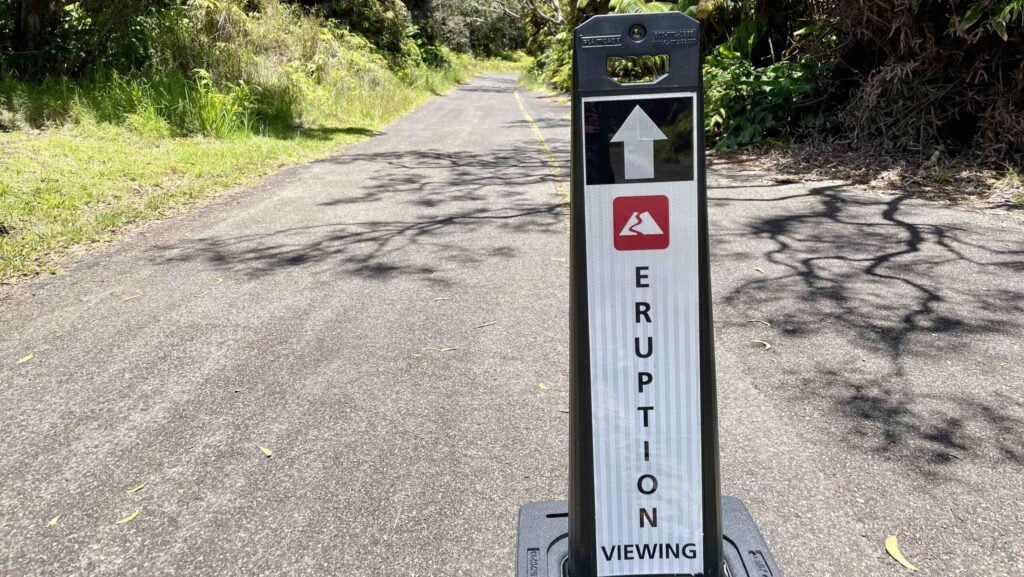
There’s perhaps no better place in the United States to see the power of volcanic activity than here at Hawaiʻi Volcanoes National Park. But it’s a fairly isolated place, prone to extreme weather and conditions, so you definitely want to do some prep work before you go. Here’s my guide for making the most of a trip.
1. Prepare for your Hawaii Volcanoes National Park visit.
Seeing active lava flow isn’t the only aspect of Volcanoes National Park that you can’t predict; the fog, vog (volcanic fog or unclear air), mist, and rain move through without much predictability. The National Weather Service may anticipate 30 percent chance of rain in the morning on a day you spend soaked to the core all day (I’ve experienced this more than once).
NO PASSPORT NEEDED: 12 Best Beach Resorts in the U.S. for Families
If you’re looking for a clear day, your best bet is to call the Visitor Center or Volcano House Hotel to check on the weather at Hawaii Volcanoes National Park. You want to get as realtime as possible when it comes to knowing what it looks like “on the ground” (do not trust an app or widget on this one), and for the best experience, it pays to be flexible. If you only set aside one day of your trip to the Big Island for the national park, there’s a chance you may not get the views you were hoping to see. That said, the park is magnificent and otherworldly no matter the weather and is most certainly worth the trip, especially if you’re prepared with layers, rain gear, flashlights, good walking shoes, snacks, and water.
2) Time your visit and pack accordingly.
There aren’t many places to find food or water in the park, so plan accordingly. While the town of Volcano is nearby (and there’s a fantastic Thai food truck along the highway), and there is one store, you can’t guarantee it being open or having what your family may want or need. Also, even on the shortest hikes in Volcanoes, visitors need a lot of water—remember, it’s mostly fields of hot black rock.
DISNEY DOES HAWAII: Should You Stay at Disney’s Aulani Resort in Hawaii? Here’s How to Decide
And lastly, when lava flow is happening, it’s most impressive to see the park at night, when you’ll have to walk through darkness to get to that glowing red, steamy view (and photo op). If you stay for night viewing, come prepared for cold and dark—a phone’s flashlight will not be enough for night hiking, so definitely have one flashlight on hand for at least every two walkers (but best is one per person).
3) Start at the visitor center and prioritize your top experiences.
Volcanoes’ Main Entrance leads you to your first stop at the Visitor Center to get oriented. Take the time to check out the maps, both flat and in relief, learn about the regularly changing conditions, and ask any questions before you head out. There are park rangers there to answer your questions, though you may have to wait in a line of curious visitors to ask yours. On a clear day or evening, your first vista should be out the back door of Volcano House across the street from the Visitor Center.
HIGHLY RECOMMENDED: I Took a Dog on a Field Trip in Hawaii and it Was the Best
The breathtaking view of Halema’uma’u Crater (within Kiluea Caldera) gives you a sense of the ever-changing nature of this park and its active volcanoes. From the Volcano House viewpoint 4,000 feet above sea level, you can see where the lava lake has risen and fallen and where rock slides have changed the nature of this crater. If it’s a time of visible lava, it’s best to get here either in the dark hours of the morning or in the late evening (check the park’s information page about parking and traffic for night visiting) to see the lava and smoke plume in the contrast of night; the best view, however, may be an access point around the sides of the crater.
Given the change in lava activity, road and trail openings are variable, so always confirm with the National Parks Service . If it’s open, drive around Chain of Craters Road and stop at the sulfur banks for a treat. Sightseeing along this road will give you ample perspectives on the ever-changing Halema’uma’u crater on Kilauea.
Great Hawaii Volcanoes National Park Hikes
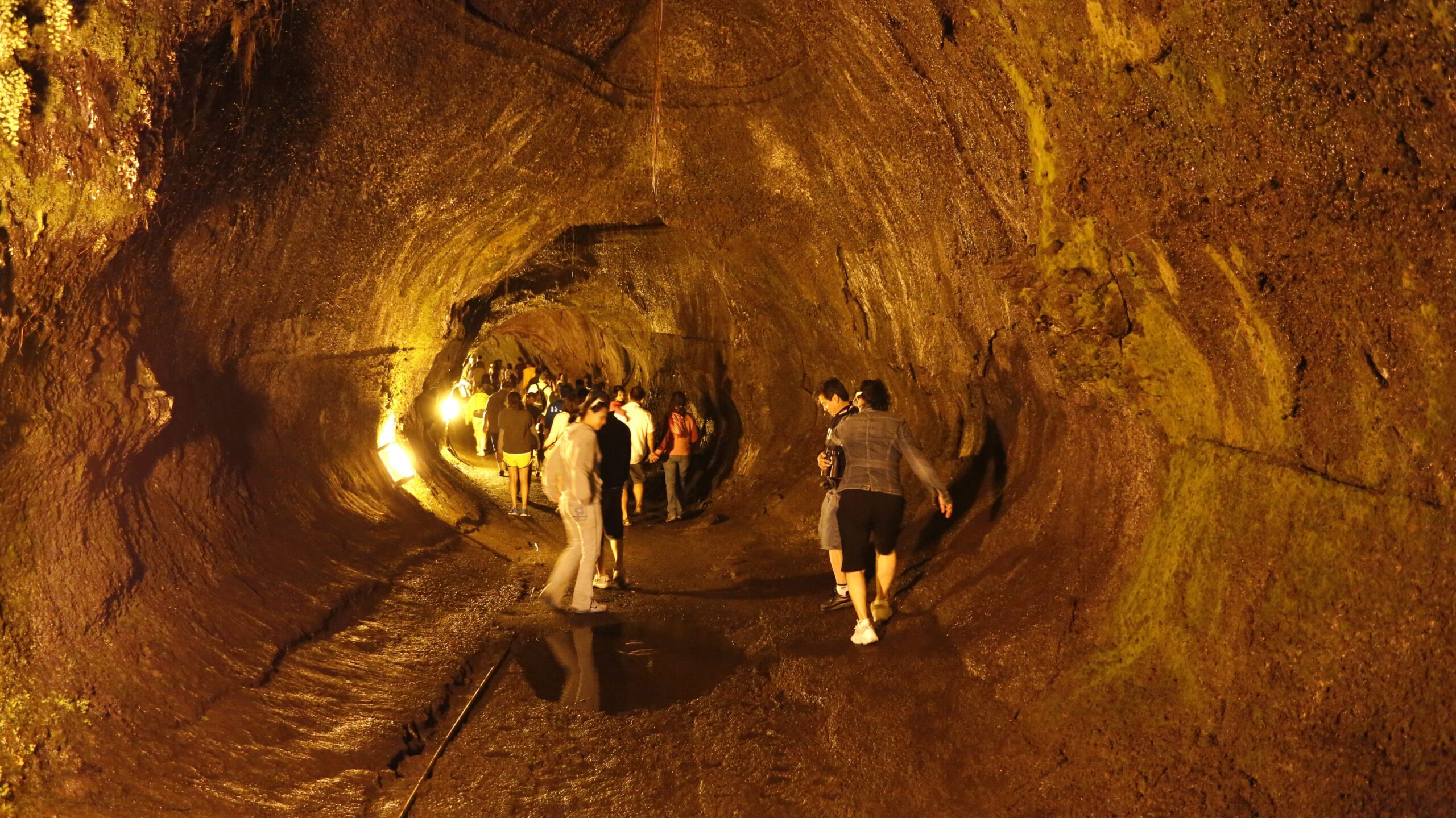
There are several days worth of hikes in and around the park, but the best hikes for families in Hawaii Volcanoes National Park are Thurston Lava Tube, Devastation Trail, and Kilauea Iki. Here’s what you need to know about each of the hiking trails.
My Go-To Hike for Families with Younger Kids: Thurston Lava Tube
Thurston Lava Tube is a great first familiarization walk for any visitor to Hawaii Volcanoes National Park, and at about a half a mile roundtrip, it’s particularly great for families with kids. Parking can be tricky (just keep driving up and down the road near the Lava Tube hiking trail; eventually you’ll time it right and score a spot), but it’s worth it.
NO BLISTERS: 10 Comfortable Shoes That Can Handle a Full Day of Walking
While this is a good trail for families, there are some steep parts, so plan accordingly (if your kids are still small enough to carry, this is a where a hiking backpack might come in handy). The loop trail first takes you down into the lush Hawaiian rain forest on a paved trail with handle rails. Along the way, there are signs to teach you about your surroundings.
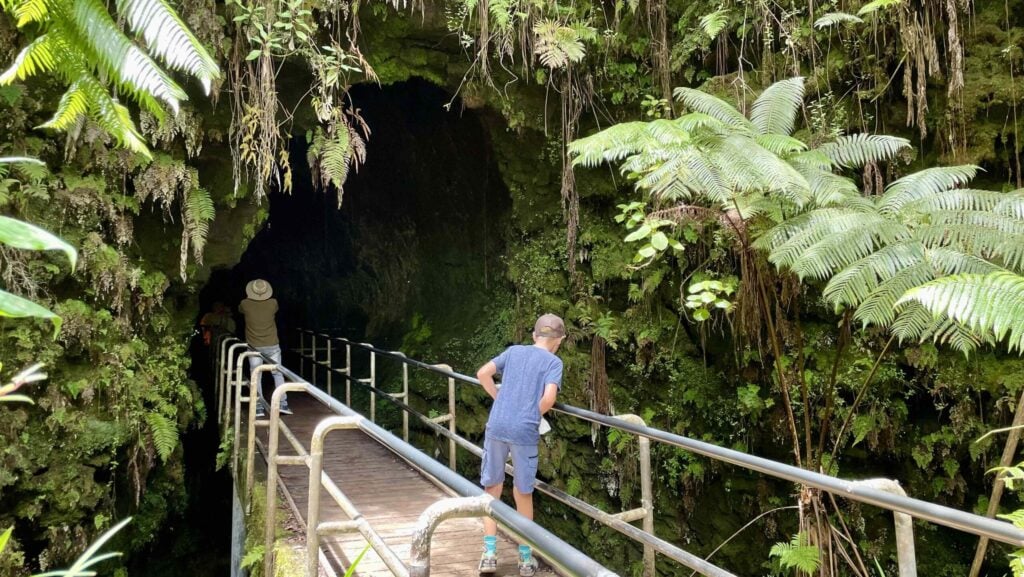
Once you’ve descended, you get to the main attraction: A gentle but also exciting walk through a vast lava tube which is mostly illuminated. Tall adults should watch the side walls, and note that puddles persist year round. If you’re looking for more lava tube adventure, check out Kaumana Caves in nearby Hilo ; there you’ll see how valuable that illumination really is. On the way out of the tube (you go through it and out the other side) there are some stairs, and then a trail back to the top. If you’re feeling ambitious, the Thurston trail intersects with a number of other trails, so you could turn this into a more ambitous hike.
To See the Power of Nature: Devastation Trail at Hawaii Volcanoes National Park
Slightly less devastating than it was 30 years ago because, well, things grow, Devastation Trail is a great example of what happens when once-lush tropical land is completely covered in lava and ash. The further you stroll along the short, half-mile paved walkway out into the (somewhat) barren landscape, the greater the sense of the vastness of the (natural and healthy) destruction.
CAN’T DECIDE? Here’s How to Choose the Best Hawaiian Island to Visit
Devastation Trail leads to a fantastic overlook of Pu’u Pua’i, site of the 1959 eruption that shot lava 1,900 feet into the air.
Important Note: It’s always illegal to remove rocks from a national park, and Hawaii Volcanoes National Park is no exception. While you can’t remove the rocks, you can pick them up and admire them, and as you’re walking, it’s fun to keep your eyes peeled for emerald-like crystal olivine in the dark black obsidian rock. You’ll be extra lucky if you find one of Pele’s tears—a lava rock in the shape of the teardrops of the Hawai’ian Goddess of Fire.
For an Ambitious Hike with Great Rewards: Kilauea Iki
Because it’s longer than the other two more gentle walks and has several steep switchbacks on the way up, you may need to gather your reserves to do the Kilauea Iki hike. If you’re thinking about doing this hike with children: It’s certainly doable for kids eight and up, and I know five-year-olds who have done it, but it’s still a little beyond “easy” as family hikes go.
EXOTIC ESCAPES: 10 Best All-Inclusive Honeymoon Resorts in the World
A gentle slope around the flank of the lava lake brings you through native forest where you may get to see Hawaiian birds such as the apapan’e or the amaki’hi and flora like the ohi’a lehua tree or amaʻu ferns. Eventually, you descend into the still-hardening lava lake where steam rises out of cracks and new plants fight their way into existence through the cracks of the lava. Once you’ve crossed the crater, it’s back to the forest, where steep switchbacks challenge you as you appreciate more native forest (or at the least focus on the ground in front of you!).
Hawaii Volcanoes National Park Hotels
If you want to stay in the park, your only hotel choice (which is a good one), is to stay at Volcano House , a historical and recently restored hotel just across Crater Rim Drive from the Kīlauea Visitor Center. The hotel sits on the rim of the Kīlauea caldera (and has truly incredible views), and has 33 guest rooms. It also manages 10 refurbished camper cabins and campsites at Nāmakanipaio Campground, just a short distance away. Even if you’re not staying at Volcano House Hotel, you can stop in for a meal in the dining room, a drink in the lounge, or to buy snacks or souvenirs in the snack bar and gift shop.
The volcano Mauna Loa offers another intriguing option to ambitious outdoorsy types: rustic cabins accessible by backcountry hiking. The National Parks Service describes getting to the cabins as an “extremely grueling, rocky and steep 10.2-mile hike,” and you need a backcountry permit, but I’ve heard the views are unbeatable. You need a backcountry permit to access the cabins.
To stay near the park, check out the options in nearby town of Volcano. It’s a less than 10 minute drive from the visitors center (you can also catch a bus into the park), and the little village is home to a cluster of small inns and B&Bs including Volcano Village Lodge , Lotus Garden Cottages , and Volcano Rainforest Retreat .
Things to Do on the Big Island Beyond Hawaii Volcanoes National Park
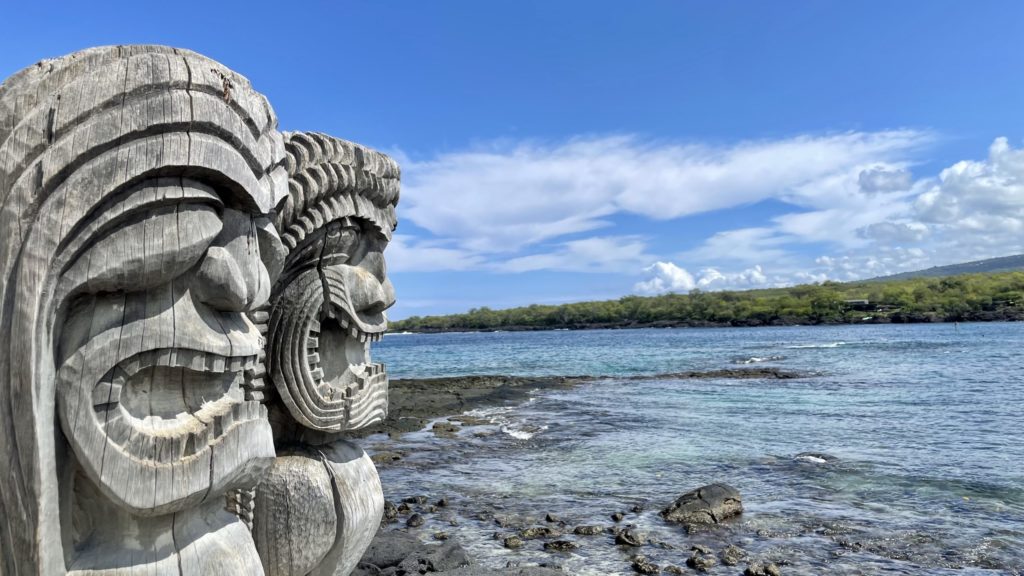
For most Island of Hawai’i visitors, a visit to Hawai’i Volcanoes National Park is a highlight, but certainly not the only thing on the itinerary. Here are some of my favorite things to do on the west (Kona) and east side (Hilo) of the Big Island.
What to Do in and around Hilo
If your main goal is Volcanoes National Park, it’s likely that you’ll come in through Hilo. Hilo’s famous Farmer’s Market happens every day, but from Wednesday through Saturday is when you’ll see the most local artisans and chefs selling their specialties.
Richardson’s Bay in Hilo is a great spot for (brackish) water snorkeling , turtle spotting year-round, and whale sightings in winter. Rainbow Falls and Boiling Pots are two great spots to visit after a rain, when they’re at their most dramatic. And the Hawaii Tropical Bioreserve and Garden is a stunning spot to spend a few hours. Just note it’s a bit steep to get down into the bioreserve (you park along the road, buy a ticket, and then head down into a valley next to the water).
If you’re in Hilo when it’s showing off its claim to fame as the “rainiest city in America” and need some indoor activities, head to the Pacific Tsunami Museum , Mokupapapa (or NOAA’s Marine National Monument museum of the Hawaiian Island chain), or ‘Imiloa —Hilo’s awesome astronomy center.
Kona Side Things to Do
On the “sunny” (Kona) side of the Big Island, you can get a deep understanding of Hawaiian history at the National Monument that is Puʻuhonua o Honaunau, or City of Refuge, and then can hop across the way to go snorkeling at the pristine Honaunau Bay.
Many of Hawaii’s famous beaches line this coast, most notable being Hapuna Beach and the beach at the Mauna Kea Beach Hotel . Note that all Hawaiian beaches are public right of way, but the Mauna Kea Beach Hotel beach keeps most people out by limiting parking spaces. My advice is to gather your beach essentials and either get there very early in the morning or wait until late afternoon to get a public access parking space. (It’s worth noting that the Mauna Kea Beach Hotel ranks as one of the best family hotels in Hawaii across all of the islands.)
SHADY DAYS: 10 Breezy Beach Tents That Are Easy to Set Up and Take Down
A visit to the Big Island wouldn’t be complete without a trip the visitor information station at the Onizuka Center for International Astronomy , situated at the 9,200-foot elevation point on Mauna Kea. Most important, check the weather and road conditions before you go and make sure it will be a clear night.
Drive up in late afternoon to watch the sunset over the peaks of the island, then enjoy one of the most dramatic starry nights on earth, but come prepared for cold and elevation. Stop along the way to let your body acclimate to the dramatic elevation change, drink plenty of water, and bring a flashlight/head lamp and layers. Since visitor information station is no longer is hosting stargazing tours, it’s best to book with a tour group to get the full experience.
More from FamilyVacationist:
- 7 Iconic U.S. Attractions Kids Should See Before They Grow Up
- 11 Budget-Friendly Family Vacations That Are Super Fun
- 10 Best All-Inclusive Beach Resorts in the World

Meeting characters on Disney Cruise Line can literally ‘make’ your kid’s vacation—here are 5 ways to get the most out of your experience

Affected by South Rim Grand Canyon waterline break? How to salvage your vacation

Tips for a trip to Navajo National Monument (and Navajo and Hopi Lands)
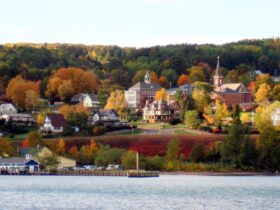
10 best family vacation ideas for fall 2024, according to travelers and experts

familyvacationist

8 Caribbean family resorts with villas that feel like private vacation homes
These Caribbean gems combine resort amenities with the seclusion and space of a vacation home.
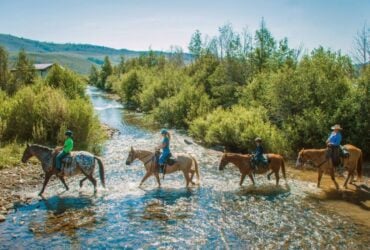
10 best dude ranches for families in the U.S. and Canada
Breathe in the fresh air and explore the scenic surroundings on horseback at these family-friendly dude ranches.

Everything you need to know about Universal Orlando’s Halloween Horror Nights 2024
The mega-popular event is returning to Universal Orlando this year.
CS Ginger Travel
19 Best Things to Do in the Big Island National Park: Hawaii Volcanoes

LOOKING FOR THINGS TO DO IN THE BIG ISLAND NATIONAL PARK?
You’ve come to the right place! We love the national parks in the United States and have visited over 30 national parks. Hawaii Volcanoes was one of the most unique parks we have been to. During our last visit to the Big Island we had a great time exploring this amazing national park.
The Big Island National Park is one of the most unique geological sites in the world. The park is home to the world’s largest active volcanos, Mauna Loa and Kilauea. Visitors can see lava flows, steam vents, and even volcanic craters.
Big Island National Park is also the best place for hiking volcanoes in Hawaii, camping, and bird watching. There are many different trails to explore, and the scenery is simply breathtaking. Whether you’re interested in geology or just looking for a beautiful place to spend some time, Big Island National Park is definitely worth a visit.

During our last visit, we took some time to explore Volcanoes National Park. We were pleasantly surprised at how easy it was to see so much during our visit. We had such a fun time exploring the different trails and seeing the different craters and volcanic features.
Kilauea Visitor Center Operating Hours: Daily, 7:45 a.m. to 5 p.m. Ranger Station and Chain of Craters Road: 1 0 a.m. to 9 p.m. Entrance Fee: $30 per vehicle or free with the America the Beautiful Pass

Hawaii Volcanoes National Park Tours
1. big island twilight volcano and stargazing tour.
The Big Island Twilight Volcano and Stargazing Tour is the perfect way to experience the beauty of Hawaii after dark. This intimate tour takes you to see Volcanoes National Park, followed by a stargazing session at Mauna Kea.
The tour starts at some of the most tantalizing sights when the sky is ablaze with colors as the sun sets over the horizon.
As night falls, you’ll be able to see the glowing lava as it flows into the ocean. Afterward, you’ll head up to Mauna Kea, where you’ll have a front-row seat to some of the clearest night skies in the world. With expert guidance, you’ll be able to spot constellations, planets, and even distant galaxies. It’s an unforgettable experience that’s not to be missed.
Not only will you see some beautiful sights, but their provided lunch and dinner with Hawaiian sweet bread is a real treat.
▶ BOOK Volcano and Stargazing Tour
2. Eco Tour of Hawaii Volcanoes National Park
The Eco Tour of Hawaii Volcanoes National Park takes you through one of the most unique places on Earth. As you explore the park, you will see native wildlife like Hawaiian honeycreepers and Nene Geese.
The tour has two options for their private tour. You can do a 3 or 6-hour tour. A private Volcanoes National Park tour is the best way to explore and experience Kilauea’s summit.

The lava-sculpted landscape is truly breathtaking. The goal of this tour is to provide you with an intimate experience of this special place. They will take you off the beaten path to see some of the park’s hidden gems and share stories about the history, culture, and ecology of Hawaii Volcanoes National Park.
By the end of the tour, you’ll have a deep understanding and appreciation for this national treasure. You will love to tour Hawaii Volcanoes National Park.
▶ BOOK Eco Tour of Volcanoes National Park
3. Volcanoes National Park Tour from Hilo
Volcanoes National Park is one of the most popular tourist destinations on the Big Island of Hawaii. The park is home to Kilauea, one of the most active volcanoes in the world. Visitors can explore lava tubes, view eruptions, and hike through rainforests.
The park also offers a variety of ranger-led programs. The Hilo Shore Excursion: Active Volcano, Lava Tube, Waterfall, and Gardens Tour is the perfect way to see the park. The tour includes round-trip transportation from Hilo, as well as a guided tour of the lava tubes and a hike to see the active volcano.

Tours are led by experienced guides who are familiar with the park and its history.
The Volcanoes National Park Tour from Hilo is an intimate and professional way to see one of Hawaii’s most popular tourist destinations. The tour will also show you the beauty of Hilo with a visit to Rainbow falls and a stop at a local chocolate shop.
▶ BOOK Volcanoes National Park Tour from Hilo
4. Helicopter Tour of Hawaii Volcanoes National Park
The park is home to two of the world’s most active volcanoes, Mount Kilauea and Mauna Loa. Visitors can see firsthand the power of these truly awe-inspiring natural wonders.
One of the best ways to experience the park is from the Circle of Fire Helicopter Tour from Hilo . This tour provides an intimate look at the lava flows, steam vents, and craters that dot the landscape. They also offer a unique perspective on the size and scale of the volcanoes.
If you’re looking for an unforgettable way to experience Hawaii Volcanoes National Park, consider taking a helicopter tour. You can choose between a morning or afternoon tour.
▶ BOOK Circle of Fire Helicopter Tour
Best Things to Do in Hawaii Volcanoes National Park
Tip: If you aren’t going on a guided tour, we highly recommend using this self-guided audio tour . It is really inexpensive but adds so much to your experience in the park. It shares so many great facts and stories from the history of this area.
5. Hawaii Volcanoes National Park Visitor Center

The Hawaii Volcanoes National Park Visitor Center is the perfect place to learn about the fascinating geology of the Hawaiian Islands. The center, which is located in Hilo on the Big Island of Hawaii, offers a variety of interactive exhibits that explain the formation of the Hawaiian Islands and the unique geological features of each island.
The center also showcases the work of local artists and scientists and offers a variety of educational programs for both children and adults.
Whether you’re looking to learn more about Hawaii’s unique geology or simply want to enjoy some stunning artwork, the Hawaii Volcanoes National Park Visitor Center offers something for everyone.
6. Crater Rim Drive

Crater Rim Drive is one of Hawaii’s most popular drives. The drive takes visitors around the rim of Haleakala crater, providing stunning views of the crater floor and the surrounding landscape. Haleakala is an active volcano, and the crater is home to a variety of plant and animal life.
The drive also passes through several towns, giving visitors a chance to experience Hawaiian culture. Crater Rim Drive is a must-see for anyone visiting Hawaii.
7. Halema’uma’u Crater
Nestled within Hawai‘i Volcanoes National Park, Halema‘uma‘u Crater is one of the most iconic features of the Big Island. This massive crater was formed during a centuries-long eruption that came to an end in 2018.
Today, it is a popular destination for hikers and nature lovers, who come to marvel at its size and beauty.
The crater is also home to a number of rare plants and animals, making it a vital part of the island’s ecosystem. In addition, the crater serves as a reminder of the power of nature and the ever-changing landscape of Hawai‘i.
For all these reasons, Halema‘uma‘u Crater is an essential part of the island’s identity.

8. Drive the Hilani Pali Road
The Hilani Pali Road in Hawaii is one of the most beautiful and scenic drives in the world. The road winds through lush rainforests, towering waterfalls, and pristine beaches. The Hilani Pali Road is also one of the most dangerous roads in Hawaii, with numerous blind turns and steep drop-offs.
The Hilani Pali Road is definitely worth the drive as long as you are attentive to your surroundings. The views are simply breathtaking, and there’s no better way to experience the beauty of Hawaii. Just be sure to drive carefully and always be aware of your surroundings.
9. Drive the Chain of Craters Road

The Chain of Craters Road is one of the most unique and scenic drives in the world. Located on the Big Island of Hawaii, the road takes you through a lava field that was created by a series of volcanic eruptions. The most recent eruption occurred in 1993, and since then, the lava has slowly cooled and hardened, creating an otherworldly landscape.
This was our favorite part of Volcanoes National Park. The drive will take you about 90 minutes, depending on how long and how often you stop. Craters and other volcanic highlights are found in the first four miles.
It is a fun area to drive through and get out of the car when something catches your eye. We especially enjoyed the Mauna Ulu stop. There are lava flows from as recent as 1979.
Today, the road is a popular tourist destination, and it offers visitors an up-close look at the power of nature. It is worth the drive and will leave everyone with a great visual of the island.
10. Volcano House
The Volcano House is one of the most iconic hotels in Hawaii. Nestled within Hawaii Volcanoes National Park, it is the perfect place to experience the power and beauty of an active volcano.
Guests can admire the churning lava from the comfort of their room or take a closer look at one of the hotel’s guided Volcanoes National Park Hikes.
There is also a Museum of Volcanoes on site, providing visitors with an opportunity to learn about the history and science of these fascinating natural wonders. Whether you are looking for a once-in-a-lifetime experience or simply want to enjoy some of the best views in Hawaii, the Volcano House is sure to exceed your expectations.
The hotel is 4,000 feet above sea level surrounded by some of the most unique landscapes in the world. The Hotel is inviting with great reviews.
11. Kilauea Crater

The Kilauea Crater is one of the most popular tourist destinations on the Big Island of Hawaii. The crater is located within Hawaii Volcanoes National Park and is home to an active volcano.
Although the volcano has been erupting continuously since 1983, the crater itself is relatively small and safe to visit.
Visitors can take a boat tour to see the lava flowing into the ocean, or they can hike to the crater’s rim, where they can get a close-up view of the lava flow. The Kilauea Crater is also a popular spot for stargazing, as the lack of light pollution makes it one of the best places in Hawaii to see the night sky.
There are several museums and educational centers near the crater, making it an ideal destination for families. Despite its popularity, Kilauea Crater is also one of the most dangerous tourist destinations in Hawaii, so make sure you are paying attention because volcanoes can be unpredictable.
The lava flow is unpredictable, so it is always a good idea to check in at the visitor center before your visit.
12. Thurston Lava Tube
The Thurston Lava Tube is a favorite for many visitors to the Big Island of Hawaii. This natural wonder was formed when a river of molten lava cooled and hardened, creating a tunnel that is now large enough for people to walk through.
Visitors can explore the tube’s twisting passages and learn about its formation from interactive displays.
In addition to its fascinating history, the Thurston Lava Tube offers stunning views of the surrounding lava fields. With its otherworldly landscape and fascinating geological features, the Thurston Lava Tube is an unforgettable experience for all who visit it.

13. Kilauea Iki Crater Hike
The Kilauea Iki Crater Hike is a popular hiking trail in Hawaii. The trailhead is located near the town of Volcano, and the hike itself takes about four hours to complete. The trail winds through lush rainforest and passes by several lava flows before descending into the crater itself.
The crater is a massive volcanic basin that is still active, and it is filled with steaming fumaroles and churning lava lakes. The hike can be challenging at times and is considered a moderately difficult hike.
The views from inside the crater are truly breathtaking, and it is an unforgettable experience to stand atop an active volcano. If you are looking for an adventure while visiting Hawaii, the Kilauea Iki Crater is a highly enjoyable trail.

14. Mauna Loa Lookout
As you drive up the winding road to Mauna Loa Lookout, you can’t help but be awestruck by the views. On one side, the massive volcano looms large, while on the other side, the ocean stretches out to the horizon.
The lookout itself is perched on the edge of a cliff, providing an unobstructed view of both the volcano and the ocean. But this isn’t just a place to take in the view; it’s also a place to learn about the history and geology of Mauna Loa.
There are informational displays about the volcano’s formation and eruption history, as well as a seismograph that monitors earthquake activity. This is an ideal spot for anyone interested in geology or Hawaiian history.
Even if you’re not particularly interested in either of those things, it’s impossible not to be impressed by the sheer size and majesty of Mauna Loa.
15. Pu’u Loa Petroglyphs
The Pu’u Loa Petroglyphs are the largest concentration of ancient rock carvings in Hawaii. Found on the Big Island, these glyphs offer a glimpse into the lives of the island’s first inhabitants. Most of the carvings depict human figures, often engaged in daily activities such as fishing and hunting.
Other petroglyphs depict animals, plants, and geometric shapes. It is believed that the carvings were made using sharp tools made of stone or bone.
While the meaning of the glyphs is not known for certain, they are thought to be associated with religious beliefs or ritual practices. Gazing at these ancient carvings, it is easy to imagine the lives of Hawaii’s first inhabitants.
The Pu’u Loa Trail will take you through a collection of petroglyphs documenting the life and culture of the native Hawaiians. The trail has about 23,000 petroglyphs, many of which you can see from the boardwalk. It is a moderate hike that is about 1.5 miles.
16. Holei Sea Arch

The Holei Sea Arch is an iconic natural feature on the Big Island of Hawaii. It is at the end of the Chain of Craters Road. This massive arch is formed from lava that cooled and solidified into hard rock. Over time, waves crashing against the rocks eroded the archway, creating the impressive formation that we see today.
The archway is 90 feet high, and the steep cliffs drop into the ocean. Visitors to the Holei Sea Arch admire the spectacular views and take photographs of the beautiful landscape. The Holei Sea Arch is definitely worth a visit.
The Holei Sea Arch is at the end of the Chain of Craters Road. The arch is about 90 feet tall and was cut into the cliff of an ancient lava flow from approximately 500 years ago.
If you’re traveling with kids, this is a great place to let them do some climbing and exploring on the lava rock before driving out of the park. This was one of my kids’ favorite places to explore in the national park.

17. Volcanic Steam Vents
Few things are as awe-inspiring as a volcano. These massive natural wonders can spew lava, ash, and steam, reshaping the landscape instantly. Volcanic steam vents are particularly fascinating as they offer a rare glimpse into the inner workings of a volcano.
These vents are formed when magma comes into contact with groundwater, causing the water to boil and turn to steam. The steam then escapes through cracks in the volcano’s surface, often carrying bits of rocks and other debris with it.
Visitors to volcanic national parks can sometimes get up close to these vents, and the experience is truly unlike anything else.
The steam vents throughout Volcanoes National Park are a cool way to see another feature of these unique and mesmerizing volcanoes at Volcanoes National Park.
18. See the Sulphur Banks (Ha’akulamanu)
Ha‘akulamanu, or the Sulfur Banks, is a popular hiking trail close to the Kilauea Visitor Center. Visitors can see steam vents and smell the rich smell of Sulfur from the CO2, sulfur dioxide, and hydrogen sulfide. Many people often say the smell is reminiscent of rotten eggs.
Ha‘akulamanu trail is also a popular destination for birdwatchers.
The hike is one of the easy trails and is about 1.2 miles round trip from the Kilauea Visitor center. This trail is not recommended for young children but is wheelchair accessible.
19. Devastation Trail

The Devastation Trail in Volcanoes National Park is named for the direct cause of the 1959 Kilauea Iki eruption. The Devastation Trail is an easy wheelchair and stroller trail that is paved, and it is popular for those looking for a relatively short and easy hike. The trail is only one mile long.
This was one of our favorite hikes in Volcanoes National Park because our kids could hop in the stroller when they were tired and explored all over the trail.
The trail offers stunning views of the different landscapes in the area. You will see areas with little vegetation to dense vegetation areas and a great view of the Kilauea caldera. You can see where a forest was engulfed in cinders from the mountains of lava and see the cinder cone.
MAP OF THINGS TO SEE IN HAWAII VOLCANOES NATIONAL PARK
Hawaii Volcanoes National Park Animals
There are a variety of animals that you might see during your visit to Hawaii Volcanoes National Park. The most famous residents of the park are the Hawaiian Nene or Hawaiian geese. These birds were once on the brink of extinction, but thanks to conservation efforts, their populations are getting better.
Other animal species that call the park home include Hawaii mongooses, red-footed boobies, and several types of endemic fish.
You might even encounter an endangered Hawaiian monk seal basking on the beach. Keep your eyes peeled during your visit to Hawaii Volcanoes National Park, you never know what kind of wildlife you might see.
Hawaii Volcanoes National Park Weather
The weather at Hawaii Volcanoes National Park is determined by a number of factors, including the elevation of the park, its location on the island of Hawaii, and the time of year. The park is located in a tropical climate, so the weather is generally warm and humid.
You can expect the typical temperature lows to be around 48 degrees F, with the typical high being around 79 degrees F.

Safety at Volcanoes National Park
Volcanoes in the park can be unpredictable. It is important to stay on the trails and follow instructions from the park rangers and any signs. We would recommend starting your visit to the Visitors Center because they will tell you what is happening in the park the day you are there.
This is a great website for some more information and safety tips.
Getting to the Big Island National Park
Hilo to volcanoes national park.
Hilo to Volcanoes National Park is about a 45 min drive via HI-11. It is recommended you rent a car if you are going to be traveling this distance, but you could visit the Volcanoes National Park by taking a tour from Hilo. You can also use a taxi or Uber service, but the difficulty of getting a ride back is unknown.
The Hilo Shore Excursion: Active Volcano, Lava Tube, Waterfall, and Gardens Tour will take you from Hilo to Volcanoes National Park and back. This is a great tour and highly recommended by many.
▶ Check Prices on a Rental Car Here
Kona to Volcanoes National Park
Kona to Volcanoes National Park is just under a 2-hour drive. You will get to Volcanoes by taking the HI-11 and Hawaii Belt Road. Because the trip is over 80 miles one way, it is recommended you have a rented vehicle when visiting Volcanoes National Park from Kona.
The drive is really pretty, and we highly recommend taking a day trip over from Kona if you aren’t going to be staying on the Hilo side of the Big Island.
Hotels Near Big Island National Park
Inside the park: volcano house.
The Volcano House is a beautiful place to stay inside the Volcanoes National Park. It is on the rim of one of the world’s most active volcanoes. The house has 33 guest rooms and dining. They also provide cultural demonstrations and events.
Outside the Park
Jade oasis/palila.
If you are looking for a cute smaller place to stay that is very close to the Volcanoes National Park, you should stay at the five-star Jade Oasis/Palila . This property has 6 room resort with each room being 1 bedroom and 1 bathroom. The Asian style décor is very inviting.
The property has all the amenities you would want for a comfortable stay, including WIFI, coffee makes, comfortable beds, a hot tub, and it is close to a laundry mat.
▶ Check Rate & Book: Jade Oasis/Palila
Volcano Village Estates

Another great place to look at when deciding where to stay near Volcanoes National Park is the Volcano Village Estates . The park is only a 14 min walk with food and the Cooper Center nearby. There are over a hundred 5-star reviews for this cute and inviting location.
The rooms are modern with bright and cute decorations. You can rent multiple different types of places here, from a bungalow to a family cottage with a private kitchen. We love having a kitchen where we can cook and keep for the kids.
▶ Check Rates & Book: Volcano Village Estates
Is Volcanoes National Park Worth Visiting?
If you love nature and are looking for adventure, Volcanoes National Park is definitely worth a visit. The park, which is located on the Big Island of Hawaii, is home to Kilauea, one of the most active volcanoes in the world. Although the volcano has been erupting continuously since 1983, the park is still safe to visit.
Do keep in mind when visiting that some areas don’t have a lot of vegetation. You will see lots of volcanic rock and the plants that initially start to grow in and along the rocks.
In fact, there are plenty of activities to enjoy, from hiking and camping to bird watching and stargazing. Plus, the lava flows provide a stunning natural backdrop. If you’re looking for an exciting and educational experience, Volcanoes National Park is definitely worth a visit.

If you are interested in looking at images and information before your trip to see if the volcano is active, there are some great websites where you can see webcams and photos of the Kilauea volcano.
More Information:
- Kīlauea volcanic activity summary is also available by phone: (808) 967-8862
- Kīlauea webcam images: https://www.usgs.gov/volcanoes/kilauea/webcams
- Kīlauea photos/video: https://www.usgs.gov/volcanoes/kilauea/photo-and-video-chronology
- Kīlauea lava-flow maps: https://www.usgs.gov/volcanoes/kilauea/maps
- Kīlauea FAQs: https://www.usgs.gov/volcanoes/kilauea/faqs
The Best Time to Visit Volcanoes National Park
The best time to visit Volcanoes National Park is April through November. This is when the weather is typically driest. However, don’t let that deter you from going if you cannot make it during that time. It is a nice place to visit year-round.
FAQ: Big Island National Park
What are the two national parks in hawaii.
Haleakala National Park and Hawaii Volcanoes National Park are the two national parks in Hawaii. Haleakala is located on Maui and is home to the Haleakala volcano. The park includes many different trails, as well as the opportunity to stargaze from the summit.
Hawaii Volcanoes National Park is located on Big Island and includes the Kilauea and Mauna Loa volcanoes. The park is home to many different plant and animal species, as well as lava tubes and lava flows. Visitors can hike through the rainforest or see the volcanoes up close by taking a helicopter tour.
How many national parks are on the Big Island?
Volcanoes National Park is the only national park on the Big Island.
What is the name of the national park on the Big Island of Hawaii?
Volcanoes National Park is the national park on the Big Island of Hawaii.

When was Hawaii Volcanoes National Park established?
Hawaii Volcanoes National Park was established on August 1, 1916. It was created to preserve the area’s unique volcanic landscapes and ecosystems.
The total park size is over 500 square miles of land, making it a large national park in the United States. Hawaii Volcanoes National Park is home to two of the world’s most active volcanoes, Mauna Loa and Kilauea.
How much time do you need at Volcano National Park?
When going to Volcanoes National Park, you could spend 1 to 3 days visiting the park. Depending on how in-depth you want to get and how much hiking you will do.
If you are a volcano fanatic, this is the park for you, and you may want to spend a longer time there.

How big is Hawaii Volcanoes National Park?
Hawaii Volcanoes National Park is around 500 to 525 square miles. Hawaii Volcanoes National Park is very large.
What can you do in Volcanoes National Park?
The best thing about Volcanoes National Park is that you can see an active volcano in action. This is also a good park to hike, stargaze, and look for animals.
Can you see lava in Volcanoes National Park?
Yes, you can see lava flows in Volcanoes National Park. However, this can change because volcanoes are not super predictable like Old Faithful in Yellowstone National Park .
What is Volcanoes National Park known for?
Volcanoes National Park is known for its two active volcanoes, Kilauea and Mauna Loa volcanoes. You can see active lava flows and learn a lot about volcanoes at Volcanoes National Park.
Punalu’u Black Sands Beach

Although not in Volcanoes National Park, make sure to visit the nearby Punalu’u Black Sands Beach. It is the most famous black sand beach in Hawaii. Small pieces of lava make up the sand.
There are strong currents here, so be careful if you plan on swimming. You also have a good chance of seeing the endangered Hawksbill and green turtles sunbathing on the beach.
Waterfall, Hilo, Volcanoes, and Black sands beach tour
If you are interested in seeing the Hilo waterfalls along with Volcanoes National Park and this beach, I recommend a tour with Hawaii Outdoor Guides. It is a highly rated tour that will give you the opportunity to see the best parts of the eastern side of the Big Island.

This tour departs from the Kona and Kohala Coast with transportation over to the Hilo side of the island.
Book Your Volcano and Black Sands Beach Tour Here
Conclusion: Big ISland National Park
The Big Island National Park is a great way to see how islands form. The birth of the Hawaiian islands was from volcanic eruptions. There is lots of lava rock and craters like the Halemaumau crater at the Big Island National Park.
This Hawaii national park is one of the best stops if you are on the Big Island. You will love looking off the sea cliffs, and the ancient lava flows coupled with new lava flows. We hope you have a great time on your Hawaii adventure at Volcanoes National Park.
If you’re going to be spending more time on the big island, check out our guide The Best Things to Do on the Big Island in Hawaii .
Pin for Later –

Want more National Parks inspiration? Follow our National Parks Board on Pinterest!
Candice Steele is the owner of CS Ginger, a blog that helps travelers explore the United States in their RVs. Since 2017, she and her family have been providing valuable insider tips about travel experiences suitable for families. They love exploring the country in their RV and offer helpful insights to make RVing easy and family-friendly.
12 Comments
Wow! We are huge National Park fans, but we’ve never been to Hawaii. These pictures are amazing – we might just have to put this on our bucket list!
Hi Julie. Thanks for reading. We love the national parks and Hawaii. It is the best of both worlds! Hope you make it one day. It is well worth the trip!
Wow – great information. I had no idea about these volcanos and can’t wait to plan our next trip. I appreciate the information!
Of course Sandy! We are glad to help. Hopefully you get to visit one day. The Big Island is beautiful!
This is a great post! I was worried about going to the Volcano National Park after the volcano erupted in 2018. So glad to know there are still so many things to do. And those sea turtles! So amazing!
Hi Madison. I’m glad you enjoyed the post. We sure enjoyed our time exploring Volcanoes! We are complete suckers for sea turtles. We will be there if the turtles are there.
Beautiful pictures. I am definitely going to put this National Park on my list! What a cool place to visit.
Visiting a national park in Hawaii is the best of both worlds! Thanks for following along.
I looove volcanos! Years ago I was in Hawaii and my hostel in Hilo did a night walk into the lava fields, one of THE most amazing experiences! Funny enough I don’t even know where we were though! I haven’t checked Volcanoes NP off my park yet but definitely looking forward to it!
This sounds amazing! We were so sad when the eruptions stopped before we visited but it is still an awesome place to visit.
That is such a crazy looking beach! It is nice that they have indoor educational exhibits to see as well as the site itself. I am sure it helps put it all into perspective!
It is a very unique beach but so fun to explore and the exhibits are really very insightful. The visitors center was especially helpful in determining what parts of the park were open.
Leave a Reply Cancel reply
You must be logged in to post a comment.

The Ultimate Hawai’i Volcanoes National Park Adventure Guide
Plan an incredible adventure in Hawaii’s Volcano National Park. Discover the best trails, where to see the lava up close & tips for camping near the park.

When most people think of Hawai’i, they think of paradise. With its lush green islands, dramatic waterfalls, and gorgeous beaches, it’s easy to see why. But what many people don’t know is that Hawai’i is also home to some of the most active volcanoes in the world! So if you’re looking for an adventure, then a trip to Hawai’i Volcanoes National Park is a must.
This incredible park is full of opportunities for exploration and excitement, and in this post, we’ll tell you how to make the most of it. So pack your bags and get ready for the adventure of a lifetime!
Start planning your Hawai’i adventure with this detailed guide to Hawai’i Volcanoes National Park.
This post may contain affiliate links.
Where is Hawai’i Volcanoes National Park?
Hawai’i Volcanoes National Park is located on the southeast side of the Island of Hawai’i, which is commonly known as the Big Island. The Park is spread out over 323,000 acres with almost half the park designated as Wilderness Area.
There is one Visitor’s Center at the entrance of the park in the town of Volcano .
Getting to Hawai’i Volcanoes National Park
The island of Hawai’i has two airports located in Kona and Hilo . The Hawai’i Volcanoes National Park summit area, which is the most widely visited section of the park, is a 45-minute drive from Hilo and 2-2.5 hour drive from Kona.
Most visitors fly into the Kona airport , which means it can be a little busier than Hilo. If you can get reasonable flights, I encourage you to fly into one airport and fly out of the other so that you can experience as much of the island as possible. Be sure to check on one-way rental car prices first. If you’re looking for things to do in Kona during your trip, check out this guide .
Either way, Hawai’i Volcanoes National Park is accessible from either side of the island so don’t fret too much about which airport to fly into. You’ll need a rental car to explore the park as there is no public transportation within the park and other attractions on the rest of the Big Island are pretty spread out.
If you want to rent a campervan or car that you can sleep in, check out Outdoorsy .
Hawai’i Volcanoes National Park Makp

Save this post!
Enter your email & I'll send this post to your inbox! You'll also receive my weekly newsletter full of helpful advice for planning your adventures.
How Much Time To Spend At Hawai’i Volcanoes National Park
If you want to visit lava up close and personal, then you should allow at least TWO full days for visiting Hawai’i Volcanoes National Park . If you don’t plan to view lava up close, you can fit in the highlights of the Hawai’i Volcanoes National Park in one day, but you could also easily spend 3+ days in the park. Let’s just say I wish we would have had more time to explore!
Here are a few tips to help you plan your visit to the park:
- It is $30 per private vehicle to enter the park. Get a National Park Pass before your trip if you plan to visit more than 3 parks in one year.
- The Kilauea Visitor’s Center is open from 9am-5pm daily and will be on your right shortly after entering the park. I strongly recommend you stop here on your way in. They have excellent informational boards that list attractions, ranger talks, current conditions, and suggested itineraries for spending an hour, a full day, or multiple days in the park. You can also talk to rangers regarding any last-minute questions you have.
- At most National Parks, guests work to beat the crowds by getting up early. This is true at Hawai’i Volcanoes National Park, but you also don’t want to miss evenings in the park. The lava viewing is best at night and stargazing can be spectacular in this area as well. Make sure you have plenty of food packed for a full day of adventuring in the park.
- There is a second area of the park, the Kahuku Unit, which is only open Thursday through Sunday from 8am-4pm. This Hawai’i Volcanoes National Park guide focuses on the central summit area of the park near the Kilauea Visitor’s Center, not the Kahuku Unit .

When to Visit Hawai’i Volcanoes National Park
In Hawai’i, temperatures and conditions vary significantly by elevation & time of year. The weather at Kilauea’s summit (4000 feet in elevation) changes daily and can be rainy and chilly any time of the year.
The drier season in Hawai’i is from May-October, but that being said it can rain any time of the year. The coastal area of the park, at the end of Chain of Craters Road, is often hot, dry, and windy with the possibility of passing showers. If you want to avoid crowds, the spring & fall are the best times, in general, for visiting the Big Island.
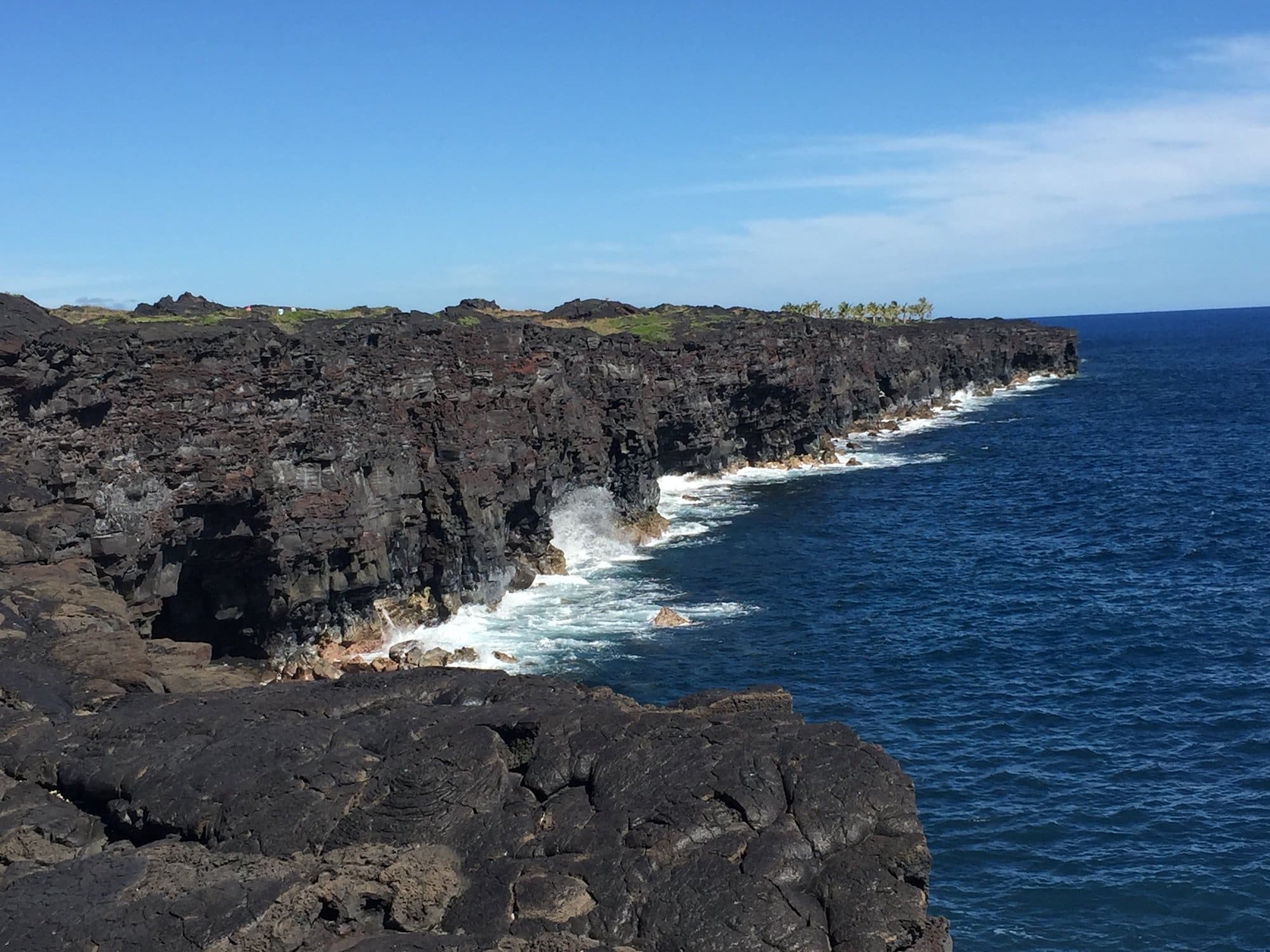
7 Interesting Hawai’i Volcanoes National Park Facts
Every National Park has its own unique history and interesting facts, but because Hawai’i Volcanoes National Park is so dynamic and its landscape changes every year, it’s even more fascinating.
Here are a few fun and interesting facts about Hawai’i Volcanoes National Park:
- Hawai’i Volcanoes National Park encompasses two active volcanoes : Kilauea and Mauna Loa. In 2018, a large eruption of the Kilauea volcano changed the landscape of the park forever and remains one of the most active volcanoes in the world.
- The park was designated a UNESCO World Heritage Site in 1987.
- Mauna Loa is the largest volcano in the world . It stands at over 13,000 feet above sea level.
- Many Hawai’ians believe that Kilauea is inhabited by a family of fire gods, including Pele, the goddess of volcanoes and fire and the creator of the Hawaiian Islands
- The park is home to seven different ecological zones including a tree fern forest, which receives nearly 100 inches of rainfall a year.
- Since Kilauea’s eruption that started in 1983, more than 500 acres of new land have been added to the island of Hawai’i.
- Backpackers can summit Mauna Loa. The trip takes about 4-5 days.
- If you’re lucky, some visitors can see molten lava flow into the ocean.
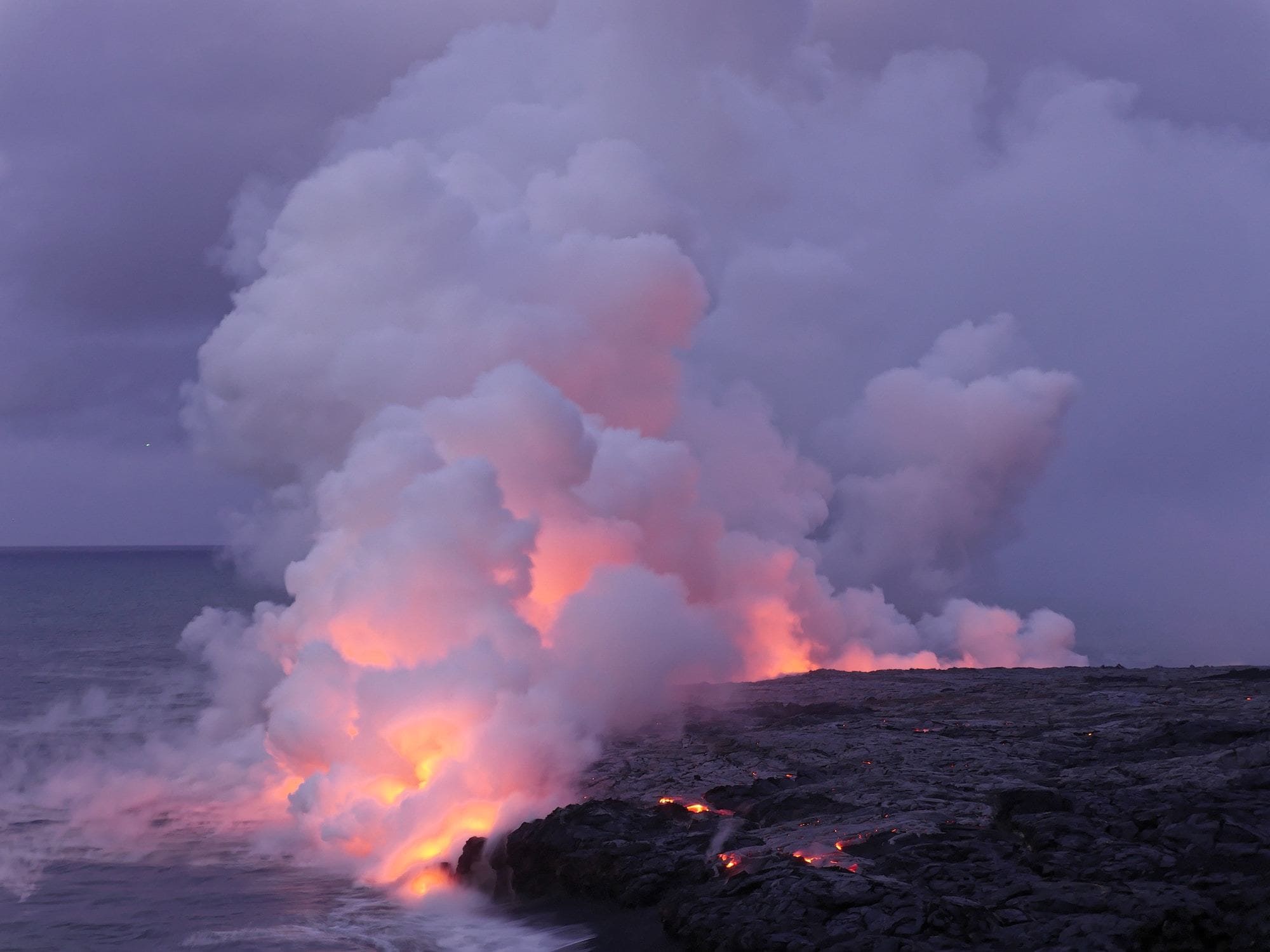
What To Do In Hawai’i Volcanoes National Park
1. stop by the volcano art center.
Just to the left of the Visitor Center is the original Volcano House Lodge which serves now as the Volcano Art Center. The center is a great place to pick up unique, handmade Hawaiian gifts . The Art Center is open 9am-5pm daily.
They offer demonstrations, classes, and workshops, so I recommend checking their calendar before planning your itinerary for the day.
2. Hike the Kilauea Iki Crater Trail
The 4-mile Kilauea Iki Trail Loop will take you from the lookout on Crater Rim Drive down to the floor of Kilauea Iki crater. The Volcanoes National Park Visitor Center sells a great trail guide filled with lots of facts and interesting history, or you can download the guide online .
The trail begins shaded by the surrounding rainforest, but soon enough you’ll be on the floor of what used to be a lava lake. It can be hot and exposed, so be sure to protect your skin from the sun .
This is a beautiful hike and a great intro to exploring the Park. Beat the sun (& the crowds) and start your 2-hour trek before 9 am.
Tip: Don’t miss the Kilauea Iki film in the Visitor’s Center beforehand. It will give a whole new meaning to your hike.
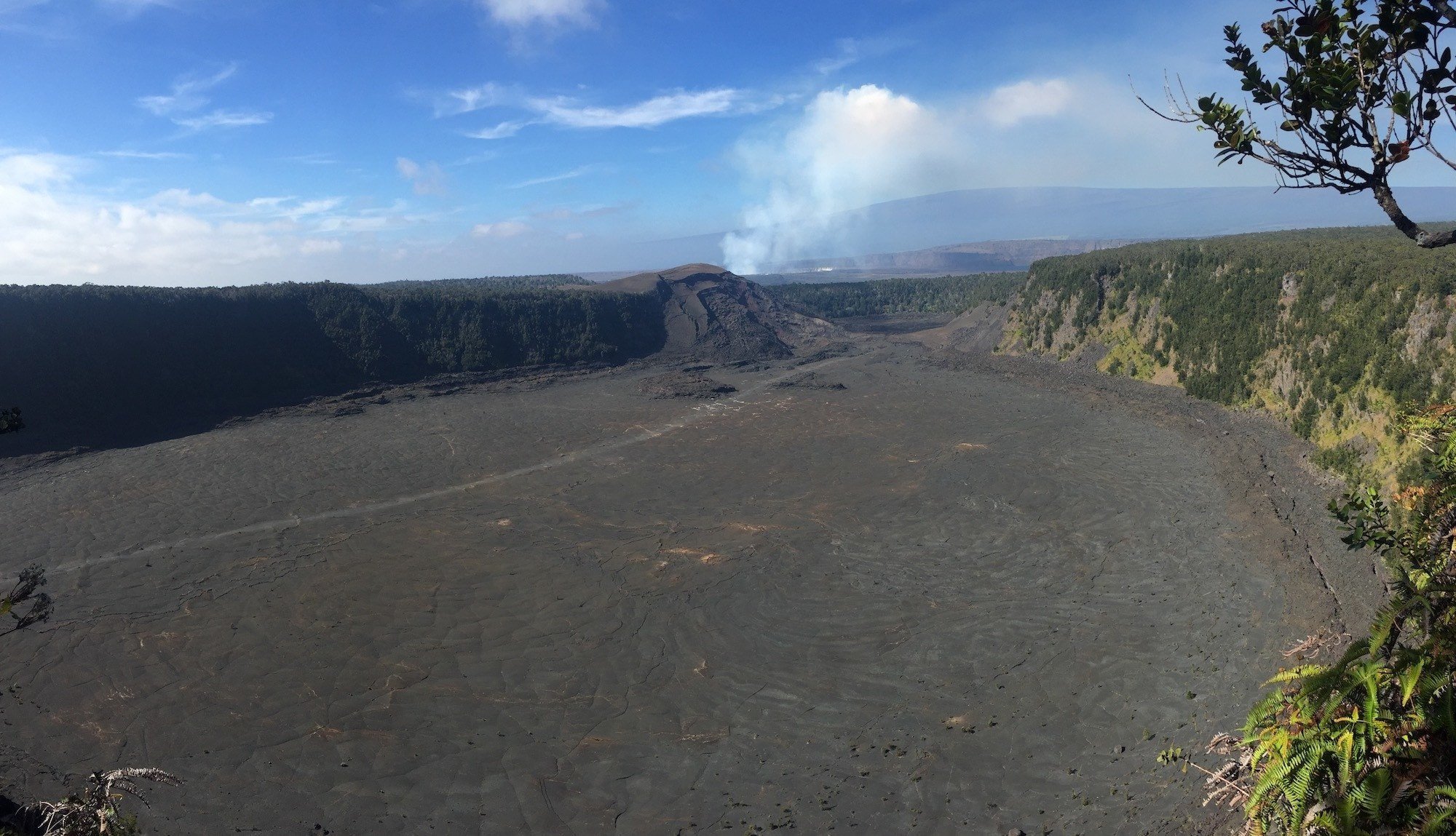
3. Walk through the Thurston Lava Tube
The 500-year-old Thurston Lava Tube in Volcanoes National Park is definitely worth a quick stop, especially if you’ve never had the experience of being in a lava tube. It’s a strange feeling knowing that you’re standing where a stream of 2,000°F lava once flowed!
The Thurston Lava tube is located right across the road from the second Kilauea Iki parking area, so stop by after you’re finished with your Kilauea Iki crater hike.
Alternatively, the lava tube is great for those who can’t complete longer walks or for those traveling with little kids.
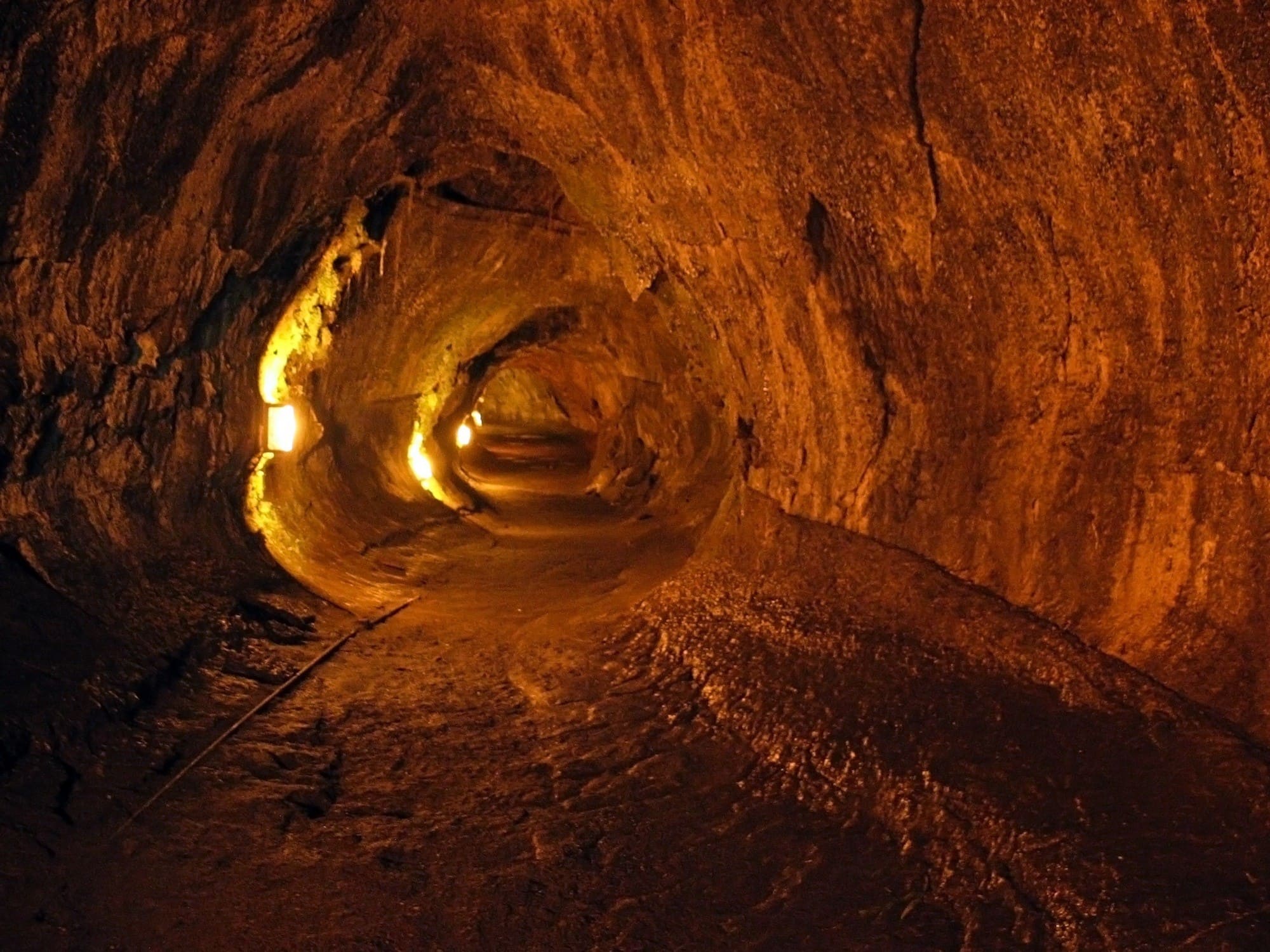
4. Drive Crater Rim Drive to the Holei Sea Arch
Crater Rim Drive is the main road through Hawai’i Volcanoes National Park and it ends at Holei Sea Arch on the Pacific Ocean. There are plenty of stops along the way, so take your time. The drive is almost 19 miles long with an elevation change of 3,700 feet. The reason why this drive is so impressive is you get to visualize how lava has flown across the park over time. Volcanoes National Park has a Crater Rim driving guide .
On the drive, you’ll see examples of both types of lava; a’ā and pāhoehoe. There are areas you can stop and see evidence of former park roads that don’t operate anymore due to lava flowing over the road. There used to be a Visitor Center, a heiau (ancient Hawaiian temple), a campground, and a black sand beach along the road but they have all been covered/destroyed by lava. This was one of my favorite things to do in Hawai’i Volcanoes National Park!

It’s worth taking the road all the way to the sea arch just to see the expansiveness of the lava flow.
History and culture buffs who are looking for a short walk might enjoy the Puu Loa Petroglyphs Trail , but I didn’t think it was as exciting as some of the other sites in the Park.

5. See Lava Flow Up Close
If you’ve seen any photos of Hawai’i Volcanoes National Park, you’ve probably seen images of hot lava up close at night. Unfortunately not everyone is lucky enough to visit when there is active lava flow, but if the lava is flowing, this is a must-do activity.
When I visited in 2018, the best viewing place was an hour north of the Park near the town of Kalapana . Here you could see the lava flowing right into the ocean!
However, in 2024, there is no lava flowing there. The good news is the more recent lava flows have been located right in the heart of Volcanoes National Park, making it much more convenient.
The Volcanoes National Park NPS website has extensive additional information and daily updates on the lava flow . Check this out before your visit so you know what to expect.

Tips for seeing the lava at night
- Bring plenty of water – ideally in a hydration bladder for hands free drinking. The lava puts off a lot of heat, and the air is very dry.
- You should have strong, sturdy hiking boots or tennis shoes. I would not recommend wearing flip-flops, Tevas, or thin-soled tennis shoes, as the lava is sharp.
- If you plan to visit the lava for sunset, make sure you have a flashlight (not your cell phone camera’s light) and extra batteries. We recommend a headlamp .

Where to Eat Near Volcanoes National Park
Just a word of note, there aren’t a ton of dining options in the local area and there are a lot of tourists. I highly recommend making food reservations once you have your trip planning completed. There isn’t a main “downtown” area in Volcano, Hawai’i, and the surrounding community is similar to a rural area on the mainland.
The Kilauea Lodge , in Volcano, Hawai’i, did not disappoint for breakfast. They have a unique menu for breakfast, lunch, and dinner that is slightly European, yet has local Hawaiian favorites.
Both Tuk Tuk Thai Food Wagon & Cafe Ono came highly recommended to us by both locals and tourists, but since we had a substantial breakfast, we munched on snacks in our car until dinner.
If you only have a day in the park, I recommend packing enough food so that you don’t have to leave just to get lunch. Cafe Ono closes after lunch and Tuk Tuk Thai closes at 6pm.
Ohelo Cafe offered an excellent dinner for a reasonable price, especially considering there are few other options in the town of Volcano open past 6pm. They have wood-fired pizzas as well as other options and specialize in serving fresh food with a Hawaiian flair. They are closed Tuesdays and Wednesdays and reservations are strongly recommended.
Packing Food from Hilo
There are great grocery stores in Hilo. I recommend stocking up on snacks before heading to Volcano. Island Naturals has tons of options if you are vegan/gluten-free. The Hilo Farmers Market , open 7 days a week, is also an excellent choice for picking up local fresh fruit/vegetables.
After visiting the National Park, I recommend a stop at Volcano Winery, which offers tours and tastings by reservation only. They carry a traditional Pinot Noir and also offer unique creations like Mele, Mac Nut Honey Wine, and Guava Wine.
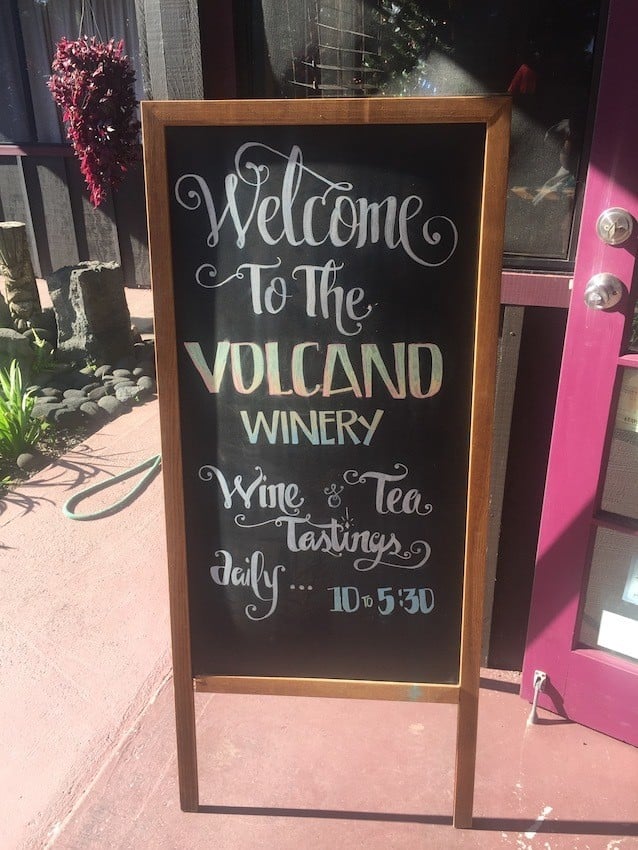
Where to Stay Near Volcanoes National Park
There are two drive-in campgrounds in the park:
Namakanipalo Reservable Campground
- The campground is run by the Volcanoes Lodging Company, which also operates the only hotel in the National Park, the Volcano House Hotel
- 16 Tents sites are available as well as 10 one-room rustic cabins
- The campground has restrooms, water, picnic tables, and barbeque pits
- The campground is at 4,000 feet so it is cool & damp year-round. You’ll want to make sure you have a tent that is waterproof with a quality rain fly. You can rent a tent from the Volcanoes Lodging Company for an additional $40 if you aren’t traveling with camping equipment.
- Campground reservations can be made online or by calling the Volcano House.
Kulanaokualki First-Come, First-Serve Campground
- Located 5 miles down Hillina Pali Road at 2,700 feet elevation
- Nine campsites are available on a first-come, first-served basis
- The campground has picnic tables and pit toilets, but NO WATER
- Sites are $10 per night
- No pets allowed
Additional Lodging Options
Volcano house lodge.
The Volcano House Lodge is the only hotel in the National Park. It has 33 guest rooms as well as a dining room & lounge. If you’ve stayed at other National Parks hotels, it has a similar slightly rustic vibe. It is a short walk from the Kilauea Visitor Center.
Hotels near the Park
- Volcano Village Lodge
- Lotus Garden Cottages
- Volcano Rainforest Retreat
Recommended Gear to Pack
For a complete packing list, head over to our Hawai’i Packing List For Hikers and Outdoor Enthusiasts . Below are a few items we recommend packing that are especially helpful when visiting Hawai’i Volcanoes National Park.
- Hawai’i Volcanoes National Park National Geographic Map – this is a great map that shows hiking trails, points of interest, and other helpful information to make the most of your visit.
- Hawai’i The Big Island Revealed – if you plan on exploring the Big Island outside of the National Park, be sure the pick up this book. It’s filled with great tips on things to do and see.
- Close-toed shoes – sturdy sandals will work, but close-toed shoes are a better choice. Lava rock is incredibly sharp and if you stub your toe, it’ll hurt!
- A Daypack – there aren’t many amenities to be found inside the park boundaries, so be sure to bring a pack big enough to fit everything you’ll need for the day including water, snacks, and your hiking essentials .
Have you visited Hawai’i Volcanoes National Park? What were your favorite things to do? Do you have any helpful tips? Leave us a comment below!

Kim is a former principal who quit her job to solo hike all 2,650 miles of the Pacific Crest Trail. In other words…she’s a badass. She currently lives in Santa Barbara where she practices yoga, whips up tasty vegetarian food, and works as a guide leading kayaking, hiking, and biking tours.
Leave a Reply Cancel reply
Your email address will not be published. Required fields are marked *
Save my name, email, and website in this browser for the next time I comment.
Amazing pictures. Thank you!
How long does the hike up see the lava take? You recommend two days in the park if you want to see the lava but then don’t say how long the hike is mike-wise or time-wise. Thanks
The lava flow in Kalapana changes daily, so mileage can differ depending on what the lava flow is doing. But expect to hike about 4 miles one-way to see the lava.
Thanks for all of the information! Do you have a tour guide/company you would recommend?
Hi Sara, unfortunately this was written by someone who doesn’t write for us anymore so I’m not sure what tour guide/co they went through. Best of luck!
NEW! YOUR LOCAL RUNNING DROP
Get after it with nearby recommendations just for you.
BEST WEEK EVER
Try out unlimited access with 7 days of Outside+ for free.
Start Your Free Trial

The Ultimate Volcanoes National Park Travel Guide
A trip to the largest of Hawaii Island's five national and historic parks is a step back in time, a place where two active volcanoes have long altered the landscape. From 1983 to 2018, lava poured into the Pacific Ocean, as it pounded and shaped the craggy shoreline. Today, endangered birds and rare orchids fill the rainforest and grasslands, geological wonders dot the terrain, and sacred cultural sites speak to the park's mythic roots.
- Share on Facebook
- Share on Reddit
Don't miss a moment of the 2024 Tour de France! Get recaps, insights, and exclusive takes with Velo's daily newsletter. >","name":"in-content-cta","type":"link"}}'>Sign up today! .
It doesn’t matter where I am in Hawaii Volcanoes National Park—standing at the Kilauea Iki overlook, which has views of a mile-long crater, peering into steam vents along the edge of Kilauea Crater, holding my breath at the sulphur banks along the Haakulamanu Trail —the inner geologist in me stirs.
I’ve been visiting this national park for decades, and every time it’s different. I’ve walked along newly formed ledges at night, the black igneous rock crunching under my hiking boots, to watch 2,000-degree molten lava tumble into the ocean. I’ve pulled over on the side of the 18.8-mile Chain of Craters Road, lain on the hood of my rental car, and gawked at a night sky blanketed in stars. I’ve witnessed lava fountaining in the distance, reminding me of this park’s mystic roots—this is the sacred home of the fire goddess Pele, whose unpredictable nature is the force the shapes the land.
Located on the southeastern side of the island, the mammoth 333,308-acre national park is ever changing, due, in large part, to Kilauea, one of the island’s two active shield volcanoes that, up until 2018, had been continuously emitting lava from Puu Oo, a volcanic cone in Kilauea’s eastern rift zone, since 1983. Kilauea has experienced destructive eruptions throughout the decades, like Kalapana in the late eighties and Kapoho in 1960. But in May 2018, an unprecedented event in both scale and strength forced the longest shutdown in the park’s history—134 days—as lava and earthquakes took out trails, park buildings, roads, and water systems; destroyed more than 700 homes in the nearby Puna district; and consumed beloved Kapoho Bay, a favorite spot for snorkeling and swimming. And although the volcanoes’ volatility is a danger, it is also a source of life.
This national park is dynamic and diverse. It stretches from sea level to the summit of 13,679-foot Mauna Loa , the largest volcano in the world, and boasts rugged coastlines, lava fields, lush rainforests, sacred cultural sites, barren desert landscapes, and alpine tundra. There are plenty of places where you can still be alone, despite the more than 1.5 million visitors who flock to the park every year.
What You Need to Know Before You Go
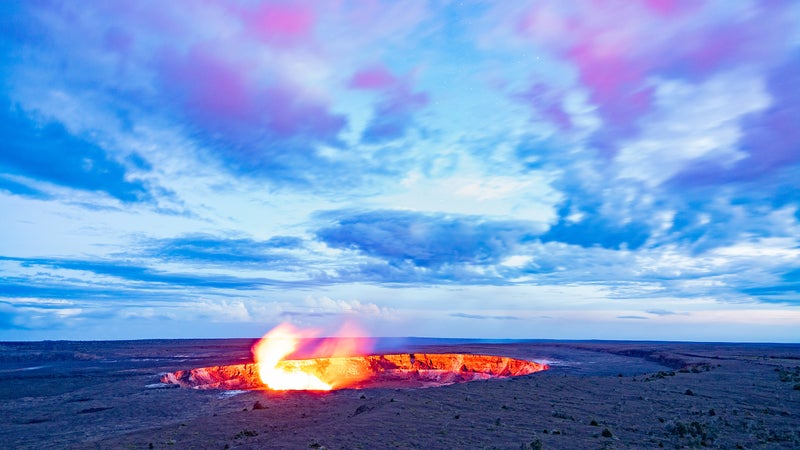
Kilauea is not erupting—at least not right now. This is the most asked question by visitors, and for good reason. The park recently experienced one of the longest continuous eruptions ever recorded, and for those 35 years, people could witness the marvels of volcanism up close—hiking to vents where steam rose from groundwater hitting hot volcanic rock, flying over active lava flows in helicopters, even taking boat tours to watch molten lava seep into the ocean. “We had the most accessible place to see lava in the world,” says Ben Hayes, the park’s chief of interpretation and education. “It’s become an expectation. People ask, ʻWhere’s the lava?’ and our answer is, ‘It’s all around you.’ We still have amazing things to see and experience.” That said, experts believe Kilauea will likely erupt again soon. “Hawaiian Volcano Observatory scientists tell us magma is again moving back to the summit, but no one knows when it will erupt again. There will be signs—earthquakes and elevated levels of volcanic gas—but for now we just don’t know,” says park spokesperson Jessica Ferracane.
It will be colder and wetter than you think. Located on the island’s southeastern side and partly made up of rainforest, the park can get more than 200 inches of rain in a year. (The islands average 17 inches of rain annually.) When Hurricane Lane struck Hawaii Island in August 2018, it was the second-wettest cyclone on record in the U.S., dumping three feet of rain in two days within the park alone. And with an elevation of 4,000 feet above sea level, temperatures here are substantially lower than at an oceanfront resort. Lows are in the forties and highs are in the sixties, regardless of the time of year. “We get a lot of rain. That’s just the Hawaii-volcano experience,” Hayes says. “You need to be prepared. Layers and rainjackets.”
Avoid Tuesdays. This is the day when Pride of America , a cruise ship that sails around Hawaii, docks in the eastern town of Hilo and lets out hundreds of passengers who head straight to the national park for the day. Park staff call it “Turn Left Tuesday,” because they encourage visitors to turn left after entering the park to avoid the Kilauea Visitor Center and head to the coast along Chain of Craters Road first, as crowds will typically hit sights like the Kilauea Iki Trail that leads up to the volcano and Nahuku (a.k.a. the Thurston Lava Tube), both located near the visitor center, before venturing to the coast in the afternoon.
Parts of the park are still closed. In May 2018, the summit area of the park was severely impacted by thousands of earthquakes, which caused rockfalls and damaged buildings, roads, and trails. The park reopened in September 2018, and most of its most popular spots, including the recent reopening of Nahuku , are up and running, but a handful of sites remain closed, including the overlook at the Holei Sea Arch , parts of Crater Rim Drive , and Iliahi Trail, a 1.2-mile rainforest loop hike. Jaggar Museum , which is precariously perched at the edge of Halemaumau Crater, is permanently closed as a result of the crater’s collapse, which went from a depth of 280 to 1,600 feet. A short section of Crater Rim Drive, near the museum, is still closed because the adjoining overlook and parking lot were swallowed up by the crater. The closure of certain areas has also reduced the number of parking spaces in the park—finding an open spot midday can be tough, so plan to arrive early at popular sites.
How to Get There

The nearest airport to Hawaii Volcanoes National Park is Hilo International, about 30 miles to the northeast. It’s an easy, direct drive along Route 11 (Hawaii Belt Road) to the park’s entrance. Along the way you’ll pass through the sleepy towns of Kurtistown and Mountain View, where you can stop by the family-run Hilo Coffee Mill for a cup of locally grown brew. If you’re coming from the western Kona Coast, the drive will take around two hours, a lot of it through desolate lava fields. If you are coming from this direction, though, you can make a pit stop at Ka Lae, also known as South Point, the southernmost point of the 50 states. Looking directly south, out at the Pacific, the nearest landmass is Antarctica. Seriously.
When Is the Best Time to Visit Hawaii Volcanoes National Park?
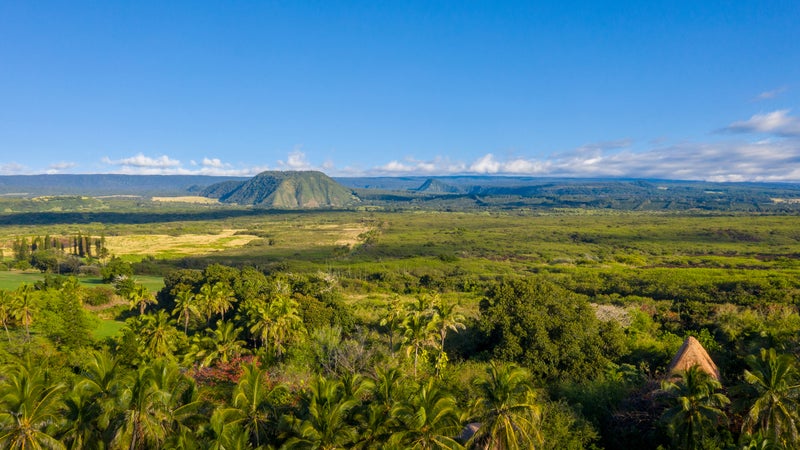
This is Hawaii, so the weather doesn’t vary much month to month, with temperatures averaging between 66 to 85 degrees throughout the year. It does snow on Hawaii Island in the winter months—at the summits of Mauna Loa and Mauna Kea—but that likely won’t affect your visit. Unlike other U.S. national parks that see an influx of visitors during certain seasons, Hawaii Volcanoes National Park is busy year-round, thanks to the island’s sublime weather and moderate climate.
There are really only two seasons in Hawaii: wet and dry. November to March is the rainy season, with higher precipitation on the north and east shores. The weather during these months can often be mercurial: one day it’s blazing hot, another you might wish you’d packed a parka. Winter is a peak season for travel in Hawaii, though, with mainland visitors escaping to the islands from colder climes. It’s also the time when monster surf hits north-facing shores, luring expert wave riders and curious spectators. And thousands of North Pacific humpback whales make their annual migration from Alaska to Hawaii’s warmer waters during these months to mate and give birth. This spectacle boosts the number of cruise ships docking on Hawaii Island, and, according to Hayes, these passengers are likely to visit the national park.
The weather tends to stay cool and wet during the start of spring, making it a good time to visit, as the peak season tapers off and typically busy spots in the park aren’t as crowded. You’ll likely find better rates at nearby hotels, too. The park does get a surge of visitors during spring break ; around the weekend of the annual Merrie Monarch Festival , a weeklong hula competition in Hilo, in April; and during Golden Week, a stretch of Japanese holidays that run from late April through early May, which brings an influx of Japanese visitors to the islands.
Summer and Fall
June and July are exceptionally busy at the park, with families on vacation and gorgeous warm weather luring folks outdoors. Due to its altitude, the area around Kilauea tends to be about 15 degrees cooler than along the coast, which averages 85 degrees, making for great hiking and camping weather. But June through November is also hurricane season in the islands, when tropical storms can bring torrential rain and whipping winds. To avoid the crowds, plan to arrive at the park by sunup, hitting the more popular trails early. Other pathways in the park, like the easy 1.2-mile Kipukapuaulu Trail, which cuts through an old koa and ohia forest, are often uncrowded, even during summer and fall months. And if you really want to get away, head to the park’s Kahuku Unit on the southerly slopes of Mauna Loa, about an hour drive southwest from the Kilauea Visitor Center. This 116,000-acre former ranchland was acquired by the park in 2003 and is open to the public five days a week. Hike to the top of a cinder cone, walk along a historic ranch road to see tree molds and lava flows from 1868, or bike through scenic pastures for some of the best panoramic views of the area. You can also book ranger-guided hikes.
Where to Stay

In the Park
Volcano House (from $220), the only hotel in the park, is perched on the rim of the Kilauea caldera, with a view of Halemaumau Crater. Originally built in 1846, this historic retreat has since been restored and has 33 guest rooms and ten cabins. It also houses a popular restaurant, the Rim, with live music every night. You can walk to the Kilauea Visitor Center from here. If you’re an active-duty or retired member of the military or a Department of Defense employee or sponsor, you can stay at Kilauea Military Camp , which occupies 50 acres in the park. Once a working military post, the camp converted its 90 cottages and apartments into vacation lodgings, with a fitness center, café, general store, and bowling alley available to guests (from $72).
The park also features two drive-in campgrounds: Namakanipaio and Kulanaokuaiki. Both operate on a first-come, first served basis. Namakanipaio , operated by Volcano House, has 16 campsites (from $50) surrounded by fragrant eucalyptus and native ohia trees, with restrooms, running water, picnic tables, and barbecue pits. It’s located at 4,000 feet elevation, so nighttime temperatures can dip into the low thirties. Kulanaokuaiki , meanwhile, sits at an elevation of 3,200 feet and offers eight campsites (from $15). You can also hike and camp in the backcountry (register online or in person, and pay a $10 permit fee per trip) and find yourself completely immersed in the park at one of eight campsites. Halape , on the southern coast of the park, is one of the more popular backcountry sites and can be accessed via the 11.3-mile Puna Coast Trail, 8.5-mile Keauhou Trail, or the 8-mile Hilina Pali Trail. The site sits on a small, secluded sandy beach dotted with coconut trees.
Beyond the Park
Just outside the park’s main entrance, right off Mamalohoa Highway (Hawaii Belt Road), is the quaint town of Volcano—called Volcano Village—where you’ll find a variety of lodgings, from the rooms and cottage at the rustic Kilauea Lodge (from $145) to the more upscale Volcano Rainforest Retreat , where you should book the Sanctuary Cottage, a 200-square-foot hexagonal space with floor-to-ceiling windows and an outdoor bath hidden amid the foliage (from $230). There are even more options in Hilo, about 30 miles northeast of the park. The Inn at Kulaniapia Falls , just a few miles from downtown Hilo, sprawls over 42 lush acres on a cliff overlooking a 120-foot waterfall—the state’s largest privately accessible waterfall (which means no crowds)—with several Asian-inspired, off-the-grid cabins (from $99). The Grand Naniloa Hotel Hilo , a DoubleTree by Hilton, sits on Hilo Bay with 388 guest rooms, 19 suites, and a nine-hole golf course (from $175).
What to Do While You’re There
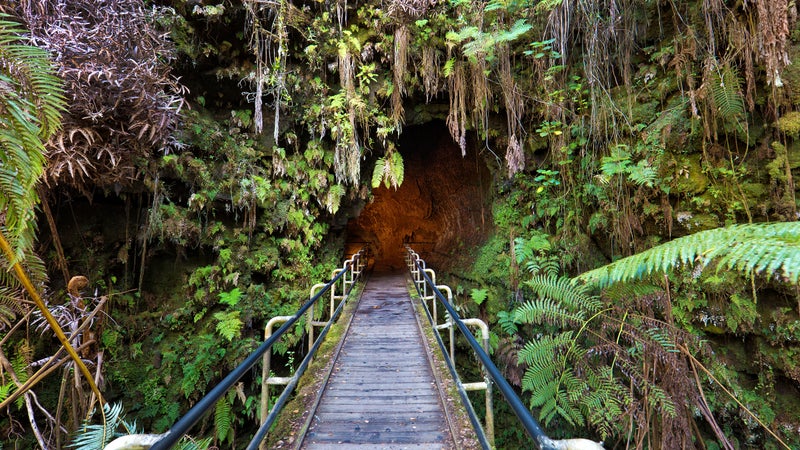
With more than 150 miles of trails, Hawaii Volcanoes National Park is best explored on foot. Hikes range in difficulty from easy walks and half-day treks to challenging expeditions through the park’s wild backcountry. One of the most popular options—and my personal favorite—is the four-mile Kilauea Iki Trail , which reopened in its entirety in September (it was damaged by earthquakes during the 2018 Kilauea eruption). The terrain varies, starting in a forest of native ohia trees and endemic hapuu (Hawaiian tree ferns) and ending with a walk across the massive Kilauea Iki Crater, which was a seething lava lake spewing lava fountains of up to 1,900 feet and now looks like the surface of another planet.
For an easier trek, check out the one-mile stroll along the paved Devastation Trail , which meanders through a stark landscape buried by falling cinder from the lava fountains of the 1959 Kilauea Iki eruption. More experienced hikers—and those looking for some solitude—can tackle the backcountry Maunaiki Trail, which traverses the harsh Kau Desert for two miles to the barren summit of 3,034-foot Maunaiki and offers sweeping views of the park. You can continue beyond the summit for another seven miles to Hilina Pali Road, past craggy cinder cones and fissures and across fields of broken, jagged lava. There’s no water and very little shade, so, as with all hikes, bring sufficient water and sun protection.
There aren’t many places in the world where you can cycle through lava fields. Rent a bike from Big Island Bike Tours and ride along the 8.8-mile Chain of Craters Road to the coast, stopping at the Puu Loa petroglyphs, the largest petroglyph field in Hawaii—there are more than 23,000 images—and a sacred cultural site dated between 1200 and 1450 A.D. Or book a guided excursion with Bike Volcano , which has several options, including a full-day, 15-mile tour of the park from Kilauea Crater down Chain of Craters Road to the ocean.
Bird-Watching
Hawaii is a great destination for bird-watching, primarily because of its collection of unique and rare species, many of which are found nowhere else in the world. More than one-third of all U.S. birds protected by the Endangered Species Act reside here. Endemic birds such as the iiwi (scarlet honeycreeper), amakihi (Hawaiian honeycreeper), elepaio (monarch flycatcher), nene (Hawaiian goose), and io (Hawaiian hawk) can all be spotted at the park. The most accessible place to seek out Hawaii’s endemic forest birds is on the Kipukapualulu Trail , a 1.2-mile loop through pristine native forestland in an area referred to as “bird park.” Grab your binoculars and go in the morning when these small birds are most active. Better yet, book a tour with Hawaii Forest and Trail (from $209), which hosts excellent bird-watching outings. And since the American Birding Association finally included Hawaii as part of its ABA Area in 2016, serious birders can now count the island’s avian species on their life lists.
The Best Places to Eat and Drink Around Hawaii Volcanoes National Park
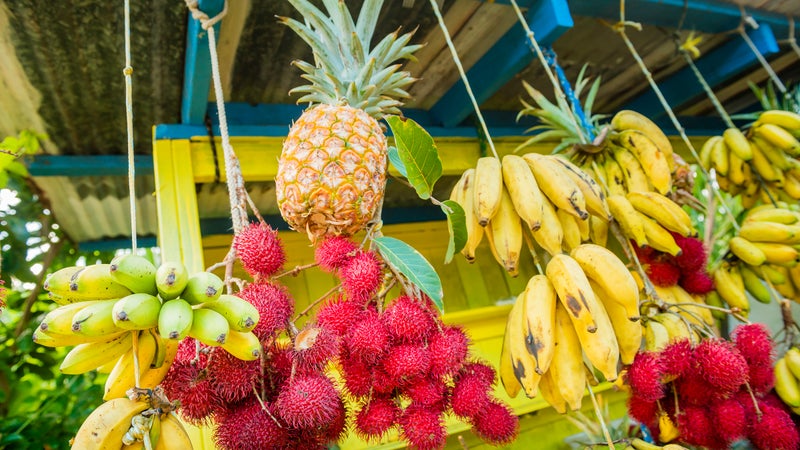
With two million visitors to the park every year—and only one on-site restaurant located at the Volcano House hotel—it’s no wonder eateries and food trucks have popped up in Volcano Village, the small town just outside the park. A favorite is Ohelo Café , a casual spot that serves locally caught fish, shrimp from Keahole, on the westernmost point of the island, and killer baby-back ribs with a house-made Fuji-apple barbecue sauce. Its specialty, though, is wood-fired pizzas, best paired with the local beers on draft. For authentic Thai food, check out Tuk-Tuk Food Wagon , found at nearby Akatsuka Orchid Gardens , about a five-minute drive from the park. Portions are big, and prices are great. For something to bring into the park, Eagle’s Lighthouse Café, next door to Ohelo Café, serves sizable deli sandwiches, hearty soups, salads, and baked goods.
If You Have Time for a Detour

Spend some time in Hilo, on Hawaii Island’s east coast. Here you can visit the lively Hilo Farmers Market ; I recommend Wednesdays and Saturdays, when the daily market swells to more than 200 vendors selling everything from seasonal fruits to Hawaiian-grown coffee. For poke, a dish made with cubed raw fish, visit the no-frills Suisan Fish Market , an iconic fish auction and market right on Hilo Bay. Locals hit up Two Ladies Kitchen for its speciality: strawberry mochi—a large strawberry encased in pillowy-soft, sweet Japanese rice cake. You need to order ahead for these treats, but you can also just pop in and grab a variety of other mochi filled with sweet adzuki (Japanese red-bean paste), peanut butter, or chocolate brownies. (Cash only, FYI.)
Right in town, you’ll find Rainbow Falls, named for the rainbows that show there in the early morning. And if you didn’t do enough hiking at Hawaii Volcanoes National Park, head to Akaka Falls State Park , about 11 miles north of Hilo. A short half-mile hike wanders through a lush rainforest before reaching the first waterfall, the 100-foot Kahuna Falls. Just around the bend is the star attraction: 442-foot Akaka Falls, which cascades into a stream-eroded gorge.
How to Be Conscious
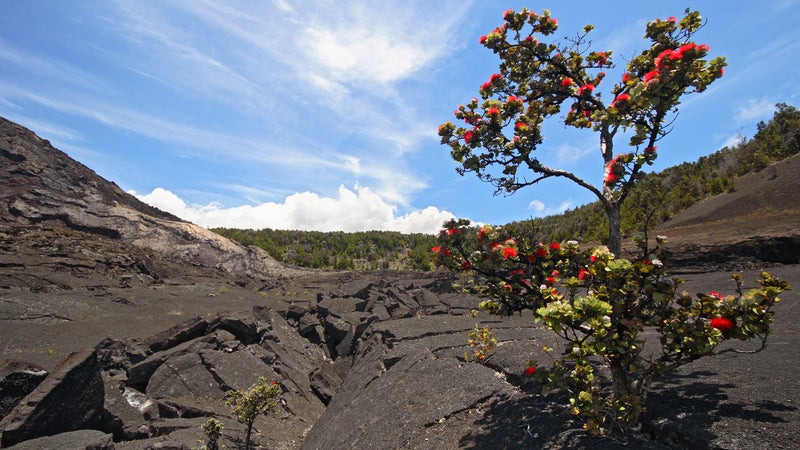
Due to the volcanic nature of the park, it’s especially important to only use open and marked trails, as cliffs, cracks, and steam vents are scattered throughout. It’s also important to leave rocks alone. Park staff often use ahu (stacked rocks) to mark trails. This is not an invitation to do the same. It’s culturally insensitive, not to mention disorienting to hikers. And taking lava rocks is believed to bring bad luck; hundreds of people return them to the park every year.
Hawaii was the first state in the U.S. to ban plastic bags , so you’ll need to bring your own reusable totes or expect to pay for paper bags at shops and stores. Plastic goods are next—the state is gearing up for a massive ban on single-use plastics, to include disposable plates, utensils, and straws, starting in 2021. It has also banned the sale of sunscreen containing reef-harming chemicals, a law that will go into effect in 2021.
- Volcanoes National Park
- Skip to global NPS navigation
- Skip to this park navigation
- Skip to the main content
- Skip to this park information section
- Skip to the footer section

Exiting nps.gov
Alerts in effect, tips for visiting hawai‘i volcanoes national park during busy holiday season.
Contact: Jessica Ferracane , 808-985-6018
Last updated: February 28, 2015
Park footer
Contact info, mailing address:.
P.O. Box 52 Hawaii National Park, HI 96718
808 985-6011
Stay Connected

9 Epic Things We Did With 24 Hours In Lassen Volcanic National Park
Looking to plan the best Lassen Volcanic National Park itinerary in a day?
This park, often overshadowed by its more famous Californian siblings, Yosemite and Sequoia, is a hidden gem that packs a wallop of natural attractions. In just one day, you can explore roaring fumaroles, hike through endless meadows, learn what a Cinder Cone is, and dip your toes in freezing lakes.
Here, I’ll be sharing my itinerary for one day in Lassen Volcanic National Park, detailing the route I took while on my 6 week west coast vanlife road trip.
This easy-to-follow itinerary has been crafted for first-time visitors like you to streamline your visit so you won’t miss any of the must-see spots.
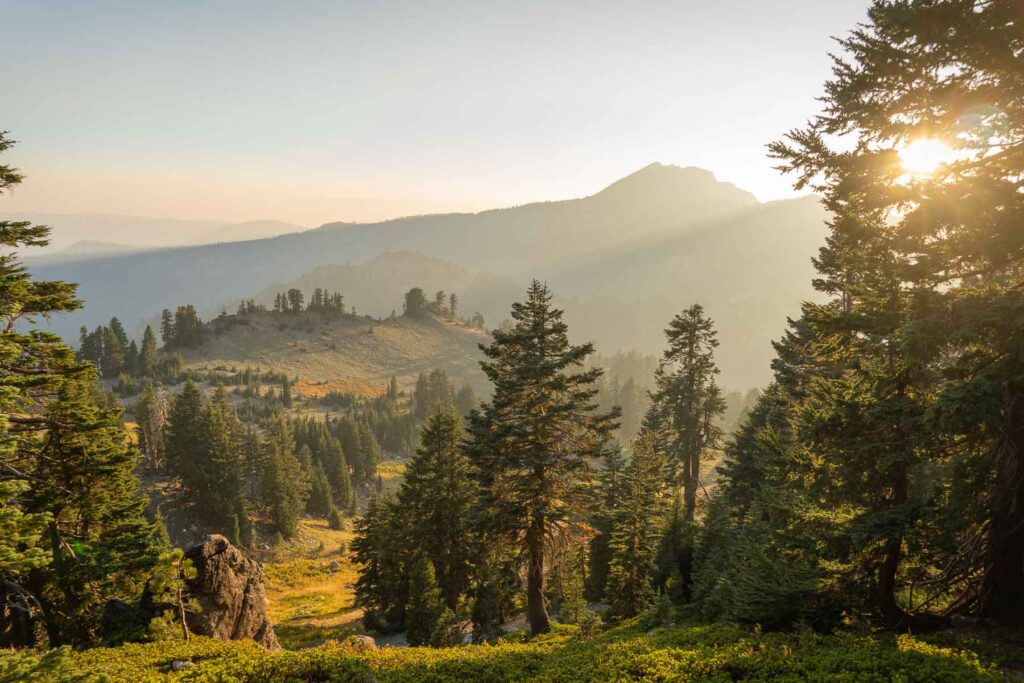
Quick Facts To Visiting Lassen Volcanic
Lassen Volcanic National Park, in northeastern California, is a gem among U.S. national parks, occupying over 106,000 acres of steaming fumaroles, wildflower-speckled meadows, clear mountain lakes, and numerous volcanoes.
As the centerpiece of the park, Lassen Peak is the largest plug dome volcano in the world and is part of one of the most unique volcanic areas on the planet.
Please note that this information may change, so it’s always a good idea to check the official Lassen Volcanic National Park website for the most current details.
Sample One Day in Lassen Volcanic Itinerary
A day in Lassen Volcanic is typically sufficient to experience this incredible place. So, for those pressed for time, here’s a sample itinerary for a day trip:
- Start at the Kohm Yah-mah-nee Visitor Center to get maps and information before starting the 30-mile main park scenic drive .
- Short detour at Sulphur Works , the park’s most accessible hydrothermal area.
- Hike the Bumpass Hell Trail , a 3-mile round-trip hike through the largest hydrothermal area in the park.
- Take a break or lunch at Lake Emerald or Lake Helen .
- Continue to the scenic drive, stopping at Lassen Peak, meadow views, and Devastated Area.
- Explore the Manzanita Lake and Reflection Lake Area for a walk or rent a kayak for a paddle on the water.
- Learn more about the park’s history at the Loomis Museum .
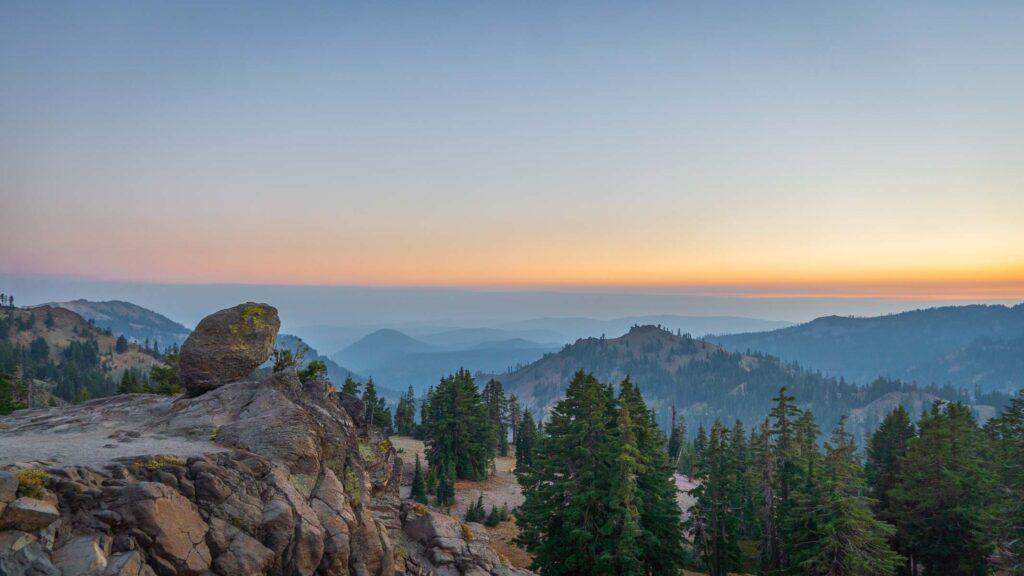
Things to Do in Lassen Volcanic National Park for a Day
Here are some of the best things to do in Lassen Volcanic National Park during your day trip:
1. Visitor Center & Start the Drive Through the Scenic Loop
Start your day at the Kohm Yah-mah-nee Visitor Center, where you can get a map and collect a National Park stamp. The center also has interactive exhibits, films, and ranger-led programs to learn more about the park’s geology, hydrothermal features, and history.
The main attraction of Lassen Volcanic National Park is its scenic drive. The 30-mile loop takes you through the best parts of the park, including Lassen Peak, Sulphur Works, Devastated Area, and more. You can also stop at designated picnic areas and take hikes along the way.
2. Sulphur Works
With steaming fumaroles (steam and volcanic-gas vents) and mud pots, Sulphur Works is a unique and fascinating area. This is the most accessible hydrothermal area of the park, located right off the main road. With its remarkable geothermal features and sulfurous smell, Sulphur Works showcases the park’s volcanic nature up close.
You can walk along the boardwalk to find boiling pools of muddy water and steam vents known as fumaroles, caused by the heat from the magma below the Earth’s crust. Also, it gets pretty sulphuric smelling here, aka that pungent rotten egg aroma.
3. Bumpass Hell Trail
For a real taste of Lassen Volcanic National Park’s geothermal action, take a hike along the Bumpass Hell Trail. Named after Kendall Vanhook Bumpass, a pioneer who severely burnt his leg after falling into a boiling pool, this 3-mile round-trip trail showcases the park’s largest hydrothermal area.
The trail begins at the Bumpass Hell parking area and winds its way through mountainous terrain, with incredible views of Lassen Peak and the surrounding highlands.

As the path descends, you’ll notice a change in the landscape as meadows give way to an otherworldly expanse of bubbling mud pots and steaming fumaroles.
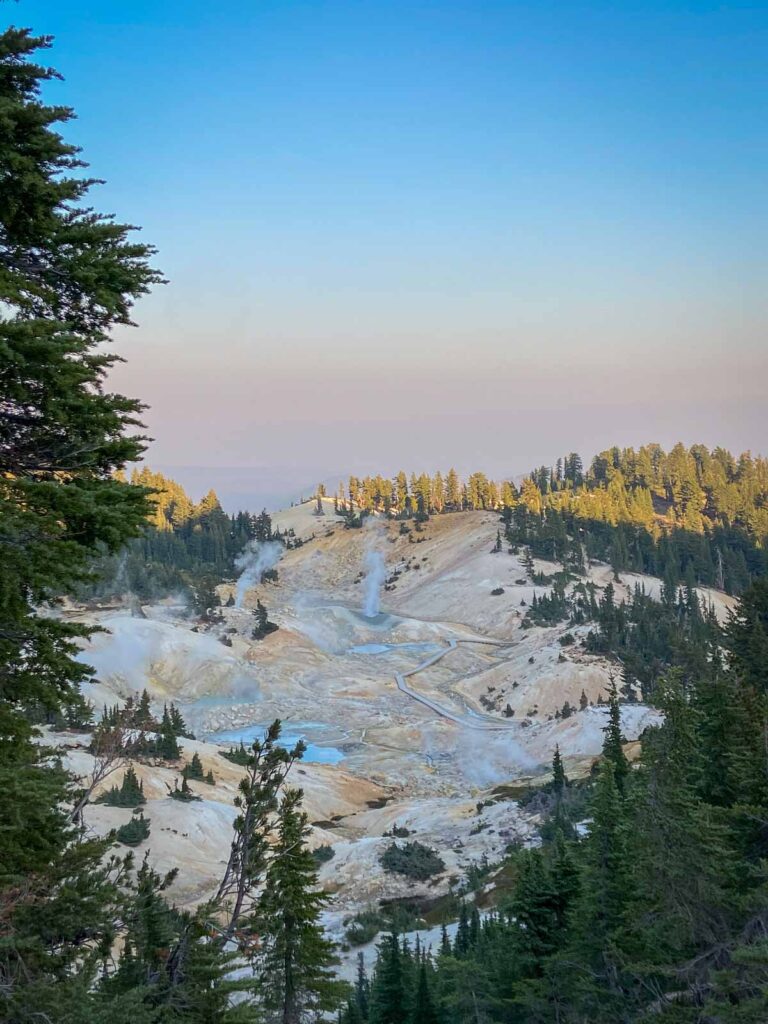
The boardwalk lets you safely walk right on top of this geothermal wonderland.

4. Lake Helen & Lake Emerald
Lake Helen and Lake Emerald are two of Lassen Volcanic National Park’s prettiest bodies of water, at the foothills of its rocky peaks.
Located at an elevation of 8,200 feet, the deep blue Lake Helen is often covered in snow, even in the summer. This lake presents awesome views of Lassen Peak and Reading Peak.
There is a parking area nearby and picnic tables, making it a perfect lunch spot. Its icy cold water may not be suitable for swimming, but it’s a photogenic locale you won’t want to miss.
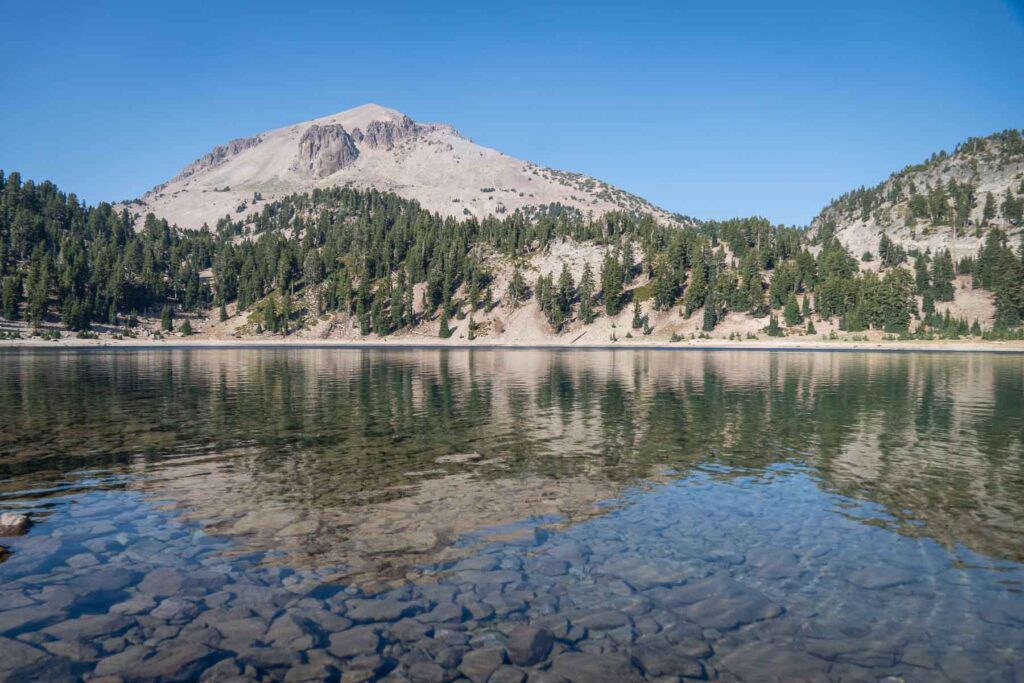
Lake Emerald
Slightly further along is Lake Emerald, another high-altitude lake with a vivid emerald color that gives it its name. The lake’s hue varies with the light and it’s particularly pretty at sunrise and sunset. You can reach Emerald Lake by taking a short detour off the main park road.
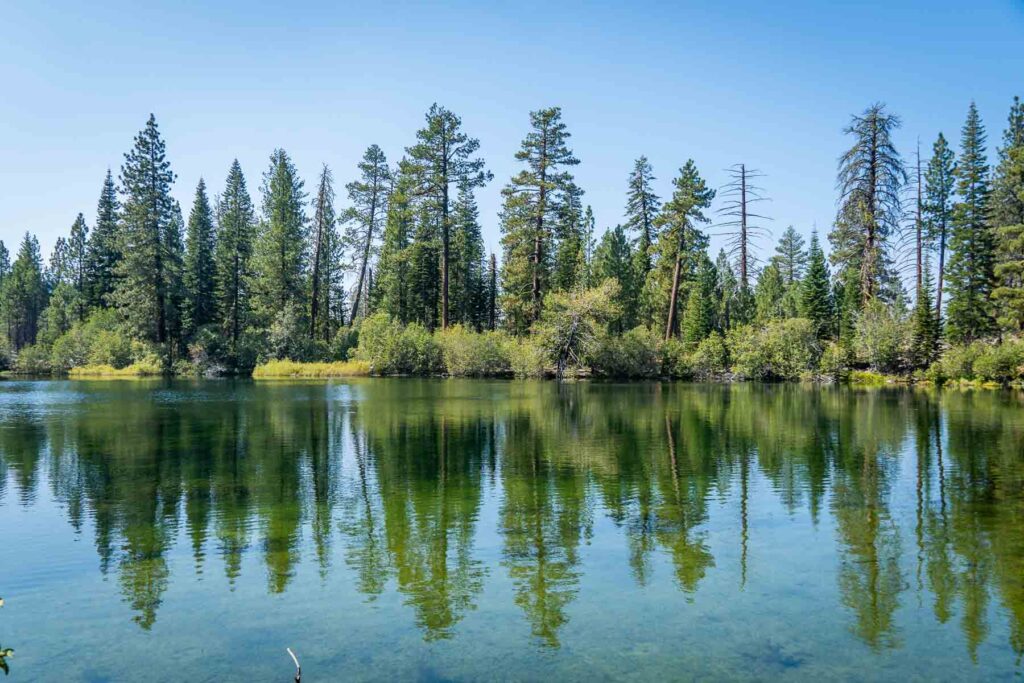
5. Lassen Peak
Lassen Peak is the most famous part of the park, known for its volcanic activity and eruptions in the early 1900s. This volcano, along with Sulphur Works and other hydrothermal areas, are all reminders that this area is still alive and bubbling with geothermal activity.
You can hike to the summit of Lassen Peak via a 5-mile round-trip trail. The hike is pretty challenging and definetly not doable on a day hike unless it is the only thing you plan on doing.
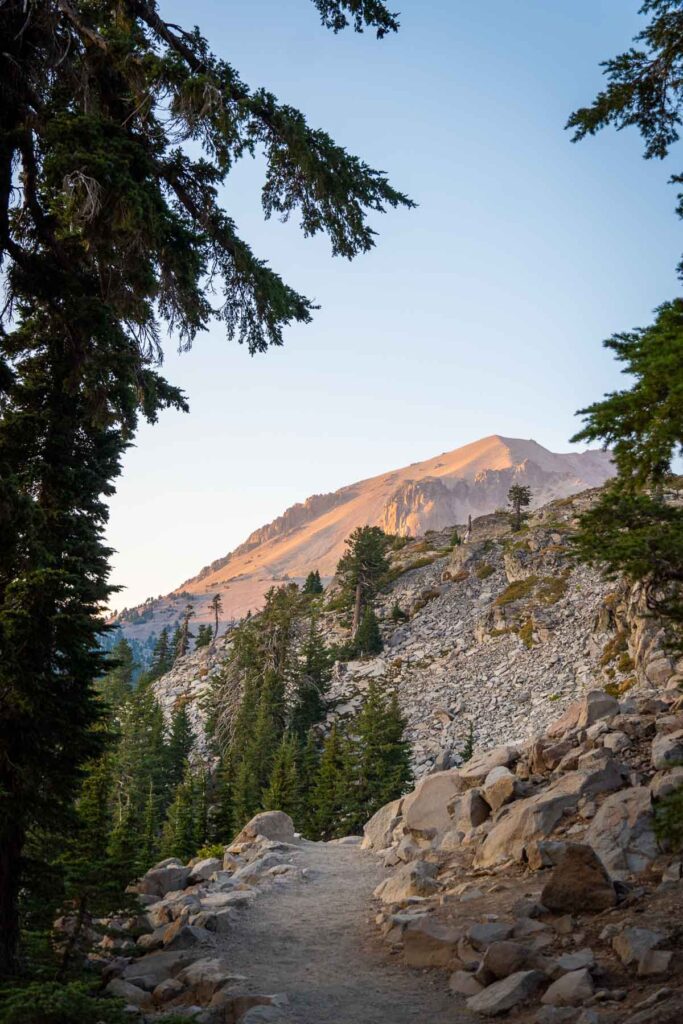
6. Optional: King’s Creek Falls Hike
King’s Creek Falls is a waterfall cascading down over 40 feet of rocky terrain, which is especially mighty in the spring, when the snowmelt feeds the falls.
The trail to King’s Creek Falls is a moderate 2.5-mile round trip hike that takes you through meadows, thick forests, and rocky terrain.
Begin at the King’s Creek Picnic Area, and follow the trailhead sign leading you through the meadow. The trail splits after about a mile, where you can choose between the horse trail or the cascades trail. The horse trail is easier but longer, while the cascades trail is steeper but offers a closer view of the cascading creek. These trails form a loop, so you can do one path each way.
The trail ends at a viewing platform which provides an exquisite view of the waterfall.
But, if you are running low on time, this is not the hike you want to spend time on since there’s still so much to see.
7. Devastated Area Interpretive Trail
In 1915, Mount Lassen erupted and spewed ash and pumice across the surrounding area. This event is now known as the Devastated Area, a stark landscape that showcases how powerful volcanic eruptions can be.
There’s an easy 0.25 trail that takes you through this desolate landscape, with interpretive signs along the way explaining the eruption and its effects on the surrounding environment.
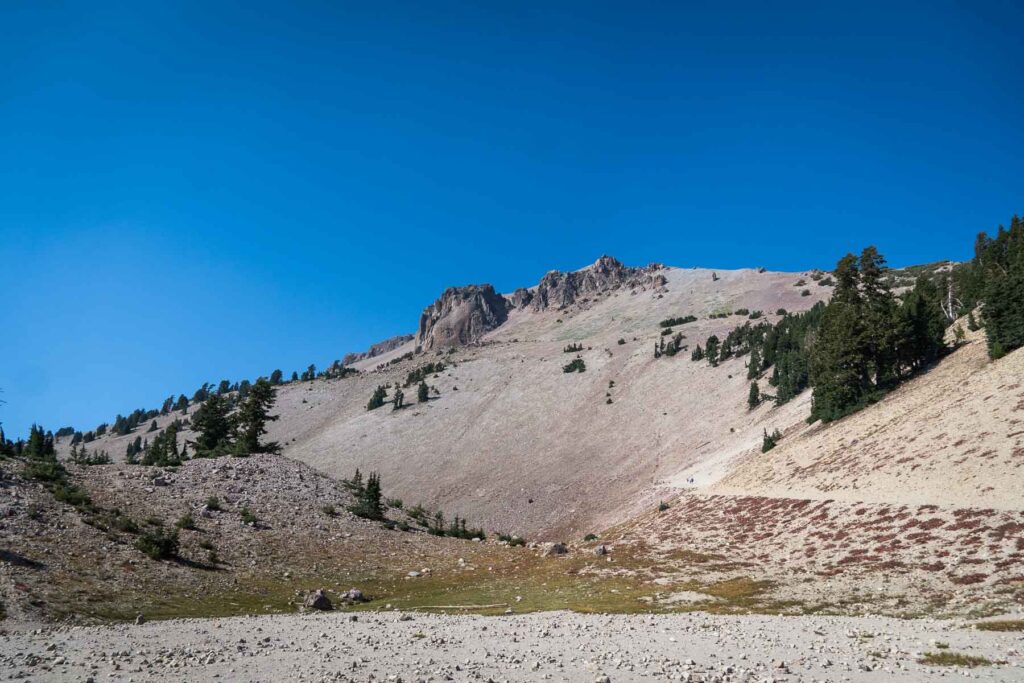
8. Manzanita Lake & Reflection Lake
Last but not least, wrap up your day at Manzanita Lake and Reflection Lake, two lakes ideal for those golden hour photographs.
Manzanita Lake
Manzanita Lake is set alongside Lassen Peak, reflecting on its calm waters. The Lake Loop trail is a relaxing 1.5-mile stroll around the lake, perfect for all fitness levels and accessible year-round.
Bald eagles, American white pelicans, and ospreys are often sighted. Fishing is allowed (catch-and-release only), and you can rent kayaks, canoes, or stand-up paddleboards during the summer.
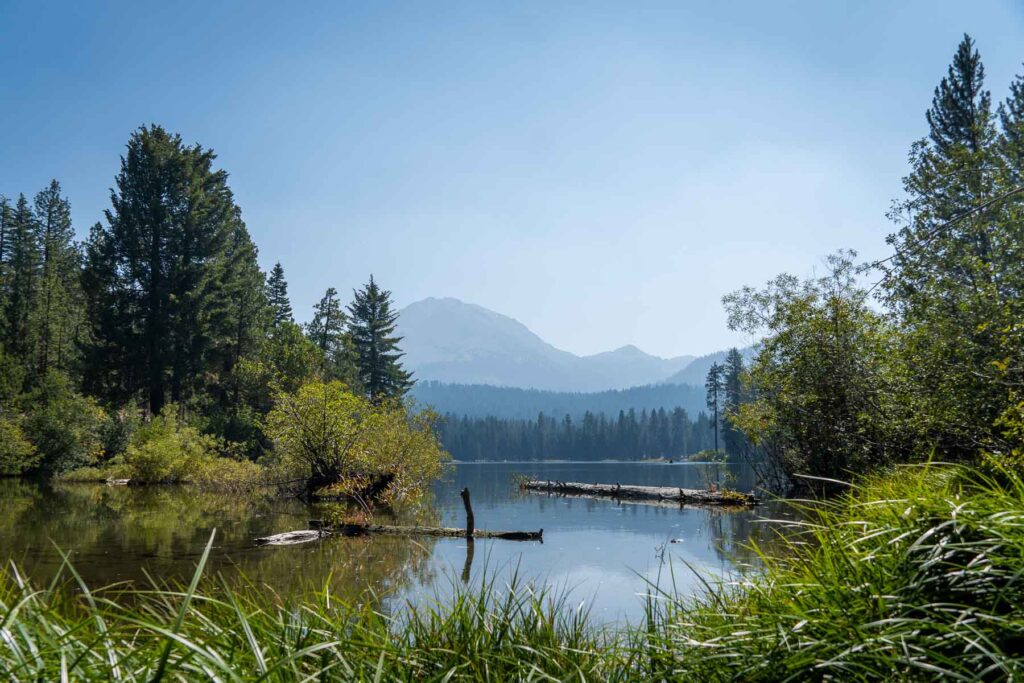
Reflection Lake
Your final stop is Reflection Lake, a small gem with reflections of Lassen Peak and Chaos Crags. It’s just a short walk from the main park road.
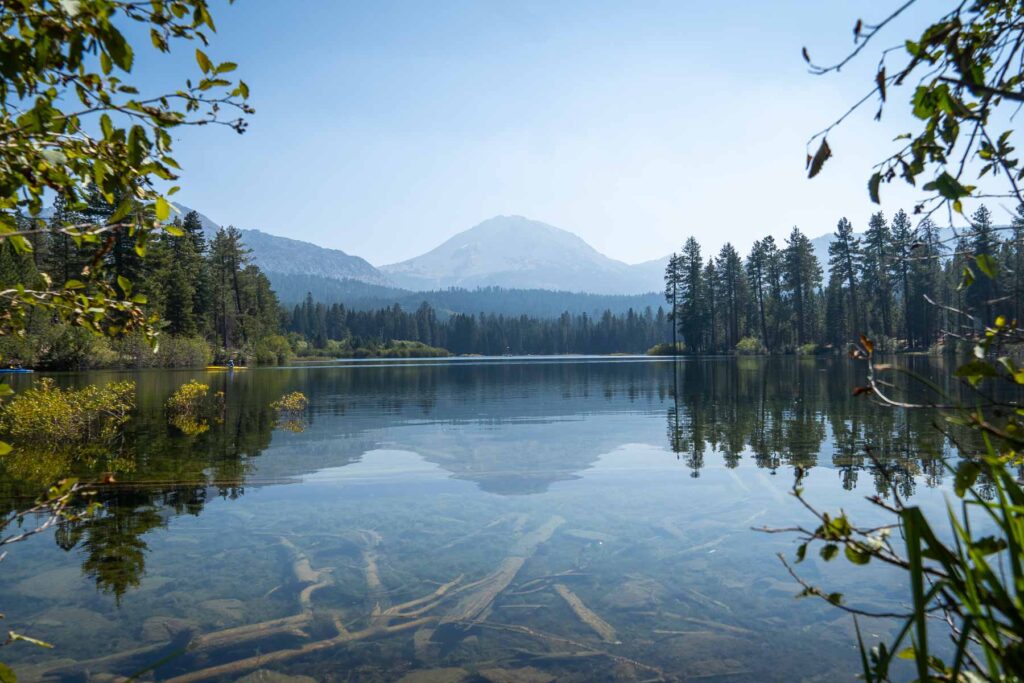
9. Loomis Museum
If it’s not closed yet, tack on a visit to the Loomis Museum, filled with exhibits that delve into the volcanic history of the park, its geology, and its flora and fauna. You’ll find age-old photographs, artifacts, and geological displays, as well as a bookstore.
The museum is located near Manzanita Lake, making it a convenient stop before heading out. It’s open seasonally, so check the park’s website for current hours.
Outside the museum, there’s also a self-guided trail, the Ridge Lakes Loop Trail. This moderate 1.1-mile trail starts and ends at the museum.
Where to Stay in Lassen Volcanic National Park
If you’re planning a visit to Lassen Volcanic National Park, you’ll have several accommodation options. Outside of the national park, Redding is about an hour away, offering a range of hotels and lodges.
Drakesbad Guest Ranch:
Book a room at a beautiful ranch, Drakesbad Guest Ranch . The price per night actually includes meals. With amenities like a swimming pool and hot springs, Drakesbad Guest Ranch is a great choice for those seeking a pampered getaway.
Manzanita Lake Cabins:
If you’re on a budget, the Manzanita Lake Cabins offer a more affordable option. These cozy cabins are in a peaceful forest setting near Manzanita Lake. While the cabins do not have attached bathrooms, there are shared restrooms and showers nearby.
Lassen Volcanic National Park has eight different campsites scattered throughout the park. Camping fees range from $20 to $26 per night, depending on the campsite and the amenities provided.
Travel Tip! Reservations are recommended, especially during the peak summer season.
More Than One Day in Lassen Volcanic National Park
In one day you can see the most accessible parts of the park along the scenic drive. Here are some additional attractions and hikes to consider during a multi-day itinerary :
- Cinder Cone: See views of the Cinder Cone Volcano and the Painted Dunes. The 4-mile round trip hike takes you through a surreal landscape of volcanic ash and colorful volcanic rocks.
- Devil’s Kitchen: This hike leads you to an area filled with mud pots, steam vents, and hot springs.
- Lassen Peak: For a challenging adventure, tackle the hike up Lassen Peak , the tallest volcano in the park. The 5-mile round trip hike rewards you with panoramic views from the summit.
- Burney Falls: Located nearby in McArthur- Burney Falls Memorial State Park, Burney Falls is a beautiful waterfall that cascades 129 feet down into a pool, surrounded by greenery.
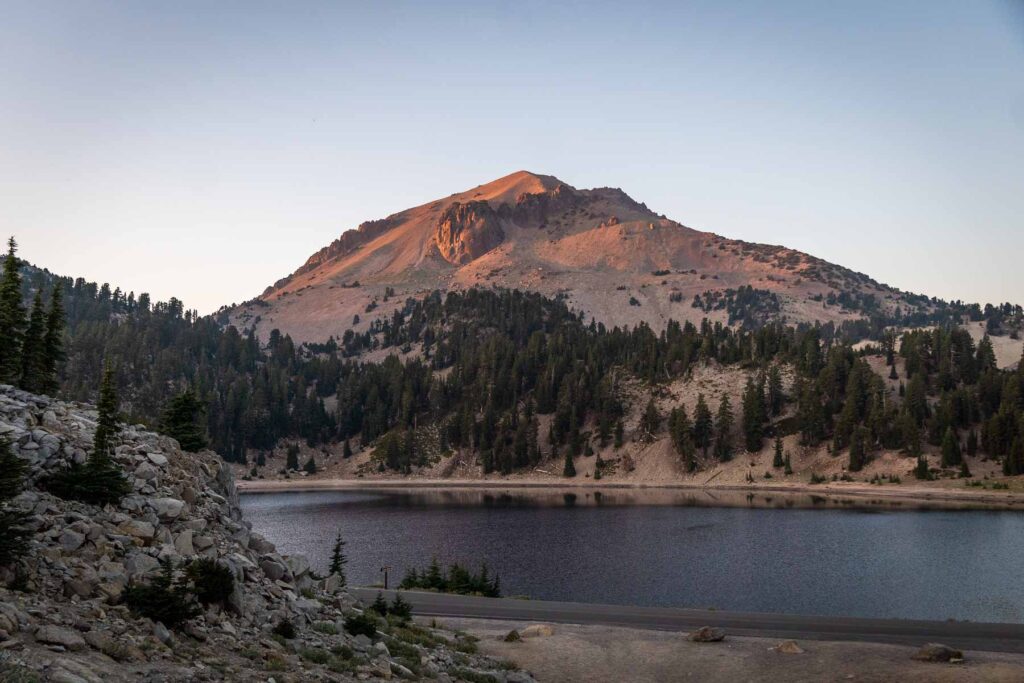
Best Time to Visit
The park is most accessible and enjoyable during the summertime and early fall. This is when all the trails are open and the weather is generally more pleasant outside.
During the winter months, most of the park is closed due to heavy snowfall and road closures.
Getting to Lassen Volcanic
Most people visit Lassen Volcanic as part of a larger California road trip adventure. But, if you’re flying, the closest airport is Redding Municipal Airport . Flights here are limited and can be expensive. If you’re looking for more frequent and affordable flights, fly into Sacramento International Airport or Reno International Airport .
Closest Ariports to fly into
Practical tips for visiting.
When planning your trip to Lassen Volcanic National Park, it’s important to keep a few tips in mind to ensure a safe and enjoyable visit. Here are some helpful tips:
- Stay on designated paths and boardwalks: Lassen Volcanic National Park is home to geothermal activity areas, which can be dangerous. To avoid accidents and severe burns, always stay on designated paths and boardwalks.
- Stay hydrated: Drink plenty of water , especially on longer trails and hiking routes. Carry a refillable water bottle with you.

Final Thoughts: Day Trip to Lassen Volcanic Itinerary
A one-day itinerary to Lassen Volcanic National Park is a fantastic opportunity walk though unique volcanic landscape, stunning lakes, and scenic trails. Hike the famous Bumpass Hell Trail, discover hydrothermal areas, or simply unwind by serene Manzanita Lake.
And if you are on a greater road trip or going to another national park next, check out these other itinerary posts in California.
Before you Close That Tab…Where to Next in California?
I’ve lived and vanlifed around, about, and through all of California for 3 years. If you’re looking for more information on California, check out these other destination itineraries.
- Perfect One Day In Lassen Volcanic National Park Itinerary
- Perfect One Day In Redwood National Park Itinerary
- Perfect One Day In Joshua Tree Itinerary For First-Timers
- One Day In Death Valley Itinerary For Adventurers
- Perfect One Day in San Diego Itinerary: What Not to Miss
- Perfect One Day in San Francisco Itinerary for First Timers
- Day Trip to Lake Tahoe: One Day Itinerary for All Seasons
- Perfect Day Trip to Sonoma Itinerary for Wine Lovers
- Perfect Day Trip to Napa Valley Itinerary for Wine Lovers
- Perfect One Day in Los Angeles Itinerary from a Local

Catherine, a seasoned travel writer, has lived in 4 different states and explored 36 states and 28 national parks. After spending two years embracing van life, she's now dedicated to sharing her vast knowledge of day trips across America. Catherine's other works has been referenced in major publications like MSN, Self, and TripSavvy.
- 9 Must-Try Lake Tahoe Boat Tours to Make Waves and Have a Blast
- First-Timers Can't Miss These 12 Photogenic Things to Do in Grand Teton National Park
- 20 Places In Colorado So Beautiful, They're A Photographer's Dream
- 23 Places in New Mexico So Gorgeous, You’ll Wonder Why You Haven't Visited Yet

IMAGES
VIDEO
COMMENTS
A guide to planning the ultimate one day in Volcanoes National Park itinerary including things to do and where to stay.
Hawaii Volcanoes National Park and Hilo Highlights (5.5 hours) Elite Volcano Hike From Hilo (9 hours) Best Tours from Kona to Hawaii Volcanoes NP: Volcanoes National Park and Kona Coffee Farm (12 hours) Big Island Twilight Volcano and Stargazing Tour (10 am until 11 pm) Additional options for renting a car:
You can't visit Hawaii's Big Island without spending time in the magnificent Hawaii Volcanoes National Park. Here's what to see and do and where to stay.
Have a Plan B before you visit. If there's an eruption, expect increased waits and congestion; consider visiting before sunrise or after sunset for a smoother experience. Visit the Kahuku Unit. Kahuku is never crowded, and open Thursday through Sunday, 8 a.m. to 4 p.m. Kahuku is located on Highway 11 near mile marker 70.5 in Ka'ū ...
The Hawaiian islands are all formed by volcanoes, and you can still see the evidence of this, especially on the youngest Big Island. If you only have one day in Hawaii Volcanoes National Park, this guide will help you see the best of the park in a short timeframe.
Hawaii Volcanoes National Park Itinerary for 1, 2 or half day trips covering all the main attractions - Lava glow viewing, Halemaumau crater views, Best hikes, Lava tubes, Sulphur banks, Chain of Craters Road.
Explore the best Hawaii Volcano National Park Itinerary in our comprehensive guide. Learn about the best time to visit, essential planning tips, and safety precautions. Uncover the wonders of Kīlauea Caldera, the East Rift Zone, and Mauna Loa volcano. Find out how to explore lesser-known attractions, immerse yourself in the park's cultural significance, and make the most of nearby attractions ...
When is the best time to visit Hawai'i Volcanoes National Park? There isn't an especially bad time to visit the park, which sees nearly two million visitors annually. The weather on the Islands doesn't vary much, with temperatures fluctuating between 66-85°F throughout the year. Winter and early spring, though, tend to be rainier and cooler than other times of the year and hurricane ...
How many days to visit Hawaii Volcanoes National Park? While you can visit Volcano National Park Hawaii for a few hours, spending at least a day or two would probably be best.
Planning a trip to Hawaii's Volcanoes National Park? Find out how to make the most of your time, whether you're visiting for 1 or 2 days.
Read this ultimate Hawai'i Volcanoes National Park Guide, where you'll find information on the park's history, the best hikes, and where to camp.
This Hawaiian National Park Is Home to One of the World's Most Active Volcanoes - Here's How to Visit Here's everything you need to know before planning a trip to Hawai'i Volcanoes ...
Here's my guide for making the most of a trip. 1. Prepare for your Hawaii Volcanoes National Park visit. Seeing active lava flow isn't the only aspect of Volcanoes National Park that you can't predict; the fog, vog (volcanic fog or unclear air), mist, and rain move through without much predictability. The National Weather Service may ...
Hawaii Volcanoes National Park: Visitor Guide + Top Attractions The Kīlauea volcano, the most active volcano in the Hawaii Volcanoes National Park, is one of the most active volcanoes in the world and is seen by millions of tourists each year. This makes it the most visited attraction in Hawaiʻi and the most visited volcano in the world.
Volcanoes National Park Itinerary for 2024 Volcanoes National Park is one of the must-see places on your trip to The Big Island. The volcanic landscape and the chance of seeing lava make it unlike anywhere else. But, there are some tricks to making sure you have the best day possible when you visit.
Big Island National Park is also the best place for hiking volcanoes in Hawaii, camping, and bird watching. There are many different trails to explore, and the scenery is simply breathtaking. Whether you're interested in geology or just looking for a beautiful place to spend some time, Big Island National Park is definitely worth a visit.
We've ranked all the best things to do in Hawaii Volcanoes National Park based on our extensive experience filming & photographing the park.
Make the most of your visit to Hawai'i Volcanoes National Park with this adventure guide including best things to do, where to camp, & more.
The Ultimate Volcanoes National Park Travel Guide. A trip to the largest of Hawaii Island's five national and historic parks is a step back in time, a place where two active volcanoes have long ...
Hawaii Volcanoes National Park Best Months: April, May, June & September Hours: Open 24 hours a day, 7 days a week, as well as all holidays Entrance Fee: $30 per vehicle, valid for 7 days Learn More… However, visiting the Hawaii volcanoes doesn't have to be complicated.
Answer 1 of 4: Is it better to visit Volcanoes National Park on a week day rather than a weekend, or doesn't it really make a difference? We aren't traveling until November.
Tips for Visiting Hawai'i Volcanoes National Park During Busy Holiday Season
Things to Do in Lassen Volcanic National Park for a Day. Here are some of the best things to do in Lassen Volcanic National Park during your day trip: 1. Visitor Center & Start the Drive Through the Scenic Loop. Start your day at the Kohm Yah-mah-nee Visitor Center, where you can get a map and collect a National Park stamp.
This quick, five-day getaway to Ecuador showcases Quito and the surrounding central Andes. Start with a local's-eye view of the capital's historic center, then set off into Cotopaxi National Park to explore its sweeping páramo landscapes and famous volcano. Settle into the charming Andean village of Isinliví for mountain horseback rides and hiking, grab a photo op at the turquoise crater ...